
Partnerships for
Climate‐Smart
Commodities Data
Dictionary for
Recipients
February 2023
Version 1.0
USDA is an equal opportunity lender, provider and employer.

Partnerships for Climate‐Smart Commodities Data Dictionary for Recipients
February 2023
Table of Contents
Overview of Reporting Requirements ............................................................................................. 2
Project Summary ......................................................................................................................... 3
Partner Activities ......................................................................................................................... 4
Marketing Activities ..................................................................................................................... 5
Producer Enrollment ................................................................................................................... 6
Field Enrollment .......................................................................................................................... 7
Farm Summary ............................................................................................................................ 8
Field Summary ............................................................................................................................. 9
GHG Benefits ‐ Alternate Modeled ............................................................................................ 10
GHG Benefits ‐ Measured .......................................................................................................... 11
Additional Environmental Benefits ............................................................................................ 12
Supplemental Data Submission ................................................................................................. 13
Data Descriptions .......................................................................................................................... 14
Unique IDs ................................................................................................................................. 14
Project Summary ....................................................................................................................... 15
Partner Activities ....................................................................................................................... 20
Marketing Activities ................................................................................................................... 25
Producer Enrollment ................................................................................................................. 30
Field Enrollment ........................................................................................................................ 38
CSAF Practice Sub‐questions ..................................................................................................... 44
Farm Summary .......................................................................................................................... 45
Field Summary ........................................................................................................................... 49
GHG Benefits ‐ Alternate Modeled ............................................................................................ 57
GHG Benefits ‐ Measured .......................................................................................................... 61
Additional Environmental Benefits ............................................................................................ 65
CSAF Practice Sub‐questions ..................................................................................................... 75
Appendix A: Climate‐smart Agriculture and Forestry Practices .................................................... 83
All NRCS Practice Standards (not limited to climate‐smart practices) ....................................... 83
Other CSAF Practices ................................................................................................................. 85
Appendix B: Commodity List ......................................................................................................... 86

Partnerships for Climate‐Smart Commodities Data Dictionary for Recipients
February 2023
Version 1.0
Page 2 of 87
Overview of Reporting Requirements
Grant recipients are required to submit reports to document their performance under the Partnerships
for Climate‐Smart Commodity funding opportunity. These submissions will be required to use the
Microsoft Excel workbook templates provided by USDA. The workbooks contain a series of worksheets
that collect data in a standardized format to ensure data quality and allow for aggregation and summary
of this information. The entire workbook must be submitted quarterly, with updates to all applicable
worksheets. This guide is divided into three sections. The Overview of Reporting Requirements section
summarizes the layout of the reporting workbook and presents the data elements included in each
worksheet. It also describes additional documents that must be submitted to supplement the
performance reports. The Data Definitions section provides descriptions and allowable response options
for each data element. The guide also indicates whether each data element is required, applicable at
times, or optional; as well as how frequently each data element must be updated. Finally, the
Appendices contain practice and commodity lists that will be used for these reports. Reporting is
necessary for USDA oversight of this effort. The data elements required for inclusion in the quarterly
performance reports allow USDA to conduct selected audits to review whether producers are receiving
federal funds from multiple sources for the same purpose; to determine whether GHG benefits from
implementation of climate‐smart agriculture and forestry (CSAF) practices are being estimated
accurately; and for other purposes deemed appropriate by USDA.
The reporting worksheets collect information at four levels: project, partner, producer, and field.
Descriptions of each level:
Project level: Information about activities and impacts at a whole project/aggregate level (i.e., reflecting
all activities under the grant agreement). Some project‐level reporting is further subdivided by commodity
type or a combination of commodity and CSAF practice(s) (commodity x practice).
Partner level: Information about activities related to a single organization (recipient, subrecipient,
contractor, or other partner) within a project.
Producer level: Information about individual producers who have one or more farms enrolled in a project.
Field level: Information about individual fields enrolled in a project.
Certain data elements are required to be reported for each producer and field enrolled in a project. In
order to minimize the burden associated with data collection and to enable USDA to match data to
existing records, these producer‐ and field‐specific records must use the producer’s established FSA
Farm, Tract and Field IDs, and report the State and County associated with the Farm ID. Associated data
entered in conjunction with these data elements, such as Producer Name, must match the data
contained in the customer’s Business Partner record, and the Farm Operating Plan in Business File for
that Farm ID. Disclosure of this information is protected under Section 1619 of the Food, Conservation,
and Energy Act of 2008 (PL 110‐ 246), 7 U.S.C. 8791. Additionally, Departmental Regulation 4370‐001
provides USDA’s policies for collecting demographic data, including race, ethnicity and gender. Providing
demographic information is voluntary and at the discretion of the customer. Demographic information is
used by USDA for statistical purposes only and will not be used to determine an applicant’s eligibility for
programs or services for which they apply.
Note: For purposes of this guide, “farm” refers to the operation from which climate‐smart commodities are
produced and may represent farms, ranches, forests or other operations. Similarly, “field” refers to the individual
land units at which climate‐smart practices are being implemented to produce climate‐smart commodities and
may represent lots, farmsteads or other units, depending on the type of operation and commodity. The use of
“Farm”, “Tract” and “Field” align with the FSA definitions; for example, “A field is a part of a farm that is separated
from the balance of the farm by a permanent boundary, such as; fences, permanent waterways, woodlands,
croplines in cases where farming practices make it probable that this cropline is not subject to change, and other
similar features.”
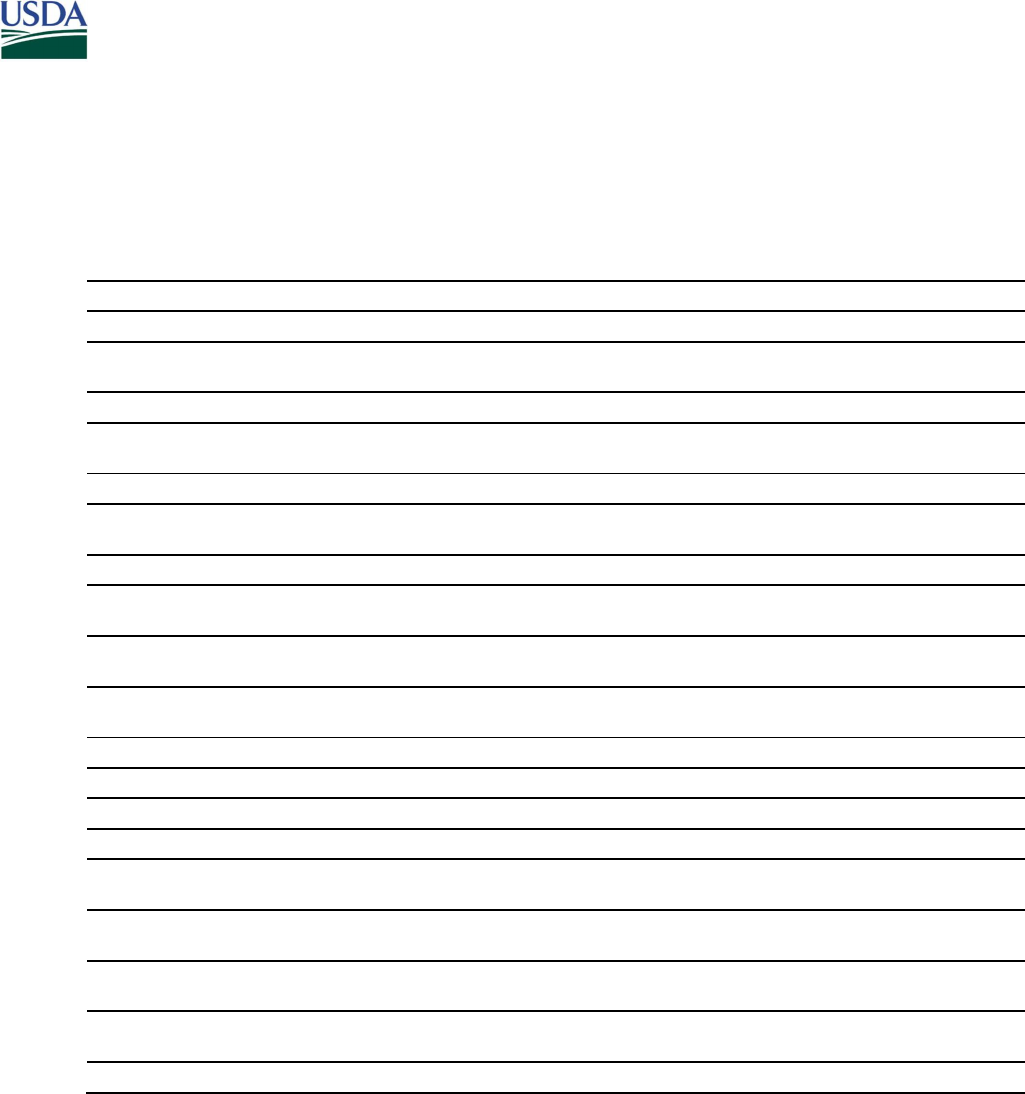
Partnerships for Climate‐Smart Commodities Data Dictionary for Recipients
February 2023
Version 1.0
Page 3 of 87
The following tables list the data elements included in each reporting worksheet, along with a brief
description of each item.
Project Summary
These data will be collected about each project. Cumulative results are reported each quarter. Report last
quarter’s entry if there has been no change in this quarter.
Table 1. Project Summary elements
Data element name
Description
Frequency
Commodity type
Type of commodity(ies) incentivized by the project
Quarterly
Commodity sales
Indicates sales of the commodity(ies) related to the
project occurred this quarter
Quarterly
Farms enrolled
Indicates enrollment activities occurred this quarter
Quarterly
GHG calculation methods
Methods used to calculate greenhouse gas (GHG)
benefits
Quarterly
GHG cumulative calculation
Method used to calculate cumulative GHG benefits
Quarterly
Cumulative GHG benefits
Whole project estimate of total GHG (CO2e) emission
reductions
Quarterly
Cumulative carbon stock
Whole project estimate of total carbon sequestration
Quarterly
Cumulative CO2 benefit
Whole project estimate of total CO2 emission
reductions
Quarterly
Cumulative CH4 benefit
Whole project estimate of total CH4 emission
reductions
Quarterly
Cumulative N2O benefit
Whole project estimate of total N2O emission
reductions
Quarterly
Offsets produced
Amount of carbon offsets produced by project
Quarterly
Offsets sale
Name of marketplace where carbon offsets were sold
Quarterly
Offsets price
Price of carbon in offset sales
Quarterly
Insets produced
Amount of carbon insets produced by project
Quarterly
Cost of on‐farm TA
Cost of on‐farm technical assistance (TA) provided to
producers
Quarterly
MMRV cost
Cost of measurement, monitoring, reporting, and
verification (MMRV) activities
Quarterly
GHG monitoring method
Methods used by project to monitor GHG benefits (up
to 5)
Quarterly
GHG reporting method
Methods used by project to report on GHG benefits (up
to 5)
Quarterly
GHG verification method
Methods used to verify GHG benefits (up to 5)
Quarterly

Partnerships for Climate‐Smart Commodities Data Dictionary for Recipients
February 2023
Version 1.0
Page 4 of 87
Partner Activities
These data will be collected at the project level. Each row in this worksheet will represent one organization
involved in the project, including the recipient and all contributing partners. A partner is any organization that is
receiving project funds or providing matching contributions (funds or in‐kind contributions) to the project. While
the recipient must complete one row for their own organization, not all data elements apply to the recipient.
These exceptions are noted in the detailed descriptions of the specific elements in the Data Definitions section of
this guide. Data are reported cumulatively each quarter. Report last quarter’s entry if there has been no change in
this quarter.
Table 2. Partner Activities elements
Data element name
Description
Frequency
Partner ID
Unique ID for each partner
One‐time
Partner name
Name of partner organization
One‐time
Partner type
Type of organization
One‐time
Partner POC
Partner point of contact name
As applicable
Partner POC email
Partner point of contact email
As applicable
Partnership start date
Start of partnership on project
One‐time
Partnership end date
End of partnership on project
As applicable
New partnership
Indicator for partner organizations that have no prior work with the
recipient
As applicable
Partner total
requested
Total amount requested to date by partner from recipient
Quarterly
Total match
contribution
Total amount of match contribution by partner to date
Quarterly
Total match
incentives
Total amount of match contribution by partner for incentives
Quarterly
Match type
Top 3 types of match contribution by partner, other than incentives
Quarterly
Match amount
Value of match contributions by type
Quarterly
Training provided
Top 3 types of training provided to the partner through project
Quarterly
Activity by partner
Top 3 types of activities provided by this partner to producers or
other partners
Quarterly
Activity cost
Approximate cost per activity type provided by partner to producers
or other partners
Quarterly
Products supplied
Names of products supplied to producers as part of project activities
or incentives
Quarterly
Product source
Supplier or source of products supplied to producers as part of
project activities or incentives
Quarterly
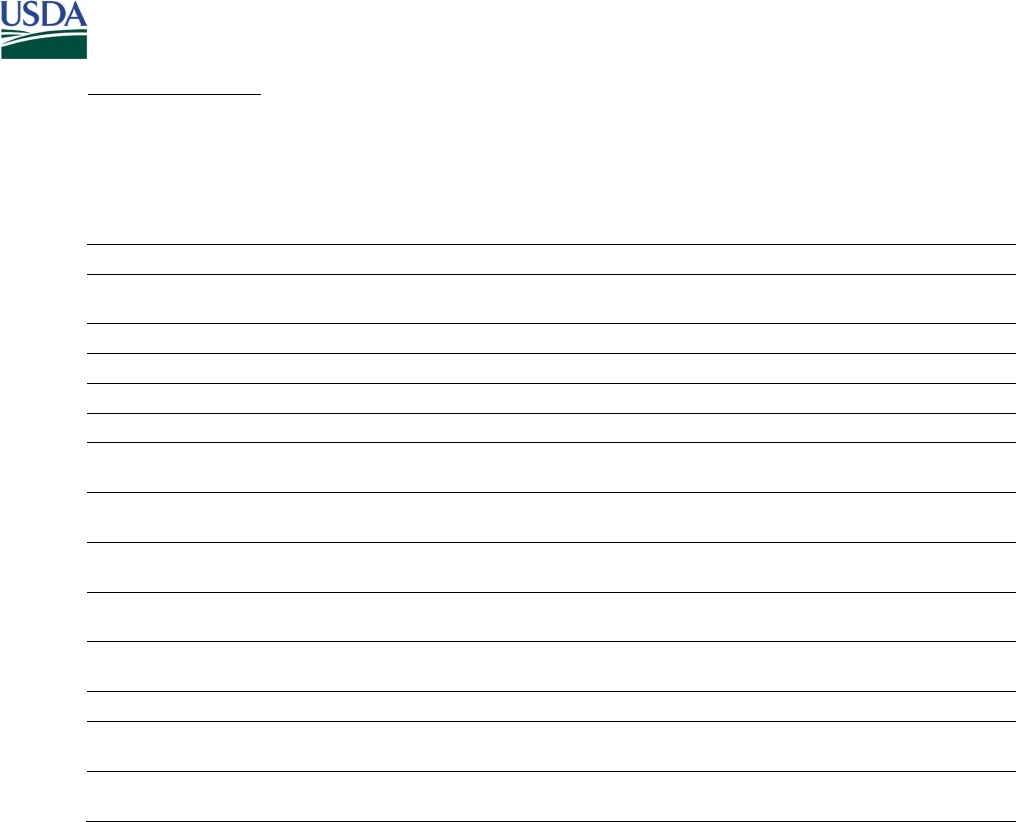
Partnerships for Climate‐Smart Commodities Data Dictionary for Recipients
February 2023
Version 1.0
Page 5 of 87
Marketing Activities
These data will be collected at the project level. Each row in this worksheet will correspond to one commodity for
which the project enrolls fields and one marketing channel used to sell that commodity by the project or producers
enrolled in the project. Data are reported for the current quarter and are not cumulative. If no sales of the
commodity were reported during a quarter, do not complete this worksheet for that quarter.
Table 3. Marketing Activities elements
Data element name
Description
Frequency
Commodity type
Type of commodity incentivized by the
project
Quarterly
Marketing channel type
Type of marketing channels used
Quarterly
Number of buyers
Number of buyers per marketing channel
Quarterly
Names of buyers
Names of buyers in the marketing channel
Quarterly
Marketing channel geography
Geography of marketing channel
Quarterly
Value sold
Value of commodity sold by marketing
channel
Quarterly
Volume sold
Volume of commodity sold by marketing
channel
Quarterly
Price premium
Price premium of commodity by
marketing channel
Quarterly
Price premium to producer
Percent of price premium that goes to the
producer
Quarterly
Product differentiation method
Top 3 types of product differentiation
methods used
Quarterly
Marketing method
Top 3 types of marketing methods used
Quarterly
Marketing channel identification method
Top 3 ways marketing channel was
identified
Quarterly
Traceability method
Top 3 types of supply chain traceability
methods used
Quarterly
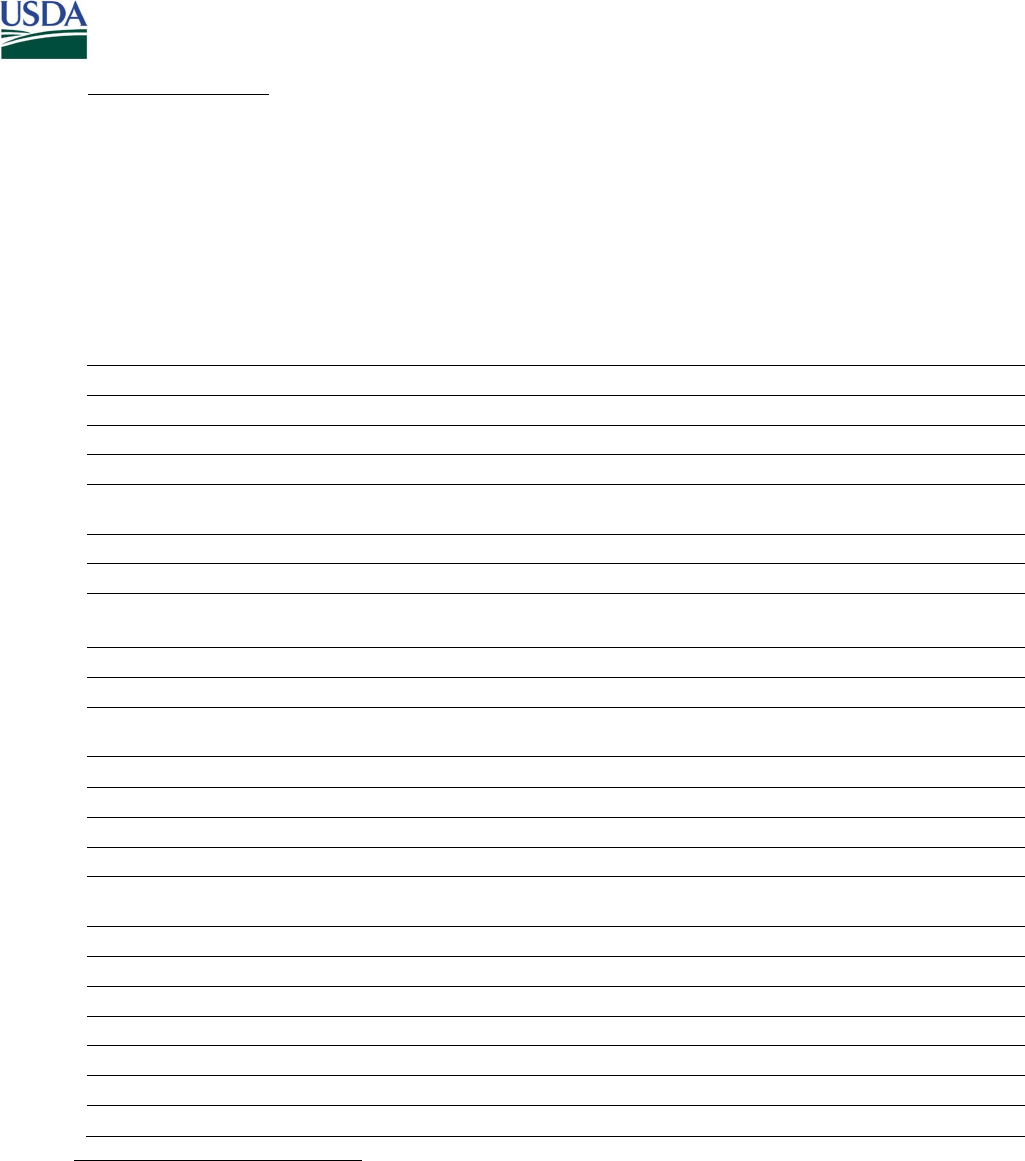
Partnerships for Climate‐Smart Commodities Data Dictionary for Recipients
February 2023
Version 1.0
Page 6 of 87
Producer Enrollment
These data will be collected at the producer level about each farm enrolled in the project. In this
worksheet, each row will correspond to one farm that has at least one field enrolled in the project. Data
are reported when a producer first enrolls one or more fields in the project. If a producer is enrolled in
the project for multiple years, review the farm characteristics each time a new contract is signed and
provide any necessary updates. The quarterly submission should contain information about each farm
initially enrolled in the project during that quarter and for updates to farms that have re‐enrolled during
that quarter, as applicable. If no farms are enrolled during that quarter, do not complete this worksheet
for that quarter.
Table 4. Producer Enrollment elements
Data element name
Description
Frequency
Farm ID
Unique Farm ID assigned by FSA
State or territory
State name (must match FSA farm enrollment data)
County of residence
County name (must match FSA farm enrollment data)
Producer data change
Indicator that producer data was updated at re‐enrollment
As
applicable
Producer start date
Contract start date
Enrollment
Producer name
Name of primary operator
Enrollment
Underserved status
Indicator the primary operator is considered underserved and/or a
small producer
Enrollment
Total area
Total area of enrolled operation
Annual
Total crop area
Total crop area in enrolled operation enrolled
Annual
Total livestock area
Total livestock confinement, pasture and rangeland in enrolled
operation
Annual
Total forest area
Total forest area in enrolled operation
Annual
Livestock type
Top 3 types of livestock on enrolled operation
Annual
Livestock head
Total livestock currently managed (by type)
Annual
Organic farm
Indicator that part of the farm is certified or transitioning organic
Annual
Organic fields
Indicator that any of the enrolled fields are certified or transitioning
organic
Annual
Producer motivation
Motivation for participation
Annual
Producer outreach
Top 3 types of outreach provided to producer
Annual
CSAF experience
Indicator of prior implementation of CSAF practices at this farm
Annual
CSAF federal funds
Indicator of prior receipt of federal funds for CSAF practices
Annual
CSAF state or local funds
Indicator of prior receipt of state funds for CSAF practices
Annual
CSAF nonprofit funds
Indicator of prior receipt of nonprofit funds for CSAF practices
Annual
CSAF market incentives
Indicator of prior receipt of market incentives for CSAF practices
Annual

Partnerships for Climate‐Smart Commodities Data Dictionary for Recipients
February 2023
Version 1.0
Page 7 of 87
Field Enrollment
These data will be collected about each field enrolled in the project. In this worksheet, each row
corresponds to one field x commodity combination enrolled in the project. Generally, data are reported
once for each field, at its initial enrollment. The quarterly submission should contain information about
each field initially enrolled in the project during that quarter. If no fields are enrolled during that
quarter, do not complete this worksheet for that quarter. If a field is enrolled for multiple years, any
relevant changes, such as a new ID number or changes to the commodity or practice combinations
should be entered in this worksheet during the quarter it is re‐enrolled, or as applicable.
Table 5. Field Enrollment elements
Data element name
Description
Farm ID
Unique Farm ID assigned by FSA
Tract ID
Unique Tract ID assigned by FSA
Field ID
Unique Field ID assigned by FSA
State or territory of field
State name
Physical County of field
Physical county name must match FSA farm records
Prior Field ID
Previous Field ID when reconstitution of farm results
in new Field IDs
Field data change
Indicator that field data has changed from initial
enrollment
Contract start date
Start date of contract
Total field area
Size of enrolled field
Commodity category
Category of commodity(ies) produced
Commodity type
Type of commodity(ies) produced
Baseline yield
Average yield of commodity in 3 years prior to
enrollment
Baseline yield location
Location for which baseline yield is provided
Field land use
Most common land use in field in past 3 years
Field irrigated
Most common irrigation type in field in past 3 years
Field tillage
Most common tillage in field in past 3 years
Practice past extent ‐ farm
Extent of operation that implemented this practice prior
to project enrollment
Field any CSAF practice
Indicator for prior CSAF practices in this field in past
3 years
Practice past use ‐ this field
Indicator of prior use of this practice in this field in
the past 3 years
Practice type
CSAF practice(s) that will be
implemented in enrolled field (up to
7)
Practice standard
Organization that developed CSAF practice standard
implemented in field
Planned practice implementation year
Year that practice is planned to be implemented
Practice extent
Area or number of animals for which practice is
implemented
Follow‐on questions
Follow‐on questions by practice type (see Table 11)
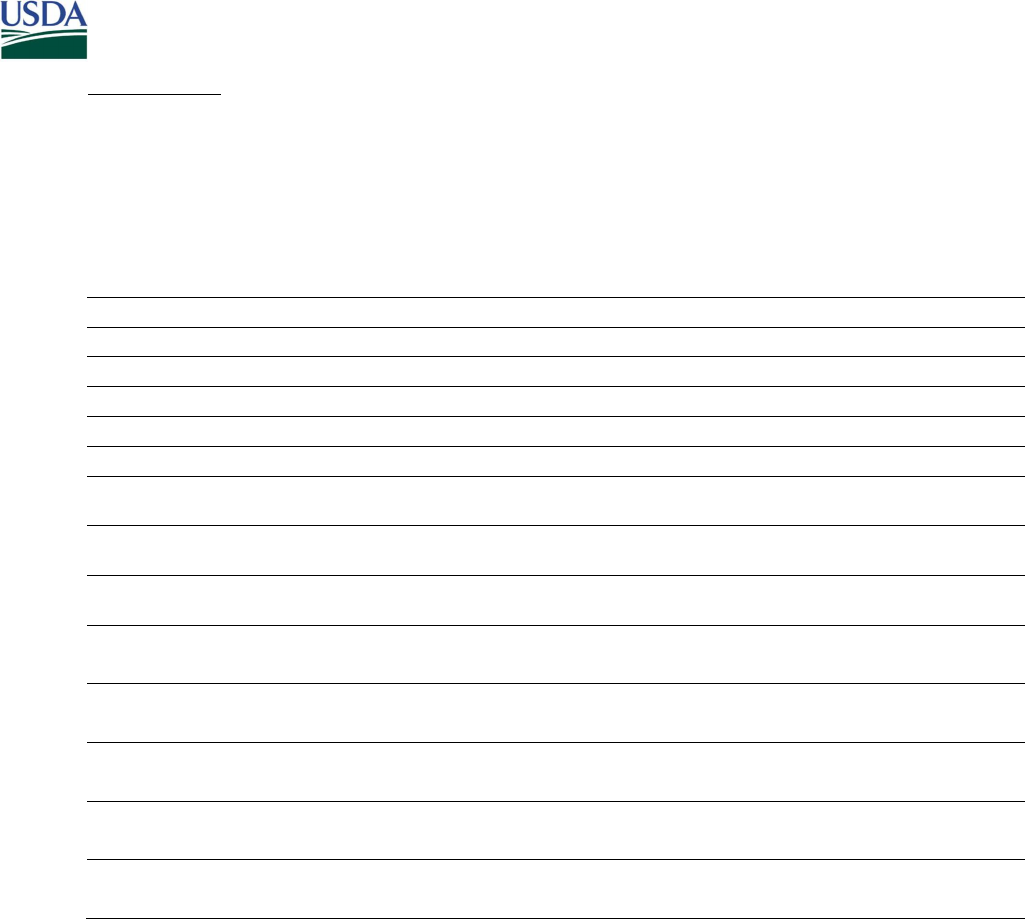
Partnerships for Climate‐Smart Commodities Data Dictionary for Recipients
February 2023
Version 1.0
Page 8 of 87
Farm Summary
These data will be collected about each farm enrolled in the project. In this worksheet, each row will
correspond to one farm that has at least one field enrolled in the project. The quarterly submission
should contain updates to any data elements that have changed for each farm enrolled in the project
during that quarter. If there are no changes from the previous quarter, do not complete this worksheet
for that quarter. Data are not cumulative.
Table 6. Farm Summary elements
Data element name
Description
Frequency
Farm ID
Unique Farm ID assigned by FSA
State or territory
State name
County of residence
County name
Producer TA received
Type of technical assistance provided to producer
Quarterly
Producer incentive amount
Total financial incentive provided to the producer
Quarterly
Incentive reason
Top 4 reason(s) for financial incentives provided to
producer
Quarterly
Incentive structure
Top 4 units on which financial incentives are
structured
Quarterly
Incentive type
Top 4 type(s) of financial incentives provided to
producer
Quarterly
Payment on enrollment
Extent of payment provided to producer upon
Quarterly
enrollment
Payment on implementation
Extent of payment provided to producer upon
Quarterly
implementation of CSAF practices
Payment on harvest
Extent of payment provided to producer upon
Quarterly
harvest or slaughter
Payment on MMRV
Extent of payment provided to producer upon
Quarterly
reporting or verification
Payment on sale
Extent of payment provided to producer upon
Quarterly
sale of commodity
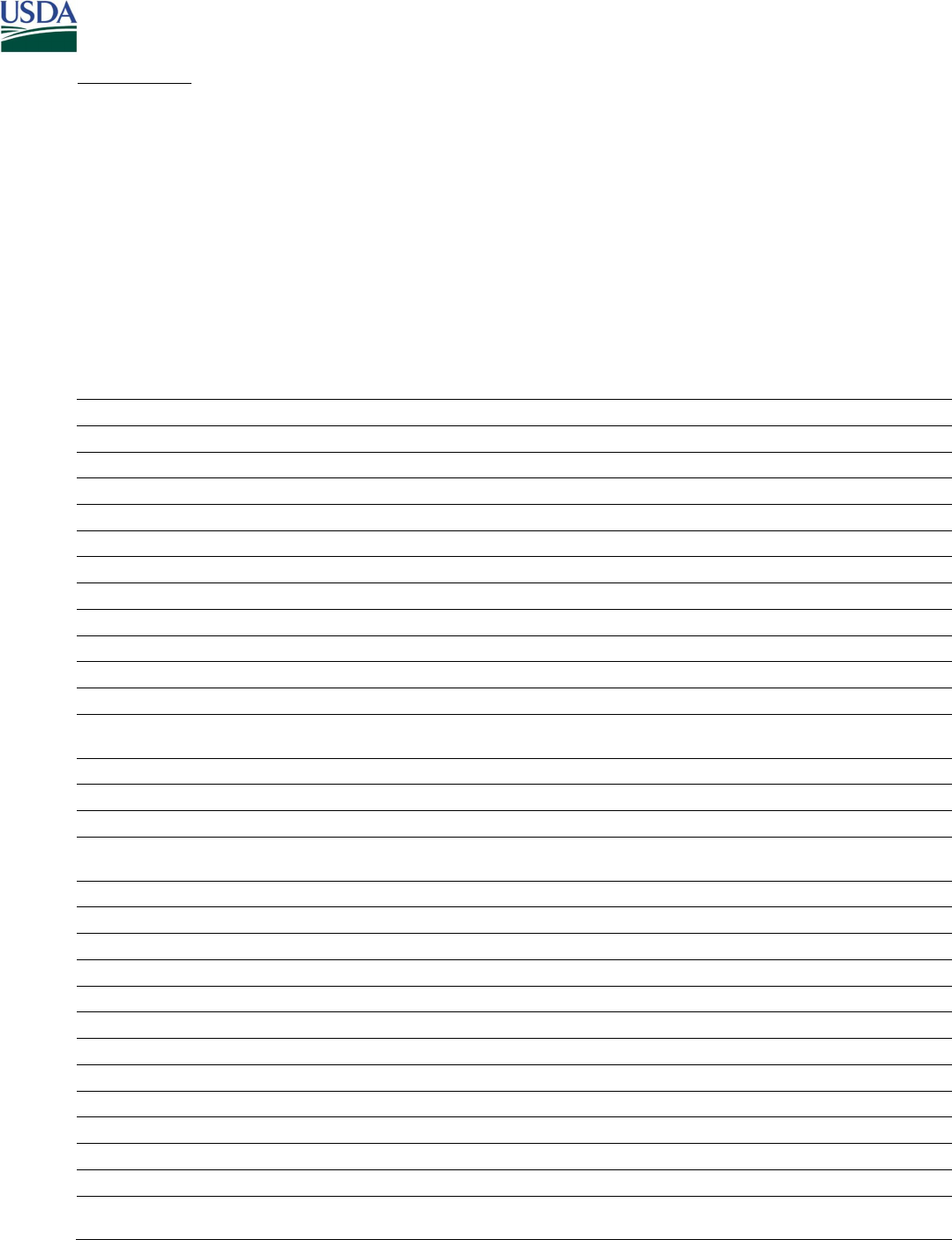
Partnerships for Climate‐Smart Commodities Data Dictionary for Recipients
February 2023
Version 1.0
Page 9 of 87
Field Summary
These data will be collected about each field enrolled in the project for a commodity x practice(s)
combination. In this worksheet, each row will correspond to one field x commodity x practice(s)
combination enrolled in the project. Data for each field will be reported quarterly and are not
cumulative. Report data for any elements that have an update in that quarter. Greenhouse gas benefit
estimates must be entered upon practice completion or annually, as appropriate. If there are no
changes from the previous quarter, do not complete this worksheet for that quarter. This worksheet
includes a section to report the “official” estimate of GHG benefits – amounts of greenhouse gas
emissions reduced and carbon sequestered – for the field. These quantities refer to the estimates that
are used to calculate the project’s aggregate impact (reported in Table 1). Tables 8 and 9 are used to
report alternate estimates of the field‐level GHG benefits when additional methods are used to model
(Table 8) or measure (Table 9) these impacts. Any field that can use COMET‐Planner must submit those
results, either as the official or alternate model.
Table 7. Field Summary elements
Data element name
Description
Frequency
Farm ID
Unique Farm ID assigned by FSA
Tract ID
Unique Tract ID assigned by FSA
Field ID
Unique Field ID assigned by FSA
State or territory of field
State name
County of field
County name
Commodity type
Type of commodity produced from field
Quarterly
Practice type
Type of practice(s) incentivized in field (up to seven)
Quarterly
Date practice complete
Date that practice implementation is certified complete
Quarterly
Contract end date
End date of contract
Quarterly
MMRV assistance provided
Indicator that MMRV assistance is provided to field
Quarterly
Marketing assistance provided
Indicator that marketing assistance provided for commodity from field
Quarterly
Incentive per acre or head
Indicator that a per acre/head incentives is provided for the CSAF
practice(s) on this field
Quarterly
Field commodity value
Value of commodity produced from field
Quarterly
Field commodity volume
Volume of commodity produced from field
Quarterly
Cost of implementation
Total cost of practice implementation in field
Quarterly
Cost coverage
Percent of total cost of implementation of practice covered by project
incentives
Quarterly
Field GHG monitoring
Methods used to monitor GHG benefits in field (up to 3)
Quarterly
Field GHG reporting
Methods used to report on GHG benefits for field (up to 3)
Quarterly
Field GHG verification
Methods used to verify GHG benefits for field (up to 3)
Quarterly
Field GHG calculations
Methods used to calculate GHG benefits for field
Quarterly
Field official GHG calculation
Method used to calculate official GHG benefits for field
Quarterly
Field official GHG ER
Official estimate of total GHG emission reductions for field
Quarterly
Field official carbon stock
Official estimate of total carbon sequestration for field
Quarterly
Field official CO2 ER
Official estimate of total CO2 emission reductions for field
Quarterly
Field official CH4 ER
Official estimate of total CH4 emission reductions for field
Quarterly
Field official N2O ER
Official estimate of total N2O emission reductions for field
Quarterly
Field offsets produced
Amount of carbon offsets produced in field
Quarterly
Field insets produced
Amount of carbon insets produced in field
Quarterly
Other field measurements
Indicator that field data was collected for reasons other than GHG
benefit estimation
Quarterly
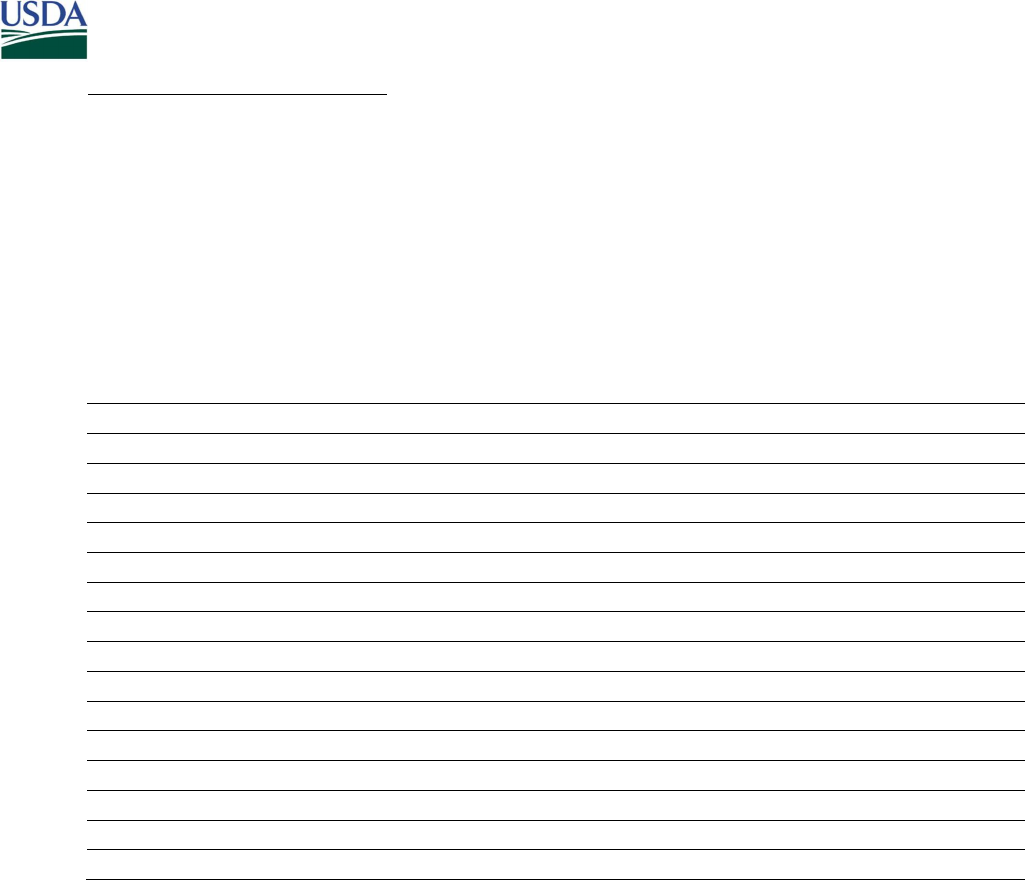
Partnerships for Climate‐Smart Commodities Data Dictionary for Recipients
February 2023
Version 1.0
Page 10 of 87
GHG Benefits ‐ Alternate Modeled
If greenhouse gas benefits are modeled for the same field using multiple methods, the results for the
alternate models are reported in this worksheet. The “alternate” models refer to those model results
that were not used in the calculation of the project’s aggregate impact (as reported in Table 1). Any field
that can use COMET‐Planner must submit those results, either as the official or alternate model. These
data will be collected about the modeled GHG benefits for each field x commodity x practice(s)
combination. In this worksheet, each row will correspond to one field enrolled in the project. Data are
not cumulative. Each quarterly submission should include information for all fields that have new
modeled data. Greenhouse gas benefit estimates must be entered upon practice completion or
annually, as appropriate.
Table 8. GHG Benefits – Alternate Modeled elements
Data element name
Description
Frequency
Farm ID
Unique Farm ID assigned by FSA
Tract ID
Unique Tract ID assigned by FSA
Field ID
Unique Field ID assigned by FSA
State or territory of field
State name
County of field
County name
Commodity type
Type of commodity(ies) produced from the field (up to 6)
Annual
Practice type
Type of practice(s) incentivized in field (up to 7)
Annual
GHG model
Model used to calculate GHG benefits
Annual
Model start date
Start date of model run
Annual
Model end date
End date of model run
Annual
Total GHG benefits estimated
Estimate of total GHG benefits for field
Annual
Total carbon stock estimated
Estimate of total change in carbon stock for field
Annual
Total CO2 estimated
Estimate of total CO2 emission reductions for field
Annual
Total CH4 estimated
Estimate of total CH4 emission reductions for field
Annual
Total N2O estimated
Estimate of total N2O emission reductions for field
Annual
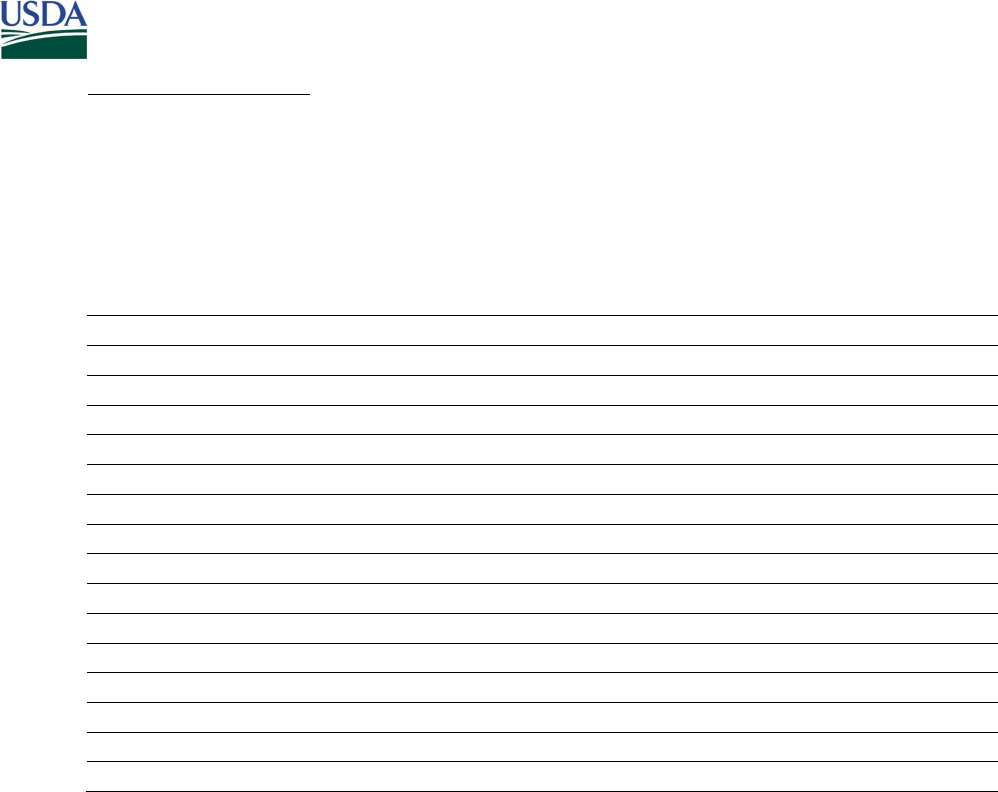
Partnerships for Climate‐Smart Commodities Data Dictionary for Recipients
February 2023
Version 1.0
Page 11 of 87
GHG Benefits ‐ Measured
Projects must report the results of any carbon stock or greenhouse gas emission measurements in this
worksheet. These data will be collected at the field level. Each row will represent a separate
measurement method used to calculate GHG benefits for a given field. Data are reported once per year
of measurement and are not cumulative. Each quarterly submission should include information for any
field for which there are new soil samples or new calculations of annual GHG benefits based on actual
measurements.
Table 9. GHG Benefits ‐ Measured data elements
Data element name
Description
Frequency
Farm ID
Unique Farm ID assigned by FSA
Tract ID
Unique Tract ID assigned by FSA
Field ID
Unique Field ID assigned by FSA
State
State name
County
County name
GHG measurement method
Method of measurement
Annual
Lab name
Entity that conducted analysis
Annual
Measurement start date
Start date of measurements
Annual
Measurement end date
End date of measurements
Annual
Total CO2 reduction calculated
Calculation of total CO2 reduction
Annual
Total carbon stock change calculated
Calculation of change in carbon stock
Annual
Total CH4 reduction calculated
Calculation of total CH4 reduction
Annual
Total N2O reduction calculated
Calculation of total N2O reduction
Annual
Soil sample result
Numeric result from soil sample
Annual
Measurement type
Type of analysis conducted
Annual
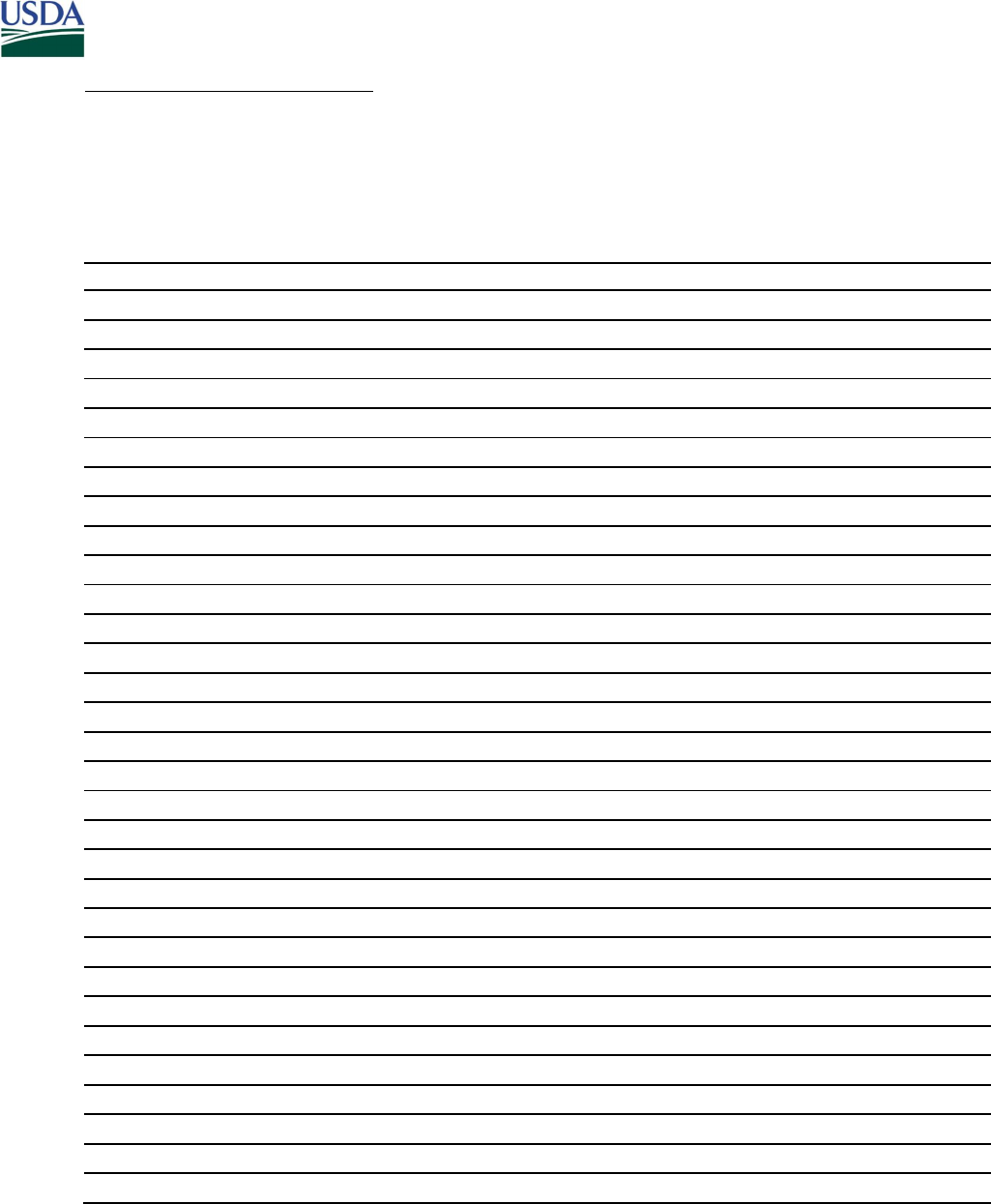
Partnerships for Climate‐Smart Commodities Data Dictionary for Recipients
February 2023
Version 1.0
Page 12 of 87
Additional Environmental Benefits
Projects that track additional environmental benefits (e.g., water quality improvements) from enrolled
fields report results in this worksheet. These data will be collected about each field. Each row in this
worksheet will correspond to an enrolled field. Data are not cumulative. Estimates of environmental
benefits must be entered upon practice completion or annually, as appropriate.
Table 10. Additional Environmental Benefits elements
Data element name
Description
Frequency
Farm ID
Unique Farm ID assigned by FSA
Tract ID
Unique Tract ID assigned by FSA
Field ID
Unique Field ID assigned by FSA
State
State name
County
County name
Environmental benefits
Indicator that project tracks other environmental benefits
Annual
Reduction in nitrogen loss
Indicator that project tracks reductions in nitrogen loss
Annual
Amount
Amount
Annual
Purpose
Purpose of tracking those co‐benefits
Annual
Reduction in phosphorus loss
Indicator that project tracks reductions in phosphorus loss
Annual
Amount
Amount
Annual
Purpose
Purpose of tracking those co‐benefits
Annual
Other water quality
Indicator that project tracks other water quality improvements
Annual
Type
Type of water quality metric being tracked
Annual
Amount
Amount
Annual
Purpose
Purpose of tracking those co‐benefits
Annual
Water quantity
Indicator that project tracks reduced water use
Annual
Amount
Amount
Annual
Purpose
Purpose of tracking those co‐benefits
Annual
Reduced erosion
Indicator that project tracks reductions in soil erosion
Annual
Amount
Amount
Annual
Purpose
Purpose of tracking those co‐benefits
Annual
Reduced energy use
Indicator that project tracks reductions in energy use
Annual
Amount
Amount
Annual
Purpose
Purpose of tracking those co‐benefits
Annual
Avoided land conversion
Indicator that project tracks reductions in land conversion
Annual
Amount
Amount
Annual
Purpose
Purpose of tracking those co‐benefits
Annual
Improved wildlife habitat
Indicator that project tracks improvements in wildlife habitat
Annual
Amount
Amount
Annual
Purpose
Purpose of tracking those co‐benefits
Annual

Partnerships for Climate‐Smart Commodities Data Dictionary for Recipients
February 2023
Version 1.0
Page 13 of 87
Supplemental Data Submission
Project MMRV Plan
Definition of MMRV elements:
Measurement: Quantification of the greenhouse gas benefits (reduction or capture) using mathematical models
and/or direct physical measurements in the field
Monitoring: Ongoing review and confirmation that the climate‐smart practice has been implemented according to
the agreed upon standard and documentation of any changes in the site, implementation, or GHG emissions
impacts over time
Reporting: Documenting and sharing monitoring and measurement results with project partners, the recipient,
and any third‐party verification organization
Verification: Independent confirmation that measurement, monitoring and reporting information are complete,
accurate and reliable.
Projects must submit an MMRV plan that includes details about how each of the following are addressed:
· Quantification approach, including:
o GHG models used
o GHG measurement plan (if applicable)
o Approach to quantifying additional environmental benefits, if applicable (e.g., water quality,
habitat)
· Verification approach:
o Compliance criteria
o Verification plan/methodology
· Approach to ensuring:
o Additionality
o Permanence
o Leakage
o Impacts of weather
· Plan for non‐compliance
If the project is using a specific MMRV methodology or approach developed by the recipient, a project partner, or
an outside organization, the project can submit documentation associated with the methodology as long as the
documentation addresses each of the above categories.
If the project is tracking other environmental benefits (as reported in the Additional Environmental Benefits
worksheet), include a description of the methodology and tools used to track and report on these benefits.
Field modeled GHG benefit reports
Results from any models besides COMET‐Planner used to estimate GHG benefits must also be submitted as a
separate report. This includes projects running COMET‐Farm. The full results of any model can be submitted in the
native/standard format generated by the modeling tool and must include the following Unique IDs in the report or
in the file name: State, County, Farm ID, Tract ID, Field ID.
Field direct measurement results
For any direct physical measurements in the field, measurement results must be submitted as a separate report
and must include the following Unique IDs in the report or in the file name: State, County, Farm ID, Tract ID, Field
ID. Measurement results reports must include the name of the equipment used for sampling or data collection, the
name of the lab that analyzed the data, and the analytical method used.
Sample report types include soil analysis reports, summarized results of portable emissions analyzers or flux
towers, water quality analyses, and plant species counts. These could be collected for the purposes of determining
GHG emission reductions or carbon sequestration amounts, for calibration of tools or models, for tracking other
environmental benefits, or for other reasons.
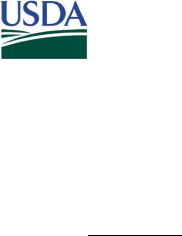
Partnerships for Climate‐Smart Commodities Data Dictionary for Recipients
February 2023
Version 1.0
Page 14 of 87
Data Descriptions
This section provides descriptions and allowable response options for each data element. The guide also
indicates whether each data element is required, applicable at times, or optional; as well as how
frequently each data element must be updated.
Unique IDs
Project ID: Unique ID at the project level – “Award Identifying Number” shown on award documentation
Partner ID: Unique ID at the partner level – use EIN; if no EIN, a unique ID will be assigned for use in these reports
State or territory of operation: State or territory name
County of operation: Physical county name
Farm ID: Unique ID at the operation level assigned by Farm Service Agency (FSA)
Tract ID: Unique ID at the tract level assigned by FSA
Field ID: Unique ID at the field level assigned by FSA

Partnerships for Climate‐Smart Commodities Data Dictionary for Recipients
February 2023
Version 1.0
Page 15 of 87
Project Summary
Commodity type
Data element name: Commodity type Reporting question: What climate‐smart commodity types are
produced by this project?
Description: Type of commodity incentivized by the project. These commodities include those for whom
farmers are directly receiving incentives or other types of marketing support. See full list of commodity options
in Appendix B. List one commodity per row.
Data type: List Select multiple values: No
Measurement unit: Category Allowed values: FSA commodity list
Logic: None – all respond Required: Yes
Data collection level: Project Data collection frequency: Quarterly
Commodity sales
Data element name: Commodity sales Reporting question: Did project activities result in sales this
quarter of the commodity(ies) produced by this project?
Description: Indicator of sales of commodity(ies) related to project activities. If sales are reported, complete the
Marketing Activities worksheet (Table 3) as part of the quarterly performance report.
Data type: List Select multiple values: No
Measurement unit: Category Allowed values:
· Yes
· No
Logic: None – all respond Required: Yes
Data collection level: Project Data collection frequency: Quarterly
Farms enrolled
Data element name: Farms enrolled Reporting question: Did the project enroll any producers or
fields this quarter?
Description: Indicator that the project enrolled producers or fields. If enrollment activities occurred this quarter,
complete the Producer Enrollment and Field Enrollment worksheets (Tables 4 and 5) as part of the quarterly
performance report.
Data type: List Select multiple values: No
Measurement unit: Category Allowed values:
· Yes
· No
Logic: None – all respond Required: Yes
Data collection level: Project Data collection frequency: Quarterly
GHG calculation methods
Data element name: GHG calculation
methods
Reporting question: What methods is the project using to
calculate GHG benefits?
Description: List the way(s) that GHG benefits are being measured and calculated by the project this quarter.
Data type: List Select multiple values: No
Measurement unit: Category Allowed values:
·
Models
·
Direct field measurements
·
Both
Logic: None – all respond Required: Yes
Data collection level: Project Data collection frequency: Quarterly

Partnerships for Climate‐Smart Commodities Data Dictionary for Recipients
February 2023
Version 1.0
Page 16 of 87
GHG cumulative calculation
Data element name: GHG cumulative
calculation
Reporting question: What method(s) was used to calculate the
total cumulative GHG benefits reported here?
Description: List the method(s) that was used to calculate the total cumulative GHG benefits reported by the
project this quarter.
Data type: List Select multiple values: No
Measurement unit: Category Allowed values:
·
Models
·
Direct field measurements
·
Both
Logic: None – all respond Required: Yes
Data collection level: Project Data collection frequency: Quarterly
Cumulative GHG benefits
Data element name: Cumulative GHG
benefits
Reporting question: What are the project’s estimated total GHG
emission reductions (CO2eq) to date?
Description: Total cumulative estimated greenhouse gas emission reductions from practice implementation.
This is updated quarterly. If there are no changes, enter the same number as the previous quarter.
Data type: Decimal Select multiple values: No
Measurement unit: Metric tons CO
2
eq Allowed values: 0‐10,000,000
Logic: None – all respond Required: Yes
Data collection level: Project Data collection frequency: Quarterly
Cumulative carbon stock
Data element name: Cumulative carbon
stock
Reporting question: How much carbon has the project
sequestered to date?
Description: Estimated total cumulative change in carbon stock based on practice implementation. This is
updated quarterly. If there are no changes, enter the same numbers as the previous quarter. Conversion rate is
one ton of carbon = 3.67 tons of CO
2
eq.
Data type: Decimal Select multiple values: No
Measurement unit: Metric tons CO
2
eq Allowed values: 0‐10,000,000
Logic: None – all respond Required: Yes
Data collection level: Project Data collection frequency: Quarterly
Cumulative CO2 benefit
Data element name: Cumulative CO2
benefit
Reporting question: What are the project’s estimated total
cumulative CO2 emission reductions to date?
Description: Estimated total cumulative carbon dioxide emission reductions based on practice implementation.
This is updated quarterly. If there are no changes, enter the same number as the previous quarter.
Data type: Decimal Select multiple values: No
Measurement unit: Metric tons CO
2
Allowed values: 0‐10,000,000
Logic: None – all respond Required: Yes
Data collection level: Project Data collection frequency: Quarterly
Cumulative CH4 benefit
Data element name: Cumulative CH4 benefit Reporting question: What are the project’s estimated total
CH4 emission reductions to date?
Description: Estimated total cumulative methane reduction based on practice implementation. This is updated
quarterly. If there are no changes, enter the same numbers as the previous quarter. Conversion rate is one ton
of CH
4
= 25 tons of CO
2
eq.
Data type: Decimal Select multiple values: No
Measurement unit: Metric tons CH4 reduced in
CO
2
eq
Allowed values: 0‐10,000,000
Logic: None – all respond Required: Yes
Data collection level: Project Data collection frequency: Quarterly

Partnerships for Climate‐Smart Commodities Data Dictionary for Recipients
February 2023
Version 1.0
Page 17 of 87
Cumulative N20 benefit
Data element name: Cumulative N2O benefit Reporting question: What are the project’s estimated total
N2O emission reductions to date?
Description: Estimated total cumulative nitrous oxide reduction based on practice implementation. This is
updated quarterly. If there are no updated numbers enter the same number as the previous quarter.
Conversion rate is one ton of N
2
O = 298 tons of CO
2
eq.
Data type: Decimal Select multiple values: No
Measurement unit: Metric tons N2O reduced in
CO
2
eq
Allowed values: 0‐10,000,000
Logic: None – all respond Required: Yes
Data collection level: Project Data collection frequency: Quarterly
Offsets produced
Data element name: Offsets produced Reporting question: How many carbon offsets have been
produced in the project?
Description: Total carbon offsets produced by enrolled project fields during the quarter. Offsets are defined as
having been verified and certified using an accepted standard and sold into the carbon marketplace.
Data type: Decimal Select multiple values: No
Measurement unit: Metric tons CO
2
eq Allowed values: 0‐10,000,000
Logic: None – all respond Required: Yes
Data collection level: Project Data collection frequency: Quarterly
Offsets sale
Data element name: Offsets sale Reporting question: To what marketplace(s) were carbon offsets
sold?
Description: Marketplaces to which carbon offsets produced by enrolled project fields were sold. Offsets are
defined as having been verified and certified using an accepted standard and sold into the carbon marketplace.
List each marketplace name. Separate names with commas.
Data type: Text Select multiple values: NA
Measurement unit: Name Allowed values: Text
Logic: Respond if >0 to ‘Offsets produced’ Required: Yes
Data collection level: Project Data collection frequency: Quarterly
Offsets price
Data element name: Offsets price Reporting question: What was the average price of carbon
received for offsets?
Description: Average price per metric ton paid for carbon offsets produced by enrolled project fields. Offsets are
defined as having been verified and certified using an accepted standard and sold into the carbon marketplace.
Data type: Decimal Select multiple values: No
Measurement unit: Dollars per metric ton Allowed values: 0‐500
Logic: Respond if >0 to ‘Offsets produced’ Required: Yes
Data collection level: Project Data collection frequency: Quarterly
Insets produced
Data element name: Insets produced Reporting question: How many carbon insets have been
produced in the project?
Description: Total carbon insets produced by enrolled fields during the quarter. Insets are defined as having
been verified and certified using an accepted standard and accounted for within Scope 3 emissions for a firm.
Data type: Decimal Select multiple values: No
Measurement unit: Metric tons CO
2
eq Allowed values: 0‐10,000,000
Logic: None – all respond Required: Yes
Data collection level: Project Data collection frequency: Quarterly

Partnerships for Climate‐Smart Commodities Data Dictionary for Recipients
February 2023
Version 1.0
Page 18 of 87
Cost of on‐farm TA
Data element name: Cost of on‐farm TA Reporting question: What is the total amount that has been
spent to provide on‐farm TA?
Description: Total cost of any field‐ or practice‐specific technical assistance provided by the project (by recipient
or partners) to any producers. This is updated quarterly. If there are no changes, enter the same number as the
previous quarter.
Data type: Decimal Select multiple values: No
Measurement unit: Dollars Allowed values: $0‐$50,000,000
Logic: None – all respond Required: Yes
Data collection level: Project Data collection frequency: Quarterly
MMRV cost
Data element name: MMRV cost Reporting question: What is the total amount that has been
spent on MMRV activities?
Description: Total cost of all MMRV activities paid for by the project (recipient or partners). MMRV components
are defined as measurement (calculations or estimations of GHG emissions), monitoring (ongoing review and
confirmation that the climate‐smart practices have been implemented according to the agreed upon standard
and documentation of any changes in the site, implementation, or GHG emissions impacts over time), reporting
(documenting and sharing monitoring and measurement results with project partners, the recipient, and any
third‐party verification organization), and verification (independent confirmation that measurement, monitoring
and reporting information are complete, accurate and reliable). This is updated quarterly. If there are no
changes, enter the same number as the previous quarter.
Data type: Decimal Select multiple values: No
Measurement unit: Dollars Allowed values: $0‐$50,000,000
Logic: None – all respond Required: Yes
Data collection level: Project Data collection frequency: Quarterly
GHG monitoring method
Data element name: GHG monitoring 1‐5 Reporting question: How did the project monitor GHG benefits?
Description: Up to the five most common forms of monitoring GHG benefits used this quarter as part of MMRV
requirements. Monitoring is defined as ongoing review and confirmation that the climate‐smart practice has
been implemented according to the agreed upon standard and documentation of any changes in the site,
implementation, or GHG emissions impacts over time. Include up to 5 methods, based on which methods are
most commonly used for this project. The worksheet provides five columns with a drop‐down list of the allowed
values. Choose one value for each column. If fewer than 5 GHG monitoring methods are used, leave
unnecessary columns blank. If “other” is chosen, use the additional column to enter other GHG monitoring
methods as free text.
Data type: List Select multiple values: No
Measurement unit: Category Allowed values:
·
Drones
·
Ground‐level photos and videos
·
On‐farm visit
·
Plot‐based sampling
·
Producer records or attestation
·
Satellite monitoring or remote sensing
·
Soil metagenomics
·
Soil sensors
·
Water sensors
·
Other (specify)
Logic: None – all respond Required: Yes
Data collection level: Project Data collection frequency: Quarterly

Partnerships for Climate‐Smart Commodities Data Dictionary for Recipients
February 2023
Version 1.0
Page 19 of 87
GHG reporting method
Data element name: GHG reporting 1‐5 Reporting question: How did the project track and report
implementation of practices to reduce GHG emissions?
Description: Up to the five most common forms of tracking and reporting on practice implementation used this
year as part of MMRV requirements. Reporting is defined as documenting and sharing monitoring and
measurement results with project partners, the recipient, and any third‐party verification organization. Include
up to 5 methods, based on which methods are most commonly used for this project. The worksheet provides
five columns with a drop‐down list of the allowed values. Choose one value for each column. If fewer than 5
GHG reporting methods are used, leave unnecessary columns blank. If “other” is chosen, use the additional
column to enter other GHG reporting methods as free text.
Data type: List Select multiple values: No
Measurement unit: Category Allowed values:
·
Automated devices
·
Email
·
Mobile app
·
Paper
·
Third‐party actors
·
Website
·
Other (specify)
Logic: None – all respond Required: Yes
Data collection level: Project Data collection frequency: Quarterly
GHG verification method
Data element name: GHG verification
method 1‐5
Reporting question: How did the project verify implementation
of practices to reduce GHG emissions?
Description: Up to the five most common forms of verifying practice implementation used this year as part of
MMRV requirements. Verification is defined as independent confirmation that measurement, monitoring and
reporting information are complete, accurate and reliable. Include up to 5 methods, based on which methods
are most commonly used for this project. The worksheet provides five columns with a drop‐down list of the
allowed values. Choose one value for each column. If fewer than 5 GHG verification methods are used, leave
unnecessary columns blank. If “other” is chosen, use the additional column to enter other GHG verification
methods as free text.
Data type: List Select multiple values: No
Measurement unit: Category Allowed values:
·
Artificial intelligence
·
Audit by recipient
·
Computer modeling
·
Photos
·
Record audit
·
Satellite imagery
·
Site or field visit
·
Third‐party audit
·
Other (specify)
Logic: None – all respond Required: Yes
Data collection level: Project Data collection frequency: Quarterly

Partnerships for Climate‐Smart Commodities Data Dictionary for Recipients
February 2023
Version 1.0
Page 20 of 87
Partner Activities
Unique IDs
Partner ID Unique Project ID for each partner
Partner name
Data element name: Name of partner organization Reporting question: What is the official name of the
recipient or partner organization?
Description: Legal name of recipient or partner organization
Data type: Text Select multiple values: NA
Measurement unit: NA Allowed values: Text
Logic: None – all respond Required: Yes
Data collection level: Partner Data collection frequency: Partnership initiation
Partner type
Data element name: Type of partner organization Reporting question: What type of organization is this?
Description: Legal/financial structure of recipient or partner organization
Data type: List Select multiple values: No
Measurement unit: Category Allowed values:
·
Commodity groups (501c5)
·
For‐profit
·
Individual
·
Nonprofit
·
State or local agency
·
Tribal agency
·
University
Logic: None – all respond Required: Yes
Data collection level: Partner Data collection frequency: Partnership initiation
Partner POC
Data element name: Partner POC Reporting question: Who is the point of contact for
this project at the recipient or partner organization?
Description: Name of a point of contact for the recipient or partner organization
Data type: Text Select multiple values: NA
Measurement unit: NA Allowed values: Text
Logic: None – all respond Required: Yes
Data collection level: Partner Data collection frequency: Partnership initiation;
update as necessary
Partner POC email
Data element name: Partner POC email Reporting question: What is the point of contact’s
email address?
Description: Email of the point of contact for the recipient or partner organization
Data type: Text Select multiple values: NA
Measurement unit: NA Allowed values: Text
Logic: None – all respond Required: Yes
Data collection level: Partner Data collection frequency: Partnership initiation;
update as necessary

Partnerships for Climate‐Smart Commodities Data Dictionary for Recipients
February 2023
Version 1.0
Page 21 of 87
Partnership start date
Data element name: Partnership start date Reporting question: When did the partnership start?
Description: Date that the partner organization and the recipient began formally partnering on the project
Data type: Date Select multiple values: NA
Measurement unit: MM/DD/YYYY Allowed values: 01/01/2023 – 12/31/2030
Logic: No response for recipient Required: Yes
Data collection level: Partner Data collection frequency: Partnership initiation
Partnership end date
Data element name: Partnership end date Reporting question: When did the partnership end?
Description: Date that the partner organization and the recipient stopped formally partnering on the project
Data type: Date Select multiple values: NA
Measurement unit: MM/DD/YYYY Allowed values: 01/01/2023 – 12/31/2030
Logic: No response for recipient Required: Yes
Data collection level: Partner Data collection frequency: Partnership end quarter
New partnership
Data element name: New partnership Reporting question: Is this a new partnership?
Description: A new partnership means that the recipient and the partner organization have not had a formal
working relationship (under contract or on a grant) prior to the start of the project.
Data type: List Select multiple values: No
Measurement unit: Category Allowed values:
·
Yes
·
No
·
I don’t know
Logic: No response for recipient Required: Yes
Data collection level: Partner Data collection frequency: Partnership initiation
Partner total requested
Data element name: Partner total requested Reporting question: What is the total amount of
funding the partner has requested to date from this
project?
Description: Cumulative (total) amount of funds that the partner has requested reimbursement for from the
recipient from the start of the partnership to the end of the reporting quarter. For each quarter’s data entry, the
value must be the sum of all previous entries plus the amount of funds requested in the reporting quarter. If
there are no changes, report the value from the previous quarter.
Data type: Decimal Select multiple values: NA
Measurement unit: Dollars Allowed values: $0‐$100,000,000
Logic: No response for recipient Required: Yes
Data collection level: Partner Data collection frequency: Quarterly

Partnerships for Climate‐Smart Commodities Data Dictionary for Recipients
February 2023
Version 1.0
Page 22 of 87
Total match contribution
Data element name: Total match contribution Reporting question: What is the total match value the
organization has contributed to the project to date?
Description: Cumulative (total) value of funds and in‐kind contributions (e.g., staff time, inputs, equipment
rental, marketing support) that the partner has provided as a project match contribution from the start of the
partnership to the end of the reporting quarter. For each quarter’s data entry, the value must be the sum of all
previous entries plus match contributions in the reporting quarter. If there are no changes, report the value
from the previous quarter.
Data type: Decimal Select multiple values: NA
Measurement unit: Dollars Allowed values: $0‐$100,000,000
Logic: None – all respond Required: Yes
Data collection level: Partner Data collection frequency: Quarterly
Total match incentives
Data element name: Total match incentives Reporting question: What is the total value of match
provided by this organization for producer incentives?
Description: Cumulative (total) value of funds for incentive payments directly to producers that the partner has
provided as a project match contribution from the start of the partnership to the end of the reporting quarter.
For each quarter’s data entry, the value must be the sum of all previous entries plus match incentives in the
reporting quarter. If there are no changes, report the value from the previous quarter.
Data type: Decimal Select multiple values: NA
Measurement unit: Dollars Allowed values: $0‐$100,000,000
Logic: None – all respond Required: Yes
Data collection level: Partner Data collection frequency: Quarterly
Match type
Data element name: Match type 1‐3 Reporting question: What types of match
contributions has the organization provided to the
project?
Description: Types of match contributions other than incentives provided directly to producers by the
organization from the start of the partnership to the end of the reporting quarter. Enter up to the top three (in
dollar value) types of match contributions provided. In‐kind staff time could be used for technical assistance,
marketing assistance, or other support to producers. Production inputs include seed, fertilizer, pesticides,
equipment and other inputs for use in the field. The worksheet provides three columns with a drop‐down list of
the allowed values. Choose one value for each column. If fewer than 3 match types are used, leave unnecessary
columns blank. If “other” is chosen, use the additional column to enter other match types as free text.
Data type: List Select multiple values: No
Measurement unit: Category Allowed values:
·
Equipment rental or use
·
In‐kind staff time
·
Production inputs (reduced cost or free)
·
Program income
·
Software
·
Other (specify)
Logic: None – all respond Required: Yes
Data collection level: Partner Data collection frequency: Quarterly

Partnerships for Climate‐Smart Commodities Data Dictionary for Recipients
February 2023
Version 1.0
Page 23 of 87
Match amount
Data element name: Match amount 1‐3 Reporting question: What is the value of the match
contributions the organization provided to the
project?
Description: Cumulative (total) value of funds for each match type that the organization has provided as a
project match contribution from the start of the partnership to the end of the reporting quarter. Enter amounts
for up to the top three (in dollar value) match types. The worksheet provides three columns for this data
element. Enter one value for each column. If fewer than 3 match types are used, leave unnecessary columns
blank.
Data type: Decimal Select multiple values: NA
Measurement unit: Dollars Allowed values: $0‐$100,000,000
Logic: None – all respond Required: Yes
Data collection level: Partner Data collection frequency: Quarterly
Training type provided
Data element name: Training type 1‐3 provided Reporting question: What types of training has the
organization provided to project partners?
Description: Types of training provided to the project partner as a result of participating in the project during
the past quarter. Training can come from the recipient, a project partner organization (including other divisions
of their own organization, or an outside organization. Enter up to the top three (in dollar value) types of partner
training provided. The worksheet provides three columns with a drop‐down list of the allowed values. Choose
one value for each column. If fewer than 3 training types are used, leave unnecessary columns blank. If “other”
is chosen, use the additional column to enter other training types as free text.
Data type: List Select multiple values: No
Measurement unit: Category Allowed values:
·
Data collection
·
Grant reporting
·
Marketing opportunities
·
Providing financial assistance
·
Providing technical assistance
·
Writing producer contracts
·
Other (specify)
Logic: None – all respond Required: Yes
Data collection level: Partner Data collection frequency: Quarterly
Activity by partner
Data element name: Activity 1‐3 by partner Reporting question: What types of activities has the
organization provided to the project?
Description: Types of activities that the recipient or partner organization has provided during the reporting
quarter. Enter up to the top three (in dollar value) types of activities undertaken. The worksheet provides three
columns with a drop‐down list of the allowed values. Choose one value for each column. If fewer than 3 activity
types are used, leave unnecessary columns blank. If “other” is chosen, use the additional column to enter other
activity types as free text.
Data type: List Select multiple values: No
Measurement unit: Category Allowed values:
·
Marketing support
·
MMRV support
·
Producer outreach for enrollment
·
Technical assistance to producers
·
Training to other partner organizations
·
Other (specify)
Logic: None – all respond Required: Yes
Data collection level: Partner Data collection frequency: Quarterly
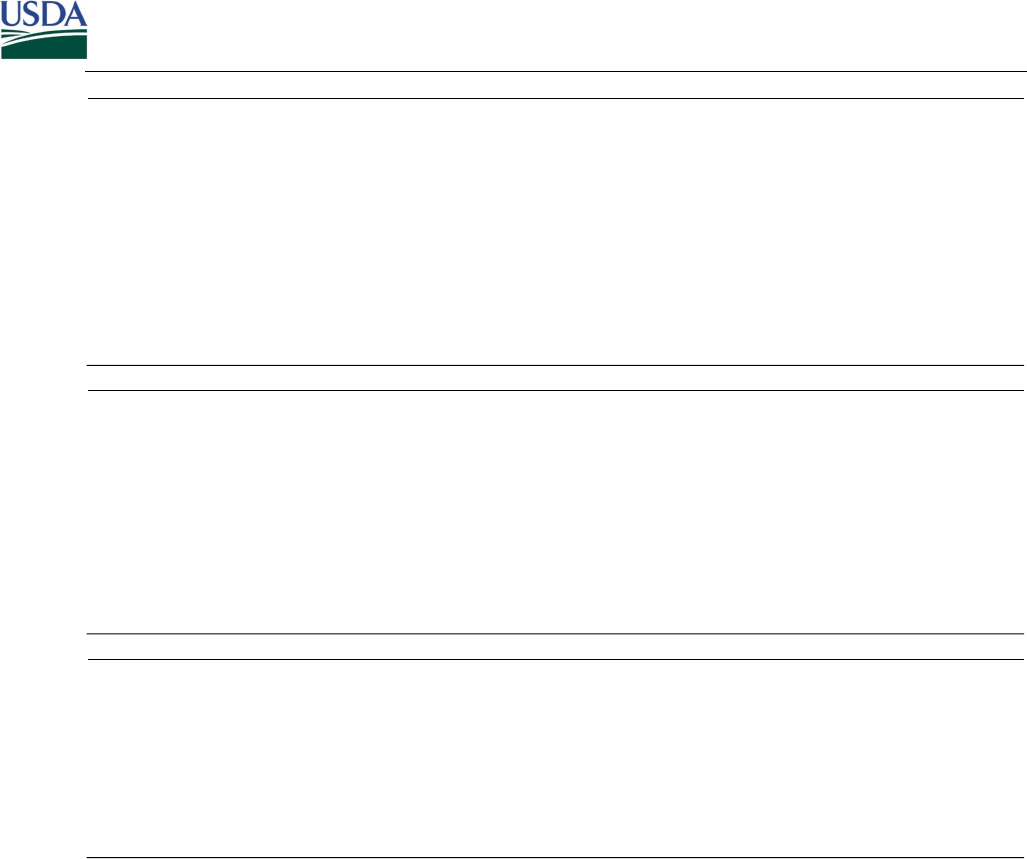
Partnerships for Climate‐Smart Commodities Data Dictionary for Recipients
February 2023
Version 1.0
Page 24 of 87
Activity cost
Data element name: Activity cost 1‐3 Reporting question: What is the value of the activities
this organization has provided to the project?
Description: Cumulative (total) cost of each activity type that the organization has undertaken or offered from
the start of the partnership to the end of the reporting quarter. Enter amounts for up to the top three (in dollar
value) activity types. The worksheet provides three columns for this data element. Enter one value for each
column. If fewer than 3 activity types are provided, leave unnecessary columns blank.
Data type: Decimal Select multiple values: NA
Measurement unit: Dollars Allowed values: $0‐$100,000,000
Logic: None – all respond Required: Yes
Data collection level: Partner Data collection frequency: Quarterly
Products supplied
Data element name: Products supplied Reporting question: What products or supplies were
provided to enrolled fields?
Description: Name(s) of products supplied to enrolled producers as incentives or matching contributions. Enter
the name of each product, including its brand. Separate each product name with a comma. If no products or
supplies were provided by the organization, leave the column blank.
Data type: Text Select multiple values: NA
Measurement unit: Name Allowed values: Text
Logic: None – all respond Required: Yes
Data collection level: Partner Data collection frequency: Quarterly
Product source
Data element name: Product source Reporting question: Which companies provided the
supplies?
Description: Name of firm or company from which supplies were obtained.
Data type: Text Select multiple values: NA
Measurement unit: Name Allowed values: Text
Logic: Respond if text entered for ‘Products supplied’ Required: Yes
Data collection level: Partner Data collection frequency: Quarterly

Partnerships for Climate‐Smart Commodities Data Dictionary for Recipients
February 2023
Version 1.0
Page 25 of 87
Marketing Activities
Commodity type
Data element name: Commodity type Reporting question: What type of commodity is produced by
the farmers enrolled in this project?
Description: List a single commodity produced or marketed through incentives from this project. If multiple
commodities are produced by the project, use additional rows of the worksheet to report each commodity. Use
the FSA commodity list in Appendix B and choose the commodity from the list.
Data type: List Select multiple values: No
Measurement unit: Category Allowed values: FSA commodity list
Logic: None – all respond Required: Yes
Data collection level: Project Data collection frequency: Quarterly
Marketing channel type
Data element name: Marketing channel
type
Reporting question: What type of marketing channel is used to
sell this commodity?
Description: List a single type of marketing channel used to sell the commodity produced by farmers enrolled in
the project. If a single commodity is marketed through multiple channels, use additional rows of the worksheet
to report each combination of commodity and marketing channel. If “other” is chosen, use the additional
column to enter the other marketing channel type(s) as free text.
Data type: List Select multiple values: No
Measurement unit: Category Allowed values:
·
Agricultural marketing board
·
Biorefinery
·
Commodity broker
·
Direct to consumer
·
Direct to institution
·
Direct to restaurant
·
Distributor (including grain elevators)
·
Food hub or cooperative
·
Food processor
·
Non‐food byproducts processor
·
Retailer
·
USDA
·
Other (specify)
Logic: None – all respond Required: Yes
Data collection level: Project Data collection frequency: Quarterly
Number of buyers
Data element name: Number of buyers Reporting question: How many buyers are there in this
marketing channel?
Description: List the number of individual firms or buyers in this marketing channel.
Data type: Integer Select multiple values: No
Measurement unit: Count Allowed values: 1‐500
Logic: None – all respond Required: Yes
Data collection level: Project Data collection frequency: Quarterly

Partnerships for Climate‐Smart Commodities Data Dictionary for Recipients
February 2023
Version 1.0
Page 26 of 87
Names of buyers
Data element name: Names of buyers Reporting question: What are the names of all of the buyers in
this marketing channel?
Description: Provide the names of all buyers in this marketing channel. Separate each name with a comma.
Data type: Text Select multiple values: NA
Measurement unit: Name Allowed values: Text
Logic: None – all respond Required: Yes
Data collection level: Project Data collection frequency: Quarterly
Marketing channel geography
Data element name: Marketing channel
geography
Reporting question: What is the primary geography of the
marketing channel?
Description: The primary geography of the type of marketing channel. Primary geography means the scale at
which most of the activity of buying and selling happens. Local means within a single state or directly
neighboring states. Regional means within a five‐to‐ten state area. National means across the United States.
International means specific locations outside of the United States. Global means across the world or not to a
specific international location.
Data type: List Select multiple values: No
Measurement unit: Category Allowed values:
·
Local
·
Regional
·
National
·
Global
Logic: None – all respond Required: Yes
Data collection level: Project Data collection frequency: Quarterly
Value sold
Data element name: Value sold Reporting question: What is the value of the commodity sold in
this marketing channel?
Description: The dollar value of the commodity sold in this marketing channel this quarter (non‐cumulative).
Data type: Decimal Select multiple values: No
Measurement unit: Dollars Allowed values: $1‐$100,000,000
Logic: None – all respond Required: Yes
Data collection level: Project Data collection frequency: Quarterly
Volume sold
Data element name: Volume sold Reporting question: What is the volume of the commodity sold
in this marketing channel?
Description: The volume of the commodity sold in this marketing channel this quarter (non‐cumulative).
Data type: Decimal Select multiple values: No
Measurement unit: Number Allowed values: 1‐100,000,000
Logic: None – all respond Required: Yes
Data collection level: Project Data collection frequency: Quarterly

Partnerships for Climate‐Smart Commodities Data Dictionary for Recipients
February 2023
Version 1.0
Page 27 of 87
Volume sold unit
Data element name: Volume sold unit Reporting question: What is the unit of volume?
Description: The unit associated with the volume of the commodity sold in the marketing channel. If “other” is
chosen, use the additional column to enter the appropriate unit as free text.
Data type: List Select multiple values: No
Measurement unit: Category Allowed values:
·
Bales (500 pounds)
·
Bushels
·
Carcass pounds
·
Gallons
·
Kilograms
·
Linear board feet
·
Liveweight pounds
·
Metric tons
·
Pounds
·
Short tons
·
Other (specify)
Logic: None – all respond Required: Yes
Data collection level: Project Data collection frequency: Quarterly
Price premium
Data element name: Price premium Reporting question: What price premium is received for the
commodity sold in this marketing channel?
Description: The price premium received for the commodity sold in this marketing channel this quarter. Price
premium is the amount received above a ‘business as usual’ price.
Data type: Decimal Select multiple values: No
Measurement unit: Dollars Allowed values: $0.01‐$10,000
Logic: None – all respond Required: Yes
Data collection level: Project Data collection frequency: Quarterly
Price premium unit
Data element name: Price premium unit Reporting question: What is the unit for the price premium?
Description: The unit associated with the price premium for the commodity sold in the marketing channel. If
“other” is chosen, use the additional column to enter the appropriate unit as free text.
Data type: List Select multiple values: No
Measurement unit: Category Allowed values:
·
Per bale (500 pounds)
·
Per bushel
·
Per carcass pound
·
Per gallon
·
Per kilogram
·
Per linear board foot
·
Per live pound
·
Per metric ton
·
Per ounce
·
Per short ton
·
Other (specify)
Logic: None – all respond Required: Yes
Data collection level: Project Data collection frequency: Quarterly

Partnerships for Climate‐Smart Commodities Data Dictionary for Recipients
February 2023
Version 1.0
Page 28 of 87
Price premium to producer
Data element name: Price premium to
producer
Reporting question: What percent of the price premium is
provided to the producer for the commodity sold in this
marketing channel?
Description: The percent of the price premium provided to the producer for the commodity sold in this
marketing channel this quarter. Price premium is the amount received above a ‘business as usual’ price.
Data type: Decimal Select multiple values: No
Measurement unit: Percent Allowed values: 0‐100
Logic: None – all respond Required: Yes
Data collection level: Project Data collection frequency: Quarterly
Product differentiation method
Data element name: Product differentiation method 1‐3 Reporting question: What methods are used
to differentiate climate‐smart commodities in
this marketing channel?
Description: Provide the methods used to differentiate the climate‐smart commodity in this market channel.
Product differentiation methods are ways to distinguish or differentiate the climate‐smart commodity in the
marketplace. Include up to 3 methods, based on which methods are most commonly used for this project. The
worksheet provides three columns with a drop‐down list of the allowed values. Choose one value for each
column. If fewer than 3 product differentiation methods are used, leave unnecessary columns blank. If “other”
is chosen, use the additional column to enter other product differentiation methods as free text.
Data type: List Select multiple values: No
Measurement unit: Category Allowed values:
·
Certification/verification for internal
insetting
·
Farm certification
·
Label or badge used on packaging or
marketing
·
Third party certification/verification
·
Trademark
·
Other (specify)
Logic: None – all respond Required: Yes
Data collection level: Project Data collection frequency: Quarterly
Marketing method
Data element name: Marketing method 1‐3 Reporting question: What methods are used to market
climate‐smart commodities in this marketing channel?
Description: Provide the method(s) used to market this commodity in this market channel. Marketing method is
the way that potential buyers of the climate‐smart commodity are engaged by the project partners as the sellers
or facilitators of sale. Include up to 3 methods, based on which methods are most commonly used for this
project. The worksheet provides three columns with a drop‐down list of the allowed values. Choose one value
for each column. If fewer than 3 marketing methods are used, leave unnecessary columns blank. If “other” is
chosen, use the additional column to enter other marketing methods as free text
Data type: List Select multiple values: No
Measurement unit: Category Allowed values:
·
Label or badge used on packaging or marketing materials
·
Marketing partnership (e.g., promotion by buyer)
·
Print marketing campaign
·
Social media and digital marketing campaign
·
Verbal marketing campaign (e.g., radio, word of mouth)
·
Other (specify)
Logic: None – all respond Required: Yes
Data collection level: Project Data collection frequency: Quarterly

Partnerships for Climate‐Smart Commodities Data Dictionary for Recipients
February 2023
Version 1.0
Page 29 of 87
Marketing channel identification method
Data element name: Marketing channel
identification method 1‐3
Reporting question: What methods are used to generate
interest in climate‐smart commodities in this marketing
channel?
Description: Provide the marketing channel identification method(s) used for this commodity in this market
channel. Market channel identification methods are the ways that producers and project partners generate
interest in purchasing the climate‐smart commodity. Include up to 3 methods, based on which methods are
most commonly used for this project. The worksheet provides three columns with a drop‐down list of the
allowed values. Choose one value for each column. If fewer than 3 marketing channel identification methods
are used, leave unnecessary columns blank. If “other” is chosen, use the additional column to enter other
marketing channel identification methods as free text
Data type: List Select multiple values: No
Measurement unit: Category Allowed values:
·
Educational tours for buyers
·
In‐person lead generation
·
Negotiated contracts with buyers
·
Partnership network or project partner
·
Other (specify)
Logic: None – all respond Required: Yes
Data collection level: Project Data collection frequency: Quarterly
Traceability method
Data element name: Traceability method
1‐3
Reporting question: What traceability methods are used for climate‐
smart commodities in this channel?
Description: Provide the traceability method(s) used for the climate‐smart commodity in this market channel.
Traceability methods are ways to trace the climate‐smart commodity or the climate‐smart claims through the
supply chain. Include up to 3 methods, based on which methods are most commonly used for this project. The
worksheet provides three columns with a drop‐down list of the allowed values. Choose one value for each
column. If fewer than 3 traceability methods are used, leave unnecessary columns blank. If “other” is chosen,
use the additional column to enter other traceability methods as free text.
Data type: List Select multiple values: No
Measurement unit: Category Allowed values:
·
Barcode or unique ID
·
Blockchain
·
Book and claim
·
Chain of custody
·
Mass balance
·
Recordkeeping
·
Registry with certification
·
Segregation
·
Supply shed
·
Volume proxy
·
Other (specify)
Logic: None – all respond Required: Yes
Data collection level: Project Data collection frequency: Quarterly

Partnerships for Climate‐Smart Commodities Data Dictionary for Recipients
February 2023
Version 1.0
Page 30 of 87
Producer Enrollment
Unique IDs
Farm ID Unique Farm ID assigned by FSA
State or territory State name (must match FSA farm enrollment data)
County of residence County name (must match FSA farm enrollment data)
Producer data change
Data element name: Producer data change Reporting question: Is there new/updated
information for a producer who is re‐enrolling in the
project?
Description: Indicates that there is new or updated information for a producer who had previously enrolled in
the project and is re‐enrolling.
Data type: List Select multiple values: No
Measurement unit: Category Allowed values:
· Yes
· No
Logic: None – all respond Required: Yes
Data collection level: Producer Data collection frequency: Re‐enrollment
Producer start date
Data element name: Producer start date Reporting question: When did the producer enroll in
the project?
Description: Date that the producer enrolled in the project by signing their first contract.
Data type: Date Select multiple values: NA
Measurement unit: MM/DD/YYYY Allowed values: 01/01/2023 – 12/31/2030
Logic: None – all respond Required: Yes
Data collection level: Producer Data collection frequency: Initial enrollment
Producer name
Data element name: Producer name Reporting question: What is the name of producer
enrolled in the project?
Description: Name of the producer enrolled in the project; the name must match the name contained in the
customer’s Business Partner record and the Farm Operating Plan in FSA Business File for that Farm ID.
Data type: Text Select multiple values: NA
Measurement unit: NA Allowed values: Text
Logic: None – all respond Required: Yes
Data collection level: Producer Data collection frequency: Initial enrollment

Partnerships for Climate‐Smart Commodities Data Dictionary for Recipients
February 2023
Version 1.0
Page 31 of 87
Underserved status
Data element name: Underserved status Reporting question: Is this producer considered an
underserved and/or a small producer?
Description: Underserved status of the primary operator of the enrolled operation. Underserved producers
generally include beginning farmers, socially disadvantaged farmers, veteran farmers, and limited resource
farmers; women farmers and producers growing specialty crops are generally also included in these categories.
Small farms are generally those with less than $350,000 in annual gross cash farm income. Indicate whether this
producer is considered underserved, a small producer, or both underserved and a small producer. Use “I don’t
know” if the producer declines to answer. Departmental Regulation 4370‐001 provides USDA’s policies for
collecting demographic data, including race, ethnicity and gender. Providing demographic information is
voluntary and at the discretion of the customer. Demographic information is used by USDA for statistical
purposes only and will not be used to determine an applicant’s eligibility for programs or services for which they
apply.
Data type: List Select multiple values: No
Measurement unit: Category Allowed values:
· Yes, underserved
· Yes, small producer
· Yes, underserved and small producer
· No
· I don’t know
Logic: None – all respond Required: No
Data collection level: Producer Data collection frequency: Initial enrollment
Total area
Data element name: Total area Reporting question: What is the total area of the farm?
Description: Total area of the farm associated with the Farm ID. Report total area of the farm, even if only a
portion of the farm is enrolled in the project. If a producer is enrolled in the project for multiple years, review
the total area each time a new contract is signed and provide any necessary updates.
Data type: List Select multiple values: No
Measurement unit: Category Allowed values:
·
Less than 1 acre
·
1 to 9 acres
·
10 to 49 acres
·
50 to 69 acres
·
70 to 99 acres
·
100 to 139 acres
·
140 to 179 acres
·
180 to 219 acres
·
220 to 259 acres
·
260 to 499 acres
·
500 to 999 acres
·
1,000 to 1,999 acres
·
2,000 to 4,999 acres
·
5,000 or more acres
Logic: None – all respond Required: Yes
Data collection level: Producer Data collection frequency: Initial enrollment and subsequent
enrollment(s), if applicable

Partnerships for Climate‐Smart Commodities Data Dictionary for Recipients
February 2023
Version 1.0
Page 32 of 87
Total crop area
Data element name: Total crop area Reporting question: What percent of the current operation is
cropland?
Description: Area of the total farm that is currently used as cropland. If a producer is enrolled in the project for
multiple years, review the total crop area each time a new contract is signed and provide any necessary
updates.
Data type: Integer Select multiple values: No
Measurement unit: Acres Allowed values: 0‐100,000
Logic: None – all respond Required: Yes
Data collection level: Producer Data collection frequency: Initial enrollment and subsequent
enrollment(s), if applicable
Total livestock area
Data element name: Total livestock
area
Reporting question: What amount of the current operation is used for
livestock (by area)?
Description: Area of the total farm that is currently used for pasture, grazing, rangeland; or animal housing,
feeding or milking. If a producer is enrolled in the project for multiple years, review the total livestock area each
time a new contract is signed and provide any necessary updates.
Data type: Integer Select multiple values: No
Measurement unit: Acres Allowed values: 0‐100,000
Logic: None – all respond Required: Yes
Data collection level: Producer Data collection frequency: Initial enrollment and subsequent
enrollment(s), if applicable
Total forest area
Data element name: Total forest area Reporting question: What amount of the current operation is forested
(by area)?
Description: Area of the total farm that is currently considered forest land use. Forest land use means that at
least 10% of the land area is covered in trees that will be at least 13 feet tall when mature. If a producer is
enrolled in the project for multiple years, review the total forest area each time a new contract is signed and
provide any necessary updates.
Data type: Integer Select multiple values: No
Measurement unit: Acres Allowed values: 0‐100,000
Logic: None – all respond Required: Yes
Data collection level: Producer Data collection frequency: Initial enrollment and subsequent
enrollment(s), if applicable

Partnerships for Climate‐Smart Commodities Data Dictionary for Recipients
February 2023
Version 1.0
Page 33 of 87
Livestock type
Data element name: Livestock type 1‐3 Reporting question: What types of livestock are
raised on the farm?
Description: Up to top three types of livestock (by head count) on the farm. The worksheet provides three
columns with a drop‐down list of the allowed values. Choose one value for each column. If there are fewer than
3 livestock types, leave unnecessary columns blank. If “other” is chosen, use the additional column to enter
other livestock types as free text. If a producer is enrolled in the project for multiple years, review the livestock
type each time a new contract is signed and provide any necessary updates.
Data type: List Select multiple values: No
Measurement unit: Category Allowed values:
· Alpacas
· Beef cows
· Beefalo
· Buffalo or
bison
· Chickens
(broilers)
· Chickens
(layers)
· Dairy cows
· Deer
· Ducks
· Elk
· Emus
· Equine
· Geese
· Goats
· Honeybees
· Llamas
· Reindeer
· Sheep
· Swine
· Turkeys
· Other
(specify)
Logic: Respond if ’Total livestock area’ >0 Required: Yes
Data collection level: Producer Data collection frequency: Initial enrollment and
subsequent enrollment(s), if applicable
Livestock head
Data element name: Livestock head 1‐3 Reporting question: How many livestock (by type) are
on this operation?
Description: Average annual head count for each type of livestock. Enter amounts for up to the top three
livestock types by number. The worksheet provides three columns for this data element. Enter one value for
each column. If there are fewer than 3 livestock types, leave unnecessary columns blank. If a producer is
enrolled in the project for multiple years, review the average annual head count each time a new contract is
signed and provide any necessary updates.
Data type: Integer Select multiple values: NA
Measurement unit: Head count Allowed values: 1‐10,000,000
Logic: Respond if ’Total livestock area’ >0 Required: Yes
Data collection level: Producer Data collection frequency: Initial enrollment and
subsequent enrollment(s), if applicable

Partnerships for Climate‐Smart Commodities Data Dictionary for Recipients
February 2023
Version 1.0
Page 34 of 87
Organic farm
Data element name: Organic farm Reporting question: Is any part of the farm currently USDA‐
certified organic or transitioning to USDA‐certified organic?
Description: USDA‐certified organic means that the farm has been certified by an accredited organic certifying
agent or is transitioning to USDA‐certified organic by not using any of the prohibited substances. Yes means that
some or all of the farm is certified organic or transitioning to certified organic. No means that no part of the
farm is certified organic or transitioning to certified organic. If a producer is enrolled in the project for multiple
years, review the organic certification status of the farm each time a new contract is signed and provide any
necessary updates.
Data type: List Select multiple values: No
Measurement unit: Category Allowed values:
·
Yes
·
No
·
I don’t know
Logic: None – all respond Required: No
Data collection level: Producer Data collection frequency: Initial enrollment and
subsequent enrollment(s), if applicable
Organic fields
Data element name: Organic fields Reporting question: Are any of the fields enrolled in the
project currently USDA‐certified organic or transitioning to
USDA‐certified organic?
Description: USDA‐certified organic means that the operation has been certified by an accredited organic
certifying agent or is transitioning to USDA‐certified organic by not using any of the prohibited substances. Yes
means that some or all of the fields enrolled in the project are certified organic or transitioning to certified
organic. No means that no part of the fields enrolled in the project are certified organic or transitioning to
certified organic. If a producer is enrolled in the project for multiple years, review the organic certification status
of the enrolled fields each time a new contract is signed and provide any necessary updates.
Data type: List Select multiple values: No
Measurement unit: Category Allowed values:
·
Yes
·
No
·
I don’t know
Logic: Respond if yes to ‘Organic operation’ Required: No
Data collection level: Producer Data collection frequency: Initial enrollment and
subsequent enrollment(s), if applicable
Producer motivation
Data element name: Producer motivation Reporting question: Which of the following was the primary
reason the producer enrolled in this project?
Description: Primary operator’s motivation for enrolling in the project.
Data type: List Select multiple values: No
Measurement unit: Category Allowed values:
·
Financial benefit
·
Environmental benefit
·
New market opportunity
·
Partnerships or networks
·
Other
Logic: None – all respond Required: Yes
Data collection level: Producer Data collection frequency: Initial enrollment

Partnerships for Climate‐Smart Commodities Data Dictionary for Recipients
February 2023
Version 1.0
Page 35 of 87
Producer outreach
Data element name: Producer outreach 1‐
3
Reporting question: What types of outreach were provided to
producers?
Description: Up to three most common types of outreach provided to producer prior to enrollment. Outreach
activities are those focused on identifying and enrolling producers in the project. Outreach can come from the
recipient or project partners. The worksheet provides three columns with a drop‐down list of the allowed
values. Choose one value for each column. If there are fewer than 3 outreach types, leave unnecessary columns
blank. If “other” is chosen, use the additional column to enter other outreach types as free text.
Data type: List Select multiple values: Yes
Measurement unit: Category Allowed values:
·
Commodity organizations
·
Conferences
·
Cooperative extension
·
Digital communications and resources
·
Education workshops, field days, and town halls
·
Existing partner networks
·
Farm visits and one‐on‐one meetings
·
General advertising
·
Peer referrals and producer groups
·
Phone calls
·
Print communications and resources
·
Retailers
·
State agencies
·
Targeted messaging using proprietary data
·
Technical service providers
·
Other (specify)
Logic: None – all respond Required: Yes
Data collection level: Producer Data collection frequency: Initial enrollment
CSAF experience
Data element name: CSAF experience Reporting question: Has the primary operator implemented
CSAF practices in the last ten years anywhere on the farm?
Description: Has this farm implemented climate‐smart agriculture or forestry (CSAF) practices anywhere on the
farm in the past 10 years or since the current primary operator took control (whichever time period is shorter)?
CSAF practices are included in a list in Appendix A.
Data type: List Select multiple values: No
Measurement unit: Category Allowed values:
·
Yes
·
No
·
I don’t know
Logic: None – all respond Required: Yes
Data collection level: Producer Data collection frequency: Initial enrollment

Partnerships for Climate‐Smart Commodities Data Dictionary for Recipients
February 2023
Version 1.0
Page 36 of 87
CSAF federal funds
Data element name: CSAF federal funds Reporting question: Were prior CSAF practices supported by
federal funds?
Description: If this farm (under the primary operator) has implemented CSAF practices in the last ten years, was
implementation supported by federal funds? Federal funds are defined as being from programs including, but
not limited to, those from the Natural Resources Conservation Service ((NRCS), including through Environmental
Quality Incentives Program (EQIP), Conservation Stewardship Program (CSP), Regional Conservation Partnership
Program (RCPP), or related programs), the Farm Service Agency Conservation Reserve Program (CRP), as well as
funds from other USDA programs or other federal agencies.
Data type: List Select multiple values: No
Measurement unit: Category Allowed values:
·
Yes
·
No
·
I don’t know
Logic: Respond if yes to 'CSAF experience’ Required: Yes
Data collection level: Producer Data collection frequency: Initial enrollment
CSAF state or local funds
Data element name: CSAF state or local
funds
Reporting question: Were prior CSAF practices supported by
state or local funds?
Description: If this farm (under the primary operator) has implemented CSAF practices in the last ten years, was
implementation supported by state funds? State or local funds are those from state departments of agriculture
or other state agencies, local water quality districts and other local agencies.
Data type: List Select multiple values: No
Measurement unit: Category Allowed values:
·
Yes
·
No
·
I don’t know
Logic: Respond if yes to 'CSAF experience’ Required: Yes
Data collection level: Producer Data collection frequency: Initial enrollment
CSAF nonprofit funds
Data element name: CSAF nonprofit funds Reporting question: Were CSAF practices supported by
nonprofit funds?
Description: If this farm (under the primary operator) has implemented CSAF practices in the last ten years, was
implementation supported by nonprofit funds? Nonprofit funds are those offered directly from a nonprofit
organization to a producer.
Data type: List Select multiple values: No
Measurement unit: Category Allowed values:
·
Yes
·
No
·
I don’t know
Logic: Respond if yes to 'CSAF experience’ Required: Yes
Data collection level: Producer Data collection frequency: Initial enrollment
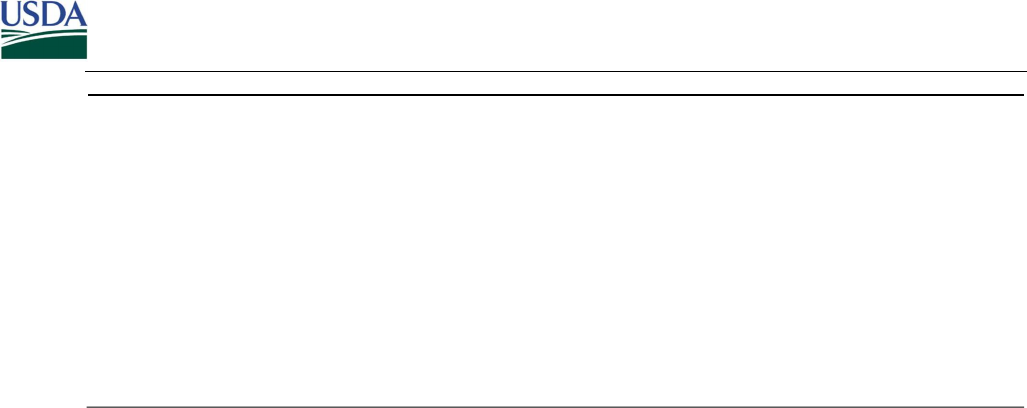
Partnerships for Climate‐Smart Commodities Data Dictionary for Recipients
February 2023
Version 1.0
Page 37 of 87
CSAF market incentives
Data element name: CSAF market incentives Reporting question: Were CSAF practices supported by market
incentives?
Description: If this farm (under the primary operator) has implemented CSAF practices in the last ten years, was
implementation supported by market incentives? Market incentives include premiums paid by a commodity
buyer or by a consumer based on branding or labeling as a climate‐smart commodity.
Data type: List Select multiple values: No
Measurement unit: Category Allowed values:
·
Yes
·
No
·
I don’t know
Logic: Respond if yes to ‘CSAF experience’ Required: Yes
Data collection level: Producer Data collection frequency: Initial enrollment
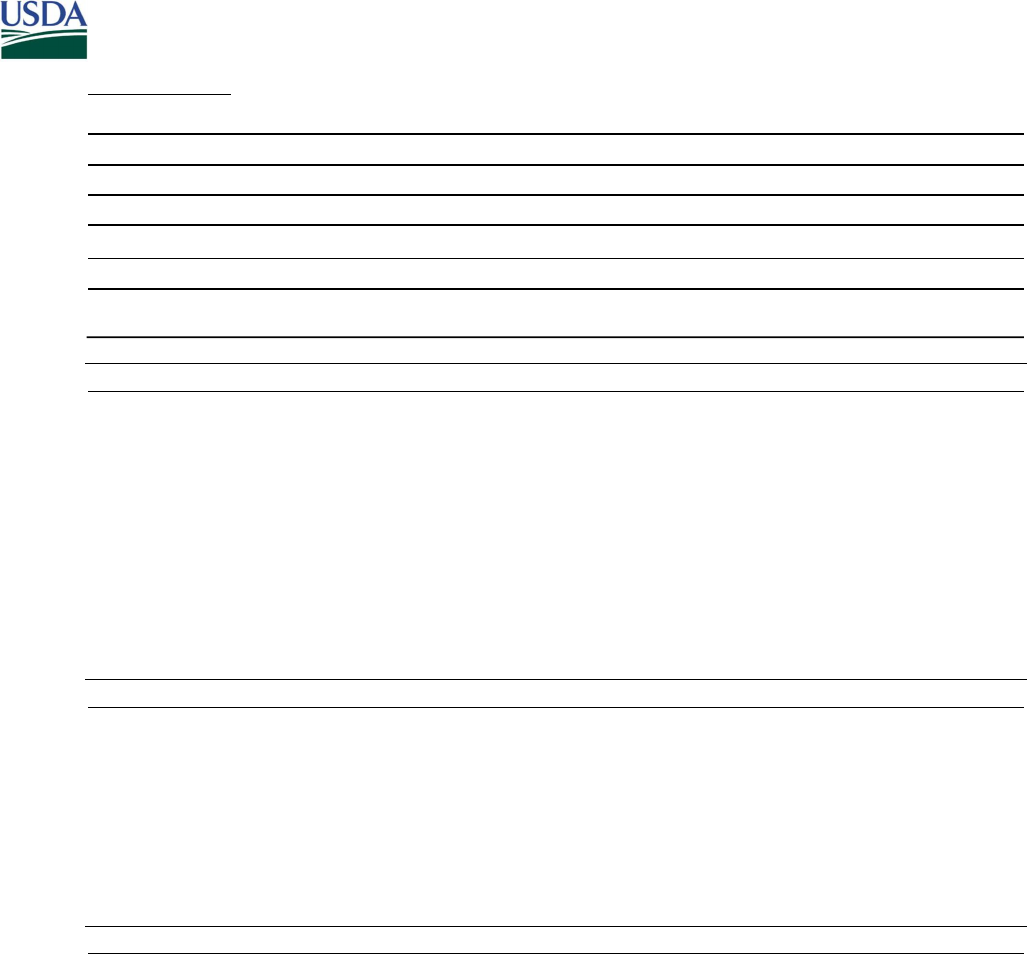
Partnerships for Climate‐Smart Commodities Data Dictionary for Recipients
February 2023
Version 1.0
Page 38 of 87
Field Enrollment
Unique IDs
Farm ID Unique Farm ID assigned by FSA
Tract ID Unique Tract ID assigned by FSA
Field ID Unique Field ID assigned by FSA
State or territory of field State name (must match FSA farm enrollment data)
County of field County name (must match FSA farm enrollment data)
Prior Field ID, if applicable Prior Field ID assigned by FSA if there has been reconstitution of the farm
resulting in a new Field ID during the field’s enrollment in the project
Field data change
Data element name: Field data change Reporting question: Has the information previously
reported for this field changed?
Description: Indicator that this entry is being used to report any relevant changes, such as a new Field ID
number or changes to the commodity or practice combinations, for a field that has previously been enrolled in
the project.
Data type: List Select multiple values: No
Measurement unit: Category Allowed values:
· Yes
· No
Logic: None – all respond Required: Yes
Data collection level: Field Data collection frequency: Re‐enrollment
Contract start date
Data element name: Contract start date Reporting question: What is the start date of the
contract with the producer that includes this field?
Description: Start date listed on the contract that enrolls the field in the project.
Data type: Date Select multiple values: NA
Measurement unit: MM/DD/YYYY Allowed values: 01/01/2023 – 12/31/2030
Logic: None – all respond Required: Yes
Data collection level: Field Data collection frequency: Initial enrollment
Total field area
Data element name: Total field area Reporting question: What is the total size of the
enrolled field?
Description: Total size of the field enrolled with the project.
Data type: Decimal Select multiple values: No
Measurement unit: Acres Allowed values: .01‐500
Logic: None – all respond Required: Yes
Data collection level: Field Data collection frequency: Initial enrollment

Partnerships for Climate‐Smart Commodities Data Dictionary for Recipients
February 2023
Version 1.0
Page 39 of 87
Commodity category
Data element name: Commodity category Reporting question: What category of
commodity(ies) is (are) produced from this field?
Description: Category of commodity(ies) produced in field enrolled in the project
Data type: List Select multiple values: No
Measurement unit: Category Allowed values:
· Crops
· Livestock
· Trees
· Crops and livestock
· Crops and trees
· Livestock and trees
· Crops, livestock and trees
Logic: None – all respond Required: Yes
Data collection level: Field Data collection frequency: Initial enrollment
Commodity type
Data element name: Commodity type Reporting question: What type of commodity is
produced from this field?
Description: Type of commodity produced in field enrolled in the project. See full list in Appendix B. The
worksheet provides a drop‐down list of the allowed values. Choose the appropriate value. Enter additional
commodities in subsequent rows.
Data type: List Select multiple values: No
Measurement unit: Category Allowed values: FSA commodity list
Logic: None – all respond Required: Yes
Data collection level: Field Data collection frequency: Initial enrollment
Baseline yield
Data element name: Baseline yield Reporting question: What is the baseline yield
of this field?
Description: Average annual yield of commodity in 3 years prior to enrollment. Provide yield for the enrolled
field if possible. If not at field level, provide average annual yield for the specific commodity for the operation.
Data type: Decimal Select multiple values: No
Measurement unit: Production per acre or animal Allowed values: .01‐100,000
Logic: None – all respond Required: Yes
Data collection level: Field Data collection frequency: Initial enrollment

Partnerships for Climate‐Smart Commodities Data Dictionary for Recipients
February 2023
Version 1.0
Page 40 of 87
Baseline yield unit
Data element name: Baseline yield unit Reporting question: Baseline yield unit
Description: Unit of average annual yield of commodity in enrolled field in 3 years prior to enrollment. The
worksheet provides a drop‐down list of choices for this data element. If “other” is chosen, use the additional
column to enter the appropriate yield unit as free text.
Data type: List Select multiple values: No
Measurement unit: Category Allowed values:
· Animal units per acre
· Bushels per acre
· Carcass pounds per animal
· Head per acre
· Hundred‐weights (or pounds) per head
· Linear feet per acre
· Liveweight pounds per animal
· Pounds per acre
· Tons per acre
· Other (specify)
Logic: None – all respond Required: Yes
Data collection level: Field Data collection frequency: Initial enrollment
Baseline yield location
Data element name: Baseline yield location Reporting question: For what portion of the operation is the
baseline yield being reported?
Description: Location of the reported average annual yield of commodity in 3 years prior to enrollment. If
“other” is chosen, use the additional column to enter the appropriate location as free text.
Data type: List Select multiple values: No
Measurement unit: Category Allowed values:
· Enrolled field
· Whole operation
· Other (specify)
Logic: None – all respond Required: Yes
Data collection level: Field Data collection frequency: Initial enrollment
Field land use
Data element name: Field land use Reporting question: What is this field’s land use history?
Description: Prior to enrollment, what was the most common land use for this field in the past 3 years?
Data type: List Select multiple values: No
Measurement unit: Category Allowed values:
· Crop land
· Forest land
· Non‐agriculture
· Other agricultural land
· Pasture
· Range
Logic: None – all respond Required: Yes
Data collection level: Field Data collection frequency: Initial enrollment

Partnerships for Climate‐Smart Commodities Data Dictionary for Recipients
February 2023
Version 1.0
Page 41 of 87
Field irrigated
Data element name: Field irrigated Reporting question: What is this field’s irrigation history?
Description: Prior to enrollment, what was the most common irrigation practice on this field the past 3 years?
Data type: List Select multiple values: No
Measurement unit: Category Allowed values:
· No irrigation
· Center pivot
· Drip‐subsurface
· Drip‐surface
· Flood/border
· Furrow/ditch
· Lateral/linear sprinklers
· Micro‐sprinklers
· Seepage
· Side roll
· Solid set sprinklers
· Supplemental
· Surface
· Traveling gun/towline
· Wheel Line
· Other
Logic: None – all respond Required: Yes
Data collection level: Field Data collection frequency: Initial enrollment
Field tillage
Data element name: Field tillage Reporting question: What is this field’s tillage history?
Description: Prior to enrollment, what was the most common tillage approach during the past 3 years?
Data type: List Select multiple values: No
Measurement unit: Category Allowed values:
· None
· Conventional, inversion
· Conventional, vertical
· No‐till, direct seed
· Reduced till, inversion
· Reduced till, vertical
· Strip till
· Other
Logic: None – all respond Required: Yes
Data collection level: Field Data collection frequency: Initial enrollment

Partnerships for Climate‐Smart Commodities Data Dictionary for Recipients
February 2023
Version 1.0
Page 42 of 87
Practice past extent ‐ farm
Data element name: Practice past extent ‐
farm
Reporting question: What percent of the farm has
implemented this CSAF practice (combination) previously?
Description: Prior to enrollment, on what portion of the whole farm had this (these) CSAF practice(s) ever been
used by the primary operator? If multiple practices are planned to be implemented in this field, enter the value
that best corresponds to the farm’s prior experience with the planned set of practices.
Data type: List Select multiple values: No
Measurement unit: Category Allowed values:
· Never used
· Used on less than 25% of operation
· Used on 25‐50% of operation
· Used on 51‐75% of operation
· Used on more than 75% of operation
Logic: None – all respond Required: Yes
Data collection level: Field Data collection frequency: Initial enrollment
Field any CSAF practice
Data element name: Field any CSAF practice Reporting question: What is this field’s prior experience with
CSAF practices?
Description: Prior to enrollment, have any CSAF practice or practices been used in this field in the past 3 years?
CSAF practices are included in a list in Appendix A.
Data type: List Select multiple values: No
Measurement unit: Category Allowed values:
· Yes
· No
· I don’t know
Logic: None – all respond Required: Yes
Data collection level: Field Data collection frequency: Initial enrollment
Practice past use ‐ this field
Data element name: Practice past use ‐ this
field
Reporting question: Have this CSAF practice (combination)
been implemented previously in this field?
Description: Prior to enrollment, had this (these) CSAF practice(s) been used in this field in the in the past 3
years? Enter yes if all of the practices had been used previously in this field; enter some if multiple practices are
being implemented and one or more, but not all of the practices had been used previously in this field; and
enter no if none of the practices had been used previously in this field.
Data type: List Select multiple values: No
Measurement unit: Category Allowed values:
·
Yes
·
Some
·
No
·
I don’t know
Logic: None – all respond Required: Yes
Data collection level: Field Data collection frequency: Initial enrollment

Partnerships for Climate‐Smart Commodities Data Dictionary for Recipients
February 2023
Version 1.0
Page 43 of 87
Practice type
Data element name: Practice type 1‐7 Reporting question: What CSAF practice is being implemented
in this field through the project?
Description: Which CSAF practice or practices will be implemented on this field as part of enrollment in the
project? CSAF practices are included in a list in Appendix A. The worksheet provides seven columns for this data
element. Enter one value for each column. If there are fewer than 7 practices being implemented on this field
through enrollment in the project, leave unnecessary columns blank.
Data type: List Select multiple values: No
Measurement unit: Category Allowed values: See list in Appendix A
Logic: None – all respond Required: Yes
Data collection level: Field Data collection frequency: Initial enrollment
Practice standard
Data element name: Practice standard 1‐7 Reporting question: What standard does the CSAF practice
follow?
Description: Is the CSAF practice being implemented on the field as part of enrollment in the project following a
defined practice standard? The worksheet provides seven columns for this data element. Enter one value for
each column, corresponding to the practice types entered in the previous columns. If there are fewer than 7
practices being implemented on this field through enrollment in the project, leave unnecessary columns blank.
Data type: List Select multiple values: No
Measurement unit: Category Allowed values:
·
NRCS
·
Other (specify)
Logic: None – all respond Required: Yes
Data collection level: Field Data collection frequency: Initial enrollment
Planned practice implementation year
Data element name: Practice 1‐7
implementation year
Reporting question: What year is the CSAF practice planned to
be implemented?
Description: Year that the CSAF practice is planned to be implemented on the field. Use 2022 for early adopters,
defined as fields that have the practice actively implemented in 2022 (prior to contract being signed for this
project). The worksheet provides seven columns for this data element. Enter one value for each column,
corresponding to the practice types entered in the previous columns. If there are fewer than 7 practices being
implemented on this field through enrollment in the project, leave unnecessary columns blank.
Data type: Integer Select multiple values: No
Measurement unit: Year Allowed values: 2022‐2030
Logic: None – all respond Required: Yes
Data collection level: Field Data collection frequency: Initial enrollment
Practice extent
Data element name: Practice 1‐7 extent Reporting question: To what extent is the practice
implemented?
Description: Total area, length, or head where the practice is being implemented in the field specified by the
contract.
Data type: Decimal Select multiple values: No
Measurement unit: Extent Allowed values: .01‐
100,000
Logic: None – all respond Required: Yes
Data collection level: Field Data collection frequency: Initial enrollment
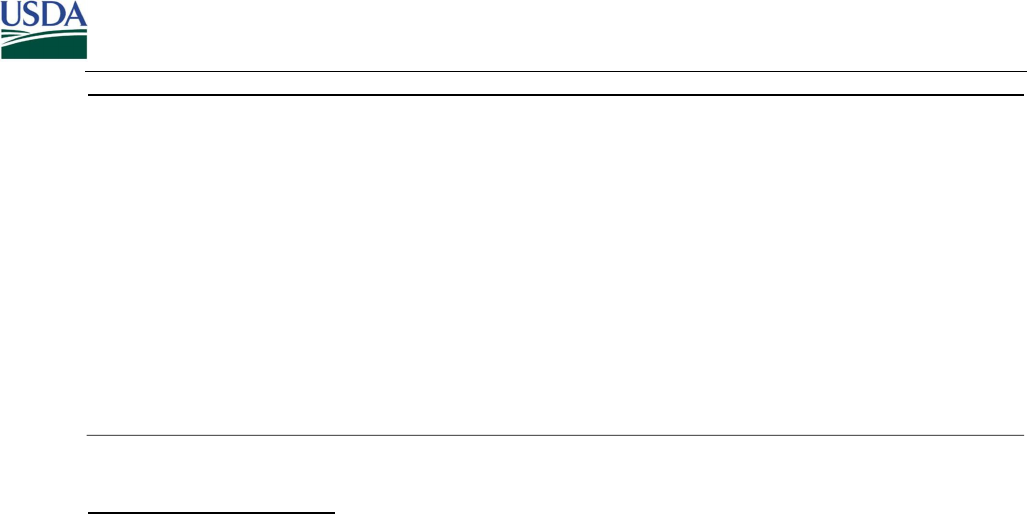
Partnerships for Climate‐Smart Commodities Data Dictionary for Recipients
February 2023
Version 1.0
Page 44 of 87
Practice extent unit
Data element name: Practice 1‐7
extent unit
Reporting question: Unit for extent of practice implementation
Description: Unit for extent of practice implementation on the field specified by the contract. If “other” is
chosen, use the additional column to enter the appropriate unit.
Data type: List Select multiple values: No
Measurement unit: Category Allowed values:
· Acres
· Head of livestock
· Linear feet
· Square feet
· Other (specify)
Logic: None – all respond Required: Yes
Data collection level: Field Data collection frequency: Initial enrollment
CSAF Practice Sub‐questions
For certain practices, additional questions are asked that provide information necessary to estimate greenhouse
gas benefits from implementation of the practice. See Table 11 in the CSAF Practice Sub‐questions section for
descriptions of individual questions to be answered depending on the CSAF practices selected.

Partnerships for Climate‐Smart Commodities Data Dictionary for Recipients
February 2023
Version 1.0
Page 45 of 87
Farm Summary
Unique IDs
Farm ID Unique Farm ID assigned by FSA
State or territory State name (must match FSA farm enrollment data)
County of residence County name (must match FSA farm enrollment data)
Producer TA received
Data element name: Producer TA received
1‐3
Reporting question: What types of technical assistance were
provided to this producer?
Description: Did the recipient or any partner provide technical assistance (TA) to the producer this year?
Technical assistance is any training, education, capacity building or other support provided by any project
partner(s) directly to producers enrolled in the project. List up to the top three most common types of TA
provided to this producer. The worksheet provides three columns with a drop‐down list of the allowed values.
Choose one value for each column. If there are fewer than 3 TA types, leave unnecessary columns blank. If
“other” is chosen, use the additional column to enter other TA types as free text.
Data type: List Select multiple values: No
Measurement unit: Category Allowed values:
·
Demonstration plots
·
Equipment demonstrations
·
Group field days or in‐person field workshops
·
Hotline
·
One‐on‐one enrollment assistance
·
One‐on‐one field visits
·
One‐on‐one producer mentorship
·
Producer networks and peer‐to‐peer groups
·
Retailer consultation
·
Social media/digital tools
·
Train‐the‐trainer opportunities
·
Virtual meetings or field days
·
Webinars and videos
·
Written materials
·
None
·
Other (specify)
Logic: None – all respond Required: Yes
Data collection level: Producer Data collection frequency: Quarterly
Producer incentive amount
Data element name: Producer incentive
amount
Reporting question: What is the total value of financial
incentives provided to this producer?
Description: Total incentive payment received by the producer from USDA project funds for the year (non‐
cumulative). Do not include incentive payments made with partner match funds.
Data type: Decimal Select multiple values: NA
Measurement unit: Dollars Allowed values: $0‐$5,000,000
Logic: None – all respond Required: Yes
Data collection level: Producer Data collection frequency: Quarterly

Partnerships for Climate‐Smart Commodities Data Dictionary for Recipients
February 2023
Version 1.0
Page 46 of 87
Incentive reason
Data element name: Incentive reason 1‐4 Reporting question: Why were incentives provided to this
producer?
Description: List up to four reasons for producer incentive payments. List the top 4 based on total value of the
incentive for each reason. The worksheet provides four columns with a drop‐down list of the allowed values.
Choose one value for each column. If there are fewer than 4 reasons, leave unnecessary columns blank. If
“other” is chosen, use the additional column to enter other reasons as free text.
Data type: List Select multiple values: No
Measurement unit: Category Allowed values:
·
Avoided conversion
·
Conference or training attendance
·
Demographics/equity payment
·
Enrollment
·
Foregone revenue
·
Historic data collection
·
Identity preservation (supply chain tracing)
·
Implementation of practices
·
MMRV (e.g., data collection, reporting)
·
Passing audit
·
Price premium on output
·
Yield change
·
Other (specify)
Logic: None – all respond Required: Yes
Data collection level: Producer Data collection frequency: Quarterly
Incentive structure
Data element name: Incentive structure 1‐4 Reporting question: What are the units for the financial
incentives provided to this producer?
Description: List the structures (units) corresponding to the top 4 (by dollar value) incentive payments to
producers. Production unit is weight or volume (bushel, kilogram, ton). The worksheet provides four columns
with a drop‐down list of the allowed values. Choose one value for each column. If there are fewer than 4
structure types, leave unnecessary columns blank. If “other” is chosen, use the additional column to enter other
structure types as free text.
Data type: List Select multiple values: No
Measurement unit: Category Allowed values:
·
Flat rate
·
Per animal head
·
Per area
·
Per length
·
Per production unit
·
Per ton GHG
·
Per tree
·
Other (specify)
Logic: None – all respond Required: Yes
Data collection level: Producer Data collection frequency: Quarterly

Partnerships for Climate‐Smart Commodities Data Dictionary for Recipients
February 2023
Version 1.0
Page 47 of 87
Incentive type
Data element name: Incentive type 1‐4 Reporting question: What type of incentives were provided to
each producer?
Description: List the top 4 types of incentive payments to producers (based on dollar value). The worksheet
provides four columns with a drop‐down list of the allowed values. Choose one value for each column. If there
are fewer than 4 incentive types, leave unnecessary columns blank. If “other” is chosen, use the additional
column to enter other incentive types as free text.
Data type: List Select multiple values: No
Measurement unit: Category Allowed values:
·
Cash payment
·
Equipment loan
·
Guaranteed commodity premium payment
·
Inputs and supplies
·
Land rental
·
Loan
·
Paid labor
·
Post‐harvest transportation
·
Tuition or fees for training
·
Other (specify)
Logic: None – all respond Required: Yes
Data collection level: Producer Data collection frequency: Quarterly
Payment on enrollment
Data element name: Payment on
enrollment
Reporting question: What portion of the financial incentive is
provided to the producer upon enrollment in the project?
Description: Any incentive payment provided to the producer upon enrollment/signing a contract, and not
related to any implementation, MMRV or sales activities. Full payment means the full incentive amount for any
contract held by the producer is paid upon enrollment. Partial payment means that only part of the full
incentive amount for any contract held by the producer is paid upon enrollment. No payment means that none
of the full incentive amount for any contract held by the producer is paid upon enrollment.
Data type: List Select multiple values: No
Measurement unit: Category Allowed values:
·
Full payment
·
Partial payment
·
No payment
Logic: None – all respond Required: Yes
Data collection level: Producer Data collection frequency: Quarterly
Payment on implementation
Data element name: Payment on
implementation
Reporting question: What portion of the financial incentive is
provided to the producer upon implementation of the practices?
Description: Any incentive payment provided to the producer upon implementing the practices included in the
contract. Full payment means the full incentive amount for any contract held by the producer is paid upon
implementation. Partial payment means that only part of the full incentive amount for any contract held by the
producer is paid upon implementation. No payment means that none of the full incentive amount for any
contract held by the producer is paid upon implementation.
Data type: List Select multiple values: No
Measurement unit: Category Allowed values:
·
Full payment
·
Partial payment
·
No payment
Logic: None – all respond Required: Yes
Data collection level: Producer Data collection frequency: Quarterly

Partnerships for Climate‐Smart Commodities Data Dictionary for Recipients
February 2023
Version 1.0
Page 48 of 87
Payment on harvest
Data element name: Payment on harvest Reporting question: What portion of the financial incentive is
provided to the producer upon harvest of the commodity?
Description: Any incentive payment provided to the producer upon harvesting or slaughtering the commodity
included in the contract. Full payment means the full incentive amount for any contract held by the producer is
paid upon harvest. Partial payment means that only part of the full incentive amount for any contract held by
the producer is paid upon harvest. No payment means that none of the full incentive amount for any contract
held by the producer is paid upon harvest.
Data type: List Select multiple values: No
Measurement unit: Category Allowed values:
·
Full payment
·
Partial payment
·
No payment
Logic: None – all respond Required: Yes
Data collection level: Producer Data collection frequency: Quarterly
Payment on MMRV
Data element name: Payment on MMRV Reporting question: What portion of the financial incentive is
provided to the producer upon completing MMRV
requirements?
Description: Any incentive payment provided to the producer upon completing the annual MMRV requirements
included in the contract. Full payment means the full incentive amount for any contract held by the producer is
paid upon MMRV being complete. Partial payment means that only part of the full incentive amount for any
contract held by the producer is paid upon MMRV being complete. No payment means that none of the full
incentive amount for any contract held by the producer is paid upon MMRV being complete.
Data type: List Select multiple values: No
Measurement unit: Category Allowed values:
·
Full payment
·
Partial payment
·
No payment
Logic: None – all respond Required: Yes
Data collection level: Producer Data collection frequency: Quarterly
Payment on sale
Data element name: Payment on sale Reporting question: What portion of the financial incentive is
provided to producer upon sale of the commodity?
Description: Any incentive payment provided to the producer upon sale of the commodity included in the
contract. Full payment means the full incentive amount for any contract held by the producer is paid upon sale.
Partial payment means that only part of the full incentive amount for any contract held by the producer is paid
upon sale. No payment means that none of the full incentive amount for any contract held by the producer is
paid upon sale.
Data type: List Select multiple values: No
Measurement unit: Category Allowed values:
·
Full payment
·
Partial payment
·
No payment
Logic: None – all respond Required: Yes
Data collection level: Producer Data collection frequency: Quarterly

Partnerships for Climate‐Smart Commodities Data Dictionary for Recipients
February 2023
Version 1.0
Page 49 of 87
Field Summary
Unique IDs
Farm ID Unique Farm ID assigned by FSA
Tract ID Unique Tract ID assigned by FSA
Field ID Unique Field ID assigned by FSA
State or territory of field State name (must match FSA farm enrollment data)
County of field County name (must match FSA farm enrollment data)
Commodity type
Data element name: Commodity type Reporting question: What type of commodity is produced from
this field?
Description: Type of commodity produced in field enrolled in the project. See full list in Appendix B. The
worksheet provides multiple columns with a drop‐down list of the allowed values. Choose one value for each
column. Leave unnecessary columns blank.
Data type: List Select multiple values: No
Measurement unit: Category Allowed values: FSA commodity list
Logic: None – all respond Required: Yes
Data collection level: Field Data collection frequency: Quarterly
Practice type
Data element name: Field practice type 1‐7 Reporting question: What CSAF practice is being implemented
in this field through the project?
Description: Which climate‐smart agriculture or forestry (CSAF) practice or practices are being implemented in
this project? CSAF practices are included in a list in Appendix A. The worksheet provides seven columns for this
data element. Enter one value for each column. If there are fewer than 7 practices being implemented on this
field through enrollment in the project, leave unnecessary columns blank.
Data type: List Select multiple values: No
Measurement unit: Category Allowed values: See list in Appendix A
Logic: None – all respond Required: Yes
Data collection level: Field Data collection frequency: Quarterly
Date practice complete
Data element name: Date practice complete Reporting question: When did the project certify CSAF practice
implementation as complete?
Description: Date that the project certifies that implementation of the CSAF practice is complete on the field.
Use January of the year prior to contract year for early adopters, defined as fields that have the practice actively
implemented in the year prior to a contract associated with this project is signed). The worksheet provides
seven columns for this data element. Enter one value for each column, corresponding to the practice types
entered in the previous columns. If there are fewer than 7 practices being implemented on this field through
enrollment in the project, leave unnecessary columns blank.
Data type: Date Select multiple values: No
Measurement unit: MM/DD/YYYY Allowed values: 01/01/2023 – 12/31/2030
Logic: None – all respond Required: Yes
Data collection level: Field Data collection frequency: Quarterly

Partnerships for Climate‐Smart Commodities Data Dictionary for Recipients
February 2023
Version 1.0
Page 50 of 87
Contract end date
Data element name: Contract end date Reporting question: Contract end date
Description: End date listed on the contract that enrolls the field in the project. If contract end date changes,
submit updated end date during the next quarter’s reporting.
Data type: Date Select multiple values: No
Measurement unit: MM/DD/YYYY Allowed values: 01/01/2023 – 12/31/2030
Logic: None – all respond Required: Yes
Data collection level: Field Data collection frequency: Quarterly
MMRV assistance provided
Data element name: MMRV assistance provided Reporting question: Was MMRV assistance provided?
Description: Was any MMRV assistance provided to the primary operator for this field? MMRV assistance
includes in‐field support for the use of technologies, consultation on data collection and input, and other
support related to MMRV. MMRV is defined a measurement (calculations or estimations of GHG emissions),
monitoring (ongoing review and confirmation that the climate‐smart practice has been implemented according
to the agreed upon standard and documentation of any changes in the site, implementation, or GHG emissions
impacts over time), reporting (documenting and sharing monitoring and measurement results with project
partners, the recipient, and any third‐party verification organization), and verification (independent
confirmation that measurement, monitoring and reporting information are complete, accurate and reliable).
Data type: List Select multiple values: No
Measurement unit: Category Allowed values:
·
Yes
·
No
·
I don’t know
Logic: None – all respond Required: Yes
Data collection level: Field Data collection frequency: Quarterly
Marketing assistance provided
Data element name: Marketing assistance provided Reporting question: Was marketing assistance
provided?
Description: Was any marketing assistance provided to the primary operator for the commodity(ies) produced
from this field? Marketing assistance includes guaranteeing the sale of the commodity(ies), providing a platform
for the sale of the commodity(ies), providing a label, branding, or other support related to marketing.
Data type: List Select multiple values: No
Measurement unit: Category Allowed values:
·
Yes
·
No
·
I don’t know
Logic: None – all respond Required: Yes
Data collection level: Field Data collection frequency: Quarterly
Incentive per acre or head
Data element name: Incentive per acre or head Reporting question: Is this field receiving a per‐acre or
per‐head incentive?
Description: Is this field receiving an incentive payment to implement a specific CSAF practice or set of practices
on a per‐acre or per‐head (livestock) basis?
Data type: List Select multiple values: No
Measurement unit: Category Allowed values:
·
Yes
·
No
·
I don’t know
Logic: None – all respond Required: Yes
Data collection level: Field Data collection frequency: Quarterly

Partnerships for Climate‐Smart Commodities Data Dictionary for Recipients
February 2023
Version 1.0
Page 51 of 87
Field commodity value
Data element name: Field commodity value Reporting question: What is the value of the commodity
produced on the enrolled field?
Description: The dollar value of the commodity produced on the enrolled field.
Data type: Decimal Select multiple values: No
Measurement unit: Dollars Allowed values: $1‐$10,000,000
Logic: None – all respond Required: Yes
Data collection level: Field Data collection frequency: Quarterly
Field commodity volume
Data element name: Field commodity volume Reporting question: What is the volume of commodity
produced on the enrolled field?
Description: The volume of the commodity produced on the enrolled field
Data type: Decimal Select multiple values: No
Measurement unit: Number Allowed values: 1‐10,000,000
Logic: None – all respond Required: Yes
Data collection level: Field Data collection frequency: Quarterly
Field commodity volume unit
Data element name: Field commodity volume
unit
Reporting question: What is the unit of volume?
Description: The unit associated with the volume of the commodity produced on the enrolled field. If “other” is
chosen, enter the appropriate value in the additional column.
Data type: List Select multiple values: No
Measurement unit: Category Allowed values:
·
Bushels
·
Carcass weight pounds
·
Gallons
·
Head
·
Linear feet
·
Liveweight pounds
·
Pounds
·
Tons
·
Other (specify)
Logic: None – all respond Required: Yes
Data collection level: Field Data collection frequency: Quarterly
Cost of implementation
Data element name: Cost of implementation Reporting question: What is the cost of practice
implementation in the field?
Description: Total annual estimated cost per unit of implementing the practice(s) in the enrolled field.
Data type: Decimal Select multiple values: No
Measurement unit: Dollars Allowed values: $1‐$10,000,000
Logic: None – all respond Required: Yes
Data collection level: Field Data collection frequency: Quarterly

Partnerships for Climate‐Smart Commodities Data Dictionary for Recipients
February 2023
Version 1.0
Page 52 of 87
Cost unit
Data element name: Cost unit Reporting question: What is the unit for cost?
Description: The unit associated with the cost of implementing CSAF practices in the field. If “other” is chosen,
enter the appropriate value in the additional column.
Data type: List Select multiple values: No
Measurement unit: Category Allowed values:
·
Per acre
·
Per bushel
·
Per head
·
Per linear foot
·
Per pound
·
Per ton
·
Other (specify)
Logic: None – all respond Required: Yes
Data collection level: Field Data collection frequency: Quarterly
Cost coverage
Data element name: Cost coverage Reporting question: What percent of the practice cost is
covered by the incentive?
Description: Estimated proportion of total annual cost of implementing the practice(s) that is covered by project
incentives.
Data type: Integer Select multiple values: No
Measurement unit: Percent Allowed values: 0‐100
Logic: None – all respond Required: Yes
Data collection level: Field Data collection frequency: Quarterly
Field GHG monitoring
Data element name: Field GHG monitoring
1‐3
Reporting question: How were GHG impacts monitored in this
field?
Description: Up to the top three forms of monitoring GHG benefits as part of MMRV requirements. Monitoring
is defined as ongoing review and confirmation that the climate‐smart practice has been implemented according
to the agreed upon standard and documentation of any changes in the site, implementation, or GHG emissions
impacts over time. Include up to 3 methods, based on which methods are most commonly used for this field.
The worksheet provides three columns with a drop‐down list of the allowed values. Choose one value for each
column. If fewer than 3 GHG monitoring methods are used, leave unnecessary columns blank. If “other” is
chosen, use the additional column to enter other GHG monitoring methods as free text.
Data type: List Select multiple values: No
Measurement unit: Category Allowed values:
·
Drones
·
Ground‐level photos and videos
·
On‐farm inspection
·
Plot‐based sampling (e.g., soil, water)
·
Producer records or attestation
·
Satellite monitoring or remote sensing
·
Soil metagenomics
·
Soil sensors
·
Water sensors
·
Other (specify)
Logic: None – all respond Required: Yes
Data collection level: Field Data collection frequency: Quarterly

Partnerships for Climate‐Smart Commodities Data Dictionary for Recipients
February 2023
Version 1.0
Page 53 of 87
Field GHG reporting
Data element name: Field GHG reporting
1‐3
Reporting question: How were GHG benefits reported for this
field?
Description: Up to the top three forms of reporting on GHG benefits as part of MMRV requirements. Reporting
is defined as documenting and sharing monitoring and measurement results with project partners, the
recipient, and any third‐party verification organization. Include up to 3 methods, based on which methods are
most commonly used for this field. The worksheet provides three columns with a drop‐down list of the allowed
values. Choose one value for each column. If fewer than 3 GHG reporting methods are used, leave unnecessary
columns blank. If “other” is chosen, use the additional column to enter other GHG reporting methods as free
text.
Data type: List Select multiple values: No
Measurement unit: Category Allowed values:
·
Automated devices
·
Email
·
Mobile app
·
Paper
·
Third‐party actors
·
Website
·
Other (specify)
Logic: None – all respond Required: Yes
Data collection level: Field Data collection frequency: Quarterly
Field GHG verification
Data element name: Field GHG verification
1‐3
Reporting question: How was implementation of practices to
reduce GHG emissions verified for this field?
Description: Up to the top three of verification of GHG benefits as part of MMRV requirements. Verification is
defined as independent confirmation that measurement, monitoring and reporting information are complete,
accurate and reliable. Include up to 3 methods, based on which methods are most commonly used for this field.
The worksheet provides three columns with a drop‐down list of the allowed values. Choose one value for each
column. If fewer than 3 GHG verification methods are used, leave unnecessary columns blank. If “other” is
chosen, use the additional column to enter other GHG verification methods as free text.
Data type: List Select multiple values: No
Measurement unit: Category Allowed values:
·
Artificial intelligence
·
Computer modeling
·
Recipient audit
·
Photos
·
Record audit
·
Satellite imagery
·
Site or field visit
·
Third‐party audit
·
Other (specify)
Logic: None – all respond Required: Yes
Data collection level: Field Data collection frequency: Quarterly

Partnerships for Climate‐Smart Commodities Data Dictionary for Recipients
February 2023
Version 1.0
Page 54 of 87
Field GHG calculations
Data element name: Field GHG
calculations
Reporting question: What methods are used to calculate GHG
benefits in this field?
Description: List the method(s) used to calculate GHG benefits in this field. If yes to direct physical
measurements, submit result reports (see Supplemental Data Submission – Field direct GHG measurement
results).
Data type: List Select multiple values: No
Measurement unit: Category Allowed values:
·
Models
·
Direct field measurements
·
Both
Logic: None – all respond Required: Yes
Data collection level: Field Data collection frequency: Quarterly
Field official GHG calculation
Data element name: Field official GHG
calculation
Reporting question: What method was used to calculate the
official GHG benefits in this field?
Description: List the method used to calculate the official GHG benefits in this field that are reported as part of
the project’s aggregate impact.
Data type: List Select multiple values: No
Measurement unit: Category Allowed values:
·
Models
·
Direct field measurements
Logic: None – all respond Required: Yes
Data collection level: Field Data collection frequency: Quarterly
Field official GHG ER
Data element name: Field official GHG
emission reductions
Reporting question: What are the estimated total GHG emission
reductions (CO2eq) in this field?
Description: Estimated greenhouse gas emission reductions from practice implementation in this field that are
reported as part of the project’s aggregate impact. This data element must be entered upon practice completion
or annually, as appropriate.
Data type: Decimal Select multiple values: No
Measurement unit: Metric tons CO
2
eq Allowed values: 0‐10,000,000
Logic: None – all respond Required: Yes
Data collection level: Field Data collection frequency: Quarterly
Field official carbon stock
Data element name: Field official carbon
stock
Reporting question: How much carbon has been sequestered in
this field?
Description: Estimated total change in carbon stock based on practice implementation in this field. This data
element can be reported in any quarter and is cumulative for the year. Conversion rate is one ton of carbon =
3.67 tons of CO
2
eq.
Data type: Decimal Select multiple values: No
Measurement unit: Metric tons CO
2
eq Allowed values: 0‐10,000,000
Logic: None – all respond Required: Yes
Data collection level: Field Data collection frequency: Quarterly

Partnerships for Climate‐Smart Commodities Data Dictionary for Recipients
February 2023
Version 1.0
Page 55 of 87
Field official CO2 ER
Data element name: Field official CO2
emission reductions
Reporting question: What are the estimated total CO2 emission
reductions in this field?
Description: Estimated total carbon dioxide emission reductions based on practice implementation in this field
that are reported as part of the project’s aggregate impact. This data element must be entered upon practice
completion or annually, as appropriate.
Data type: Decimal Select multiple values: No
Measurement unit: Metric tons CO
2
Allowed values: 0‐10,000,000
Logic: None – all respond Required: Yes
Data collection level: Field Data collection frequency: Quarterly
Field official CH4 ER
Data element name: Field official CH4 emission
reductions
Reporting question: What are the estimated total CH4
emission reductions in this field?
Description: Estimated total methane emission reductions based on practice implementation in this field that
are reported as part of the project’s aggregate impact. This data element must be entered upon practice
completion or annually, as appropriate. Conversion rate is one ton of CH
4
= 25 tons of CO
2
eq.
Data type: Decimal Select multiple values: No
Measurement unit: Metric tons CH4 reduced in
CO
2
eq
Allowed values: 0‐10,000,000
Logic: None – all respond Required: Yes
Data collection level: Field Data collection frequency: Quarterly
Field official N20 ER
Data element name: Field official N2O emission
reductions
Reporting question: What are the estimated total N2O
emission reductions in this field?
Description: Estimated total nitrous oxide emission reductions based on practice implementation in this field
that are reported as part of the project’s aggregate impact. This data element must be entered upon practice
completion or annually, as appropriate. Conversion rate is one ton of N
2
O = 298 tons of CO
2
eq.
Data type: Decimal Select multiple values: No
Measurement unit: Metric tons N2O reduced in
CO
2
eq
Allowed values: 0‐10,000,000
Logic: None – all respond Required: Yes
Data collection level: Field Data collection frequency: Quarterly
Field offsets produced
Data element name: Field offsets produced Reporting question: How many carbon offsets have been
produced in this field?
Description: Total carbon offsets produced in the field during the quarter (not cumulative). Offsets are defined
as having been verified and certified using an accepted standard and sold into the carbon marketplace.
Data type: Decimal Select multiple values: No
Measurement unit: Metric tons CO
2
eq Allowed values: 0‐10,000,000
Logic: None – all respond Required: Yes
Data collection level: Field Data collection frequency: Quarterly
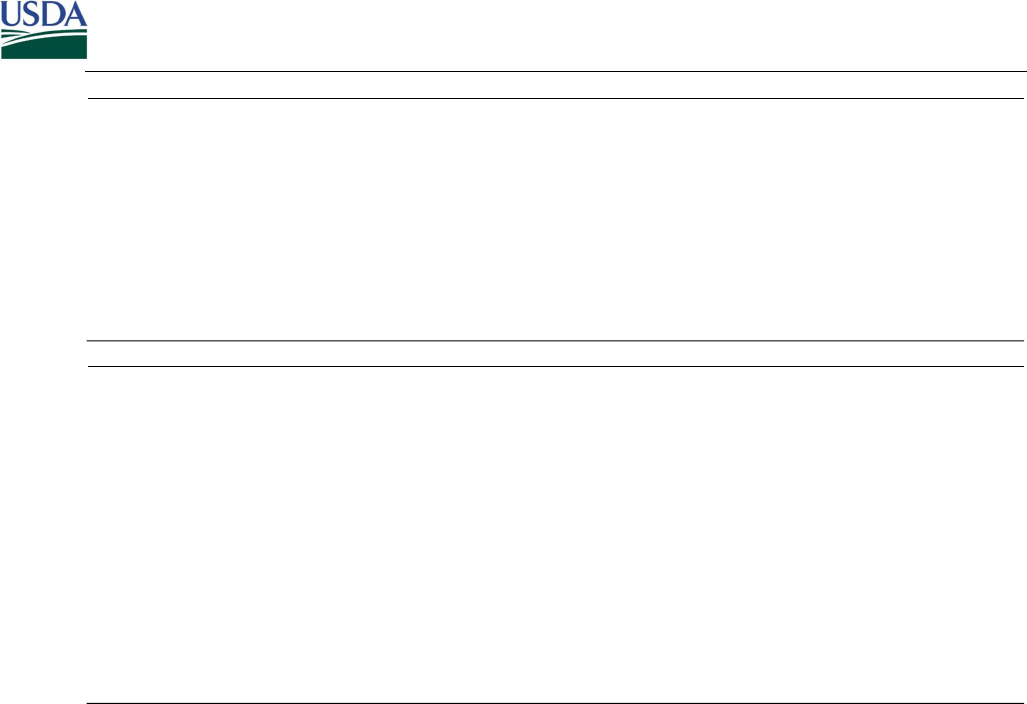
Partnerships for Climate‐Smart Commodities Data Dictionary for Recipients
February 2023
Version 1.0
Page 56 of 87
Field insets produced
Data element name: Field insets produced Reporting question: How many carbon insets have been
produced in this field?
Description: Total carbon insets produced in the field during the quarter (not cumulative). Insets are defined as
having been verified and certified using an accepted standard and accounted for within Scope 3 emissions for a
firm.
Data type: Decimal Select multiple values: No
Measurement unit: Metric tons CO
2
eq Allowed values: 0‐10,000,000
Logic: None – all respond Required: Yes
Data collection level: Field Data collection frequency: Quarterly
Other field measurement
Data element name: Other field
measurement
Reporting question: Were data collected from the field for
reasons other than GHG benefit estimation?
Description: Direct physical measurements or data collection taken in the field for any reason other than GHG
benefits estimation. These reasons could include calibration of GHG estimation tools or models, tracking other
environmental benefits (see Field environmental benefits report), and other reasons. If yes, submit
corresponding reports (see Supplemental data submission ‐ Field direct measurement results).
Data type: List Select multiple values: No
Measurement unit: Category Allowed values:
· Yes
· No
· I don’t know
Logic: None – all respond Required: Yes
Data collection level: Field Data collection frequency: Quarterly
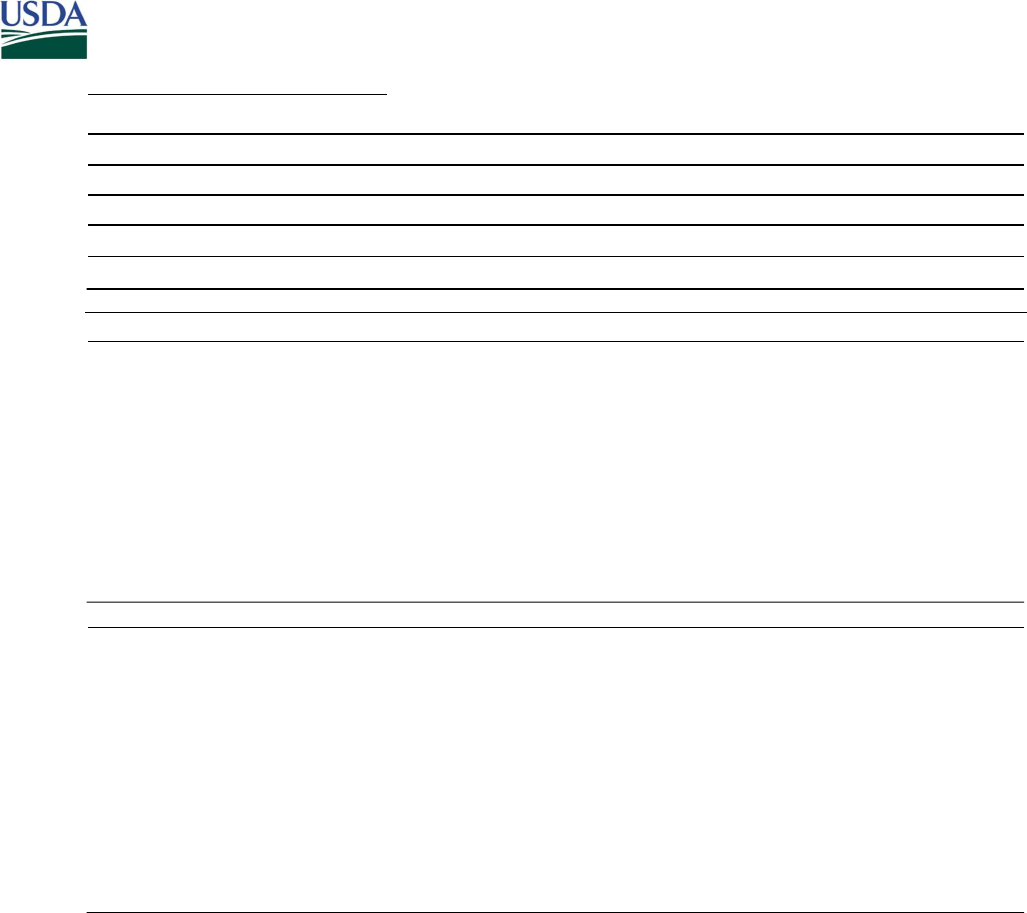
Partnerships for Climate‐Smart Commodities Data Dictionary for Recipients
February 2023
Version 1.0
Page 57 of 87
GHG Benefits ‐ Alternate Modeled
Unique IDs
Farm ID Unique Farm ID assigned by FSA
Tract ID Unique Tract ID assigned by FSA
Field ID Unique Field ID assigned by FSA
State or territory of field State name (must match FSA farm enrollment data)
County of field County name (must match FSA farm enrollment data)
Commodity type
Data element name: Commodity type 1‐6 Reporting question: What type of commodity(ies) is produced
from this field?
Description: Type of commodity(ies) produced in field enrolled in the project. See full list of commodity options
in Appendix B. The worksheet provides multiple columns with drop‐down lists of the allowed values. Choose
one value for each column. Leave unnecessary columns blank
Data type: List Select multiple values: No
Measurement unit: Category Allowed values: FSA commodity list
Logic: None – all respond Required: If project calculates GHG benefits using multiple
methods
Data collection level: Field Data collection frequency: Annual
Practice type
Data element name: Practice type 1‐7 Reporting question: What CSAF practice is being implemented
by this project?
Description: Which CSAF practice or practices are being implemented in this project? CSAF practices are
included in a list in Appendix A. The worksheet provides seven columns for this data element. Enter one value
for each column. If there are fewer than 7 practices being implemented by the project, leave unnecessary
columns blank.
Data type: List Select multiple values: No
Measurement unit: Category Allowed values: See list in Appendix A
Logic: None – all respond Required: If project calculates GHG benefits using multiple
methods
Data collection level: Field Data collection frequency: Annual

Partnerships for Climate‐Smart Commodities Data Dictionary for Recipients
February 2023
Version 1.0
Page 58 of 87
GHG model
Data element name: GHG model Reporting question: What model was used for alternate calculation of GHG benefits?
Description: Select the model used for the alternate calculation of the field’s GHG benefits.
Data type: List Select multiple values: No
Measurement unit: Category Allowed values:
·
ACC Calculator
·
Agriculture, Forestry and Other Land Use (AFOLU) Carbon Calculator
·
AIRES
·
APEX
·
Bowen Ratio Energy Balance
·
Carat‐Calculator
·
CArPE
·
CDFA web‐based calculator
·
COMET‐Farm
·
COMET‐Planner
·
CoolFarm
·
Cover Crop Explore
·
CropTrak
·
CultivateAI's FMIS
·
DayCent‐CR
·
DNDC
·
DSSAT
·
Earth Optics
·
EcoPractices
·
EPIC
·
Extrapolation based on literature
·
FieldPrint
·
Granular
·
GREET
·
gTIR
·
IFSM
·
IPCC default emissions factors & models
·
itree
·
Nitrogen Balance
·
Nutrient Tracking Tool (NTT)
·
RCD Project Tracker
·
Revised Universal Soil Loss equation 2 (RUSLE2)
·
RuFaS
·
SAFE‐Link
·
SALUS (CIBO)
·
SNAPGRAZE
·
SquareRoots
·
SWAT‐C
·
SYMFONI
·
Truterra Sustainability Tool
·
Verra
·
WEPP
·
YardStick
·
Other (specify)
Logic: None – all respond Required: If project calculates GHG benefits using multiple methods
Data collection level: Field Data collection frequency: Annual

Partnerships for Climate‐Smart Commodities Data Dictionary for Recipients
February 2023
Version 1.0
Page 59 of 87
Model start date
Data element name: Model start date Reporting question: For what time period are the
GHG benefits modeled (model start date)?
Description: Date that the model parameters begin.
Data type: Date Select multiple values: NA
Measurement unit: MM/DD/YYYY Allowed values: 01/01/1950 – 12/31/2030
Logic: None – all respond Required: If project calculates GHG benefits using
multiple methods
Data collection level: Field Data collection frequency: Annual
Model end date
Data element name: Model end date Reporting question: For what time period are the
GHG benefits modeled (model end date)?
Description: Date that the model parameters end.
Data type: Date Select multiple values: NA
Measurement unit: MM/DD/YYYY Allowed values: 01/01/2023– 12/31/2030
Logic: None – all respond Required: If project calculates GHG benefits using
multiple methods
Data collection level: Field Data collection frequency: Annual
Total GHG benefits estimated
Data element name: Total GHG benefits
estimated
Reporting question: What is the alternate estimate of the field’s
total GHG emission reductions?
Description: Total greenhouse gas emission reductions from practice implementation in the field estimated
using an alternate model.
Data type: Decimal Select multiple values: No
Measurement unit: Metric tons CO
2
eq Allowed values: 0‐10,000,000
Logic: None – all respond Required: If project calculates GHG benefits using multiple
methods
Data collection level: Field Data collection frequency: Annual
Total carbon stock estimated
Data element name: Total carbon stock
estimated
Reporting question: What is the alternate estimate of how much
carbon has the field has sequestered?
Description: Total change in carbon stock based on practice implementation in the field estimated using an
alternate model. Conversion rate is one ton of carbon = 3.67 tons of CO
2
eq.
Data type: Decimal Select multiple values: No
Measurement unit: Metric tons CO
2
eq Allowed values: 0‐10,000,000
Logic: None – all respond Required: If project calculates GHG benefits using multiple
methods
Data collection level: Field Data collection frequency: Annual
Total CO2 estimated
Data element name: Total CO2 estimated Reporting question: What is the alternate estimate of the field’s
total CO2 emission reductions?
Description: Total carbon dioxide emission reductions based on practice implementation in the field estimated
using an alternate model.
Data type: Decimal Select multiple values: No
Measurement unit: Metric tons CO
2
Allowed values: 0‐10,000,000
Logic: None – all respond Required: If project calculates GHG benefits using multiple
methods
Data collection level: Field Data collection frequency: Annual
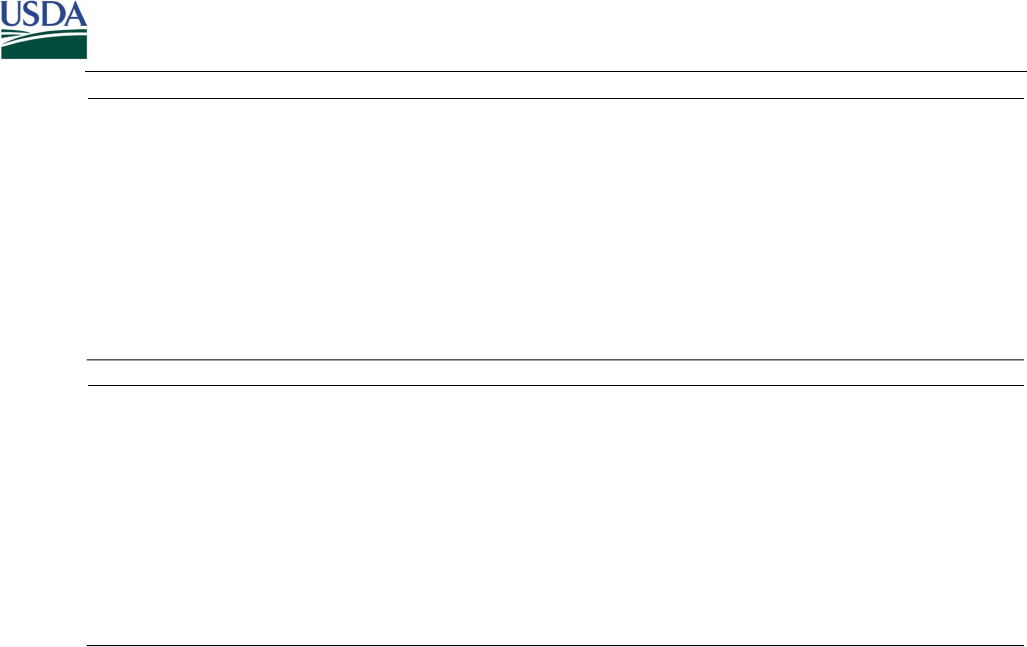
Partnerships for Climate‐Smart Commodities Data Dictionary for Recipients
February 2023
Version 1.0
Page 60 of 87
Total CH4 estimated
Data element name: Total CH4 estimated Reporting question: What is the alternate
estimate of the field’s total CH4 emission
reductions?
Description: Total methane emission reductions based on practice implementation in the field estimated using
an alternate model. Conversion rate is one ton of CH
4
= 25 tons of CO
2
eq.
Data type: Decimal Select multiple values: No
Measurement unit: Metric tons CH4 reduced in CO
2
eq Allowed values: 0‐10,000,000
Logic: None – all respond Required: If project calculates GHG
benefits using multiple methods
Data collection level: Field Data collection frequency: Annual
Total field N20 estimated
Data element name: Total N2O estimated Reporting question: What is the
alternate estimate of the field’s total
N2O emission reductions?
Description: Total nitrous oxide emission reductions based on practice implementation in the field estimated
using an alternate method. Conversion rate is one ton of N
2
O = 298 tons of CO
2
eq.
Data type: Decimal Select multiple values: No
Measurement unit: Metric tons N2O reduced in CO
2
eq Allowed values: 0‐10,000,000
Logic: None – all respond Required: If project calculates GHG
benefits using multiple methods
Data collection level: Field Data collection frequency: Annual

Partnerships for Climate‐Smart Commodities Data Dictionary for Recipients
February 2023
Version 1.0
Page 61 of 87
GHG Benefits ‐ Measured
Unique IDs
Farm ID Unique Farm ID assigned by FSA
Tract ID Unique Tract ID assigned by FSA
Field ID Unique Field ID assigned by FSA
State or territory of field State name (must match FSA farm enrollment data)
County of field County name (must match FSA farm enrollment data)
GHG measurement method
Data element name: GHG measurement method Reporting question: What
measurement method is used
to calculate GHG benefits?
Description: Field‐based measurement method used to calculate GHG benefits. If “other” is chosen, enter the
appropriate value as free text in the additional column.
Data type: List Select multiple values: No
Measurement unit: Category Allowed values:
·
Emissions measurement
unit
·
Flux towers
·
Litterbags
·
Plant measurements
·
Portable emissions
analyzers
·
Soil flux chambers
·
Soil samples
·
Soil sensors
·
Vehicle‐mounted sensors
·
Other (specify)
Logic: None – all respond Required: If a project conducts
soil samples or takes carbon
stock or greenhouse gas
emission measurements in this
field
Data collection level: Field Data collection frequency:
Annual
Lab name
Data element name: Lab name Reporting question: What is the name of the lab that
processed the measurement samples?
Description: Name of entity that received data and conducted analysis of samples.
Data type: Text Select multiple values: No
Measurement unit: NA Allowed values: Free text
Logic: None – all respond Required: If applicable
Data collection level: Field Data collection frequency: Annual

Partnerships for Climate‐Smart Commodities Data Dictionary for Recipients
February 2023
Version 1.0
Page 62 of 87
Measurement start date
Data element name: Measurement start date Reporting question: On what date did the
measurement start?
Description: Date that the measurements began. If it was a single point in time, use the same date for start date
and end date. If multiple measurements took place over a time period, use the date that the measurements first
began.
Data type: Date Select multiple values: No
Measurement unit: MM/DD/YYYY Allowed values: 01/01/2023 – 12/31/2030
Logic: None – all respond Required: If a project conducts soil samples or takes
carbon stock or greenhouse gas emission
measurements in this field
Data collection level: Field Data collection frequency: Annual
Measurement end date
Data element name: Measurement end date Reporting question: On what date did the
measurement end?
Description: Date that the measurements began. If it was a single point in time, use the same date for start date
and end date. If multiple measurements took place over a time period, use the date that the measurements
were completed.
Data type: Date Select multiple values: No
Measurement unit: MM/DD/YYYY Allowed values: 01/01/2023– 12/31/2030
Logic: None – all respond Required: If a project conducts soil samples or takes
carbon stock or greenhouse gas emission
measurements in this field
Data collection level: Field Data collection frequency: Annual
Total CO2 reduction calculated
Data element name: Total CO2 reduction calculated Reporting question: What are
the total measured CO2
emission reductions?
Description: Total annual CO2 emission reductions based on practice implementation in the field calculated
from in‐field measurements.
Data type: Decimal Select multiple values: No
Measurement unit: Metric tons CO
2
Allowed values: 0‐10,000,000
Logic: None – all respond Required: If a project takes
carbon stock or greenhouse gas
emission measurements in this
field
Data collection level: Field Data collection frequency:
Annual
Total field carbon stock measured
Data element name: Total field carbon stock
measured
Reporting question: What is the total amount of
carbon sequestered based on repeat measurements
in this field?
Description: Change in carbon stock based on practice implementation in the field calculated from repeat soil
sampling in this field. (Results for initial field soil samples should be reported in the ‘Soil sample result’ and
‘Measurement type” columns.) Conversion rate is one ton of carbon = 3.67 tons of CO
2
eq.
Data type: Decimal Select multiple values: No
Measurement unit: Metric tons CO
2
eq Allowed values: 0‐10,000,000
Logic: None – all respond Required: If a project conducts soil samples or takes
carbon stock measurements in this field
Data collection level: Field Data collection frequency: Annual

Partnerships for Climate‐Smart Commodities Data Dictionary for Recipients
February 2023
Version 1.0
Page 63 of 87
Total CH4 reduction calculated
Data element name: Total CH4 reduction calculated Reporting question: What are the total measured
CH4 emission reductions?
Description: Total annual methane emission reductions based on practice implementation in the field calculated
from in‐field measurements. Conversion rate is one ton of CH
4
= 25 tons of CO
2
eq.
Data type: Decimal Select multiple values: No
Measurement unit: Metric tons CH4 reduced in CO
2
eq Allowed values: 0‐10,000,000
Logic: None – all respond Required: If a project conducts soil samples or takes
carbon stock or greenhouse gas emission
measurements in this field
Data collection level: Field Data collection frequency: Annual
Total N20 reduction calculated
Data element name: Total N2O reduction calculated Reporting question: What are the total measured
N2O emission reductions?
Description: Total annual nitrous oxide emission reductions based on practice implementation in the field
calculated from in‐field measurements. Conversion rate is one ton of N
2
O = 298 tons of CO
2
eq.
Data type: Decimal Select multiple values: No
Measurement unit: Metric tons N2O reduced in CO
2
eq Allowed values: 0‐10,000,000
Logic: None – all respond Required: If a project conducts soil samples or takes
carbon stock or greenhouse gas emission
measurements in this field
Data collection level: Field Data collection frequency: Annual
Soil sample result
Data element name: Soil sample result Reporting question: What is the numeric result
from this soil sample?
Description: Results of measurement(s) taken to determine the carbon stock of a soil (the tons of carbon found
in a specified volume of soil).
Data type: Decimal Select multiple values: No
Measurement unit: Amount Allowed values: .00001‐100,000
Logic: None – all respond Required: If a project conducts soil samples in this
field
Data collection level: Field Data collection frequency: Annual

Partnerships for Climate‐Smart Commodities Data Dictionary for Recipients
February 2023
Version 1.0
Page 64 of 87
Soil sample result unit
Data element name: Soil sample result unit Reporting question: What is unit for the soil sample result?
Description: Unit for the corresponding soil sample result. The worksheet provides a drop‐down list of choices
for this data element. If “other” is chosen, use the additional column to enter the appropriate yield unit as free
text.
Data type: List Select multiple values: No
Measurement unit: Category Allowed values:
·
Percent
·
Ppm
·
Grams
·
Grams per cubic centimeter
·
Other (specify)
Logic: None – all respond Required: If a project conducts soil samples in this field
Data collection level: Field Data collection frequency: Annual
Measurement type
Data element name: Measurement type Reporting question: What type of analysis was conducted for
this soil sample?
Description: Type of soil analysis conducted. The worksheet provides a drop‐down list of choices for this data
element. If “other” is chosen, use the additional column to enter the appropriate yield unit as free text.
Data type: List Select multiple values: No
Measurement unit: Category Allowed values:
·
Organic matter
·
Total organic carbon
·
Bulk density
·
Other (specify)
Logic: None – all respond Required: If a project conducts soil samples in this field
Data collection level: Field Data collection frequency: Annual

Partnerships for Climate‐Smart Commodities Data Dictionary for Recipients
February 2023
Version 1.0
Page 65 of 87
Additional Environmental Benefits
Unique IDs
Farm ID Unique Farm ID assigned by FSA
Tract ID Unique Tract ID assigned by FSA
Field ID Unique Field ID assigned by FSA
State or territory of field State name (must match FSA farm enrollment data)
County of field County name (must match FSA farm enrollment data)
Environmental benefits
Data element name: Environmental
benefits
Reporting question: Are environmental benefits other than
GHGs being tracked in the field?
Description: Tracking of environmental benefits other than greenhouse gas emission reductions and carbon
sequestration in the enrolled field. Tracking means at a minimum using some form of monitoring and reporting
that can quantify benefits.
Data type: List Select multiple values: No
Measurement unit: Category Allowed values:
·
Yes
·
No
·
I don’t know
Logic: None – all respond Required: Yes
Data collection level: Field Data collection frequency: Annual
Reduction in nitrogen loss
Data element name: Reduction in nitrogen
loss
Reporting question: Are reductions in nitrogen losses being
tracked in the field?
Description: Tracking reductions in nitrogen losses in the enrolled field. Tracking means at a minimum using
some form of monitoring and reporting that can quantify benefits.
Data type: List Select multiple values: No
Measurement unit: Category Allowed values:
·
Yes
·
No
·
I don’t know
Logic: Respond if yes to ‘Environmental
benefits’
Required: Yes
Data collection level: Field Data collection frequency: Annual
Reduction in nitrogen loss amount
Data element
name: Reduction in nitrogen loss amount
Reporting question: How much reduction in nitrogen losses
have been measured in the field?
Description: Total amount of reduction in nitrogen losses that is measured and reported in the enrolled field.
Data type: Decimal Select multiple values: No
Measurement unit: Amount Allowed values: 0‐1,000,000
Logic: Respond if yes to ‘Reduction in
nitrogen loss’
Required: Yes
Data collection level: Field Data collection frequency: Annual

Partnerships for Climate‐Smart Commodities Data Dictionary for Recipients
February 2023
Version 1.0
Page 66 of 87
Reduction in nitrogen loss amount unit
Data element name: Reduction in nitrogen
loss amount unit
Reporting question: What is the unit for how much reduction in
nitrogen losses have been measured in the field?
Description: Unit for the total amount of reduction in nitrogen losses that is measured and reported in the
enrolled field. If “other” is chosen, enter the appropriate value as free text in the additional column.
Data type: List Select multiple values: No
Measurement unit: Category Allowed values:
·
Kilograms
·
Metric tons
·
Pounds
·
Other (specify)
Logic: Respond if yes to ‘Reduction in
nitrogen loss’
Required: Yes
Data collection level: Field Data collection frequency: Annual
Reduction in nitrogen loss purpose
Data element name: Reduction in nitrogen
loss purpose
Reporting question: What is the purpose of tracking reduction in
nitrogen losses?
Description: Purpose of tracking reduction in nitrogen losses in the enrolled field. If “other” is chosen, enter the
appropriate value as free text in the additional column.
Data type: List Select multiple values: No
Measurement unit: Category Allowed values:
·
Commodity marketing
·
Producing insets
·
Producing offsets
·
I don’t know
·
Other (specify)
Logic: Respond if yes to ‘Reduction in
nitrogen loss’
Required: Yes
Data collection level: Project Data collection frequency: Annual
Reduction in phosphorus loss
Data element name: Reduction in
phosphorus loss
Reporting question: Are reductions in phosphorus losses being
tracked in the field?
Description: Tracking of reductions in phosphorus losses in the enrolled field. Tracking means at a minimum
using some form of monitoring and reporting that can quantify benefits.
Data type: List Select multiple values: No
Measurement unit: Category Allowed values:
·
Yes
·
No
·
I don’t know
Logic: Respond if yes to ‘Environmental
benefits’
Required: Yes
Data collection level: Field Data collection frequency: Annual
Reduction in phosphorus loss amount
Data element name: Reduction in
phosphorus loss amount
Reporting question: How much reduction in phosphorus losses
have been measured in the field?
Description: Total amount of reduction in phosphorus losses that is measured in the field.
Data type: Decimal Select multiple values: No
Measurement unit: Amount Allowed values: 0‐1,000,000
Logic: Respond if yes to ‘Reduction in
phosphorus loss’
Required: Yes
Data collection level: Field Data collection frequency: Annual

Partnerships for Climate‐Smart Commodities Data Dictionary for Recipients
February 2023
Version 1.0
Page 67 of 87
Reduction in phosphorus loss amount unit
Data element name: Reduction in
phosphorus loss amount unit
Reporting question: What is the unit for the reduction in
phosphorus losses measured in the field?
Description: Unit for the total amount of reduction in phosphorus losses that is measured in the enrolled field. If
“other” is chosen, enter the appropriate value as free text in the additional column.
Data type: List Select multiple values: No
Measurement unit: Category Allowed values:
·
Kilograms
·
Metric tons
·
Pounds
·
Other (specify)
Logic: Respond if yes to ‘Reduction in
phosphorus loss’
Required: Yes
Data collection level: Field Data collection frequency: Annual
Reduction in phosphorus loss purpose
Data element name: Reduction in
phosphorus loss purpose
Reporting question: What is the purpose of tracking reductions
in phosphorus losses?
Description: Purpose of tracking reduction in phosphorus losses in the enrolled field. If “other” is chosen, enter
the appropriate value as free text in the additional column.
Data type: List Select multiple values: No
Measurement unit: Category Allowed values:
·
Commodity marketing
·
Producing insets
·
Producing offsets
·
I don’t know
·
Other (specify)
Logic: Respond if yes to ‘Reduction in
phosphorus loss’
Required: Yes
Data collection level: Field Data collection frequency: Annual
Other water quality
Data element name: Other water quality Reporting question: Are other water quality metrics being
tracked in the field?
Description: Project tracking of other water quality metrics in the enrolled field. Tracking means at a minimum
using some form of monitoring and reporting that can quantify benefits.
Data type: List Select multiple values: No
Measurement unit: Category Allowed values:
·
Yes
·
No
·
I don’t know
Logic: Respond if yes to ‘Environmental
benefits’
Required: Yes
Data collection level: Field Data collection frequency: Annual

Partnerships for Climate‐Smart Commodities Data Dictionary for Recipients
February 2023
Version 1.0
Page 68 of 87
Other water quality type
Data element name: Other water quality
type
Reporting question: What type of other water quality metric
have been measured in the field?
Description: Type of other water quality metric (besides nitrogen loss and phosphorus loss reductions) that is
measured in the field. If “other” is chosen, enter the appropriate value as free text in the additional column.
Data type: List Select multiple values: No
Measurement unit: Category Allowed values:
· Sediment load reduction
· Temperature
· Other (specify)
Logic: Respond if yes to ‘Other water
quality’
Required: Yes
Data collection level: Field Data collection frequency: Annual
Other water quality amount
Data element name: Other water quality
amount
Reporting question: How much reduction in other water quality
metrics have been measured in the field?
Description: Total amount of reduction in other water quality metrics that is measured in the enrolled field.
Data type: Decimal Select multiple values: No
Measurement unit: Amount Allowed values: 0‐1,000,000
Logic: Respond if yes to ‘Other water
quality’
Required: Yes
Data collection level: Field Data collection frequency: Annual
Other water quality amount unit
Data element name: Other water quality
amount unit
Reporting question: What is the unit for the reduction in other
water quality metrics measured in the field?
Description: Unit for the total amount of reduction in other water quality metrics that is measured in the
enrolled field. If “other” is chosen, enter the appropriate value as free text in the additional column.
Data type: List Select multiple values: No
Measurement unit: Category Allowed values:
· Degrees F
· Kilograms
· Kilograms per liter
· Metric tons
· Pounds
· Other (specify)
Logic: Respond if yes to ‘Other water
quality’
Required: Yes
Data collection level: Field Data collection frequency: Annual

Partnerships for Climate‐Smart Commodities Data Dictionary for Recipients
February 2023
Version 1.0
Page 69 of 87
Other water quality purpose
Data element name: Other water quality
purpose
Reporting question: What is the purpose of tracking other water
quality benefits?
Description: Purpose of tracking other water quality benefits in the enrolled field. If “other” is chosen, enter the
appropriate value as free text in the additional column.
Data type: List Select multiple values: No
Measurement unit: Category Allowed values:
· Commodity marketing
· Producing insets
· Producing offsets
· I don’t know
· Other (specify)
Logic: Respond if yes to ‘Other water
quality’
Required: Yes
Data collection level: Field Data collection frequency: Annual
Water quantity
Data element name: Water quantity Reporting question: Is water conservation being tracked in the
field?
Description: Tracking of water conservation or reduction in use in the enrolled field. Tracking means at a
minimum using some form of monitoring and reporting that can quantify benefits.
Data type: List Select multiple values: No
Measurement unit: Category Allowed values:
· Yes
· No
· I don’t know
Logic: Respond if yes to ‘Environmental
benefits’
Required: Yes
Data collection level: Field Data collection frequency: Annual
Water quantity amount
Data element name: Water quantity
amount
Reporting question: How much water conservation has been
measured in the field?
Description: Total amount of water conservation or reduction that is measured in the field.
Data type: Decimal Select multiple values: No
Measurement unit: Amount Allowed values: 0‐1,000,000
Logic: Respond if yes to ‘Water quantity’ Required: Yes
Data collection level: Field Data collection frequency: Annual
Water quantity amount unit
Data element name: Water quantity
amount unit
Reporting question: What is the unit for the amount of water
conservation measured in the field?
Description: Unit for the total amount of water conservation or reduced use that is measured and reported in
the enrolled field. If “other” is chosen, enter the appropriate value as free text in the additional column.
Data type: List Select multiple values: No
Measurement unit: Category Allowed values:
· Acre‐feet
· Cubic feet
· Other (specify)
Logic: Respond if yes to ‘Water quantity’ Required: Yes
Data collection level: Field Data collection frequency: Annual

Partnerships for Climate‐Smart Commodities Data Dictionary for Recipients
February 2023
Version 1.0
Page 70 of 87
Water quantity purpose
Data element name: Water quantity
purpose
Reporting question: What is the purpose of tracking water
conservation?
Description: Purpose of tracking water conservation or reductions in water use in the enrolled field. If “other” is
chosen, enter the appropriate value as free text in the additional column.
Data type: List Select multiple values: No
Measurement unit: Category Allowed values:
· Commodity marketing
· Producing insets
· Producing offsets
· I don’t know
· Other (specify)
Logic: Respond if yes to ‘Water quantity’ Required: Yes
Data collection level: Field Data collection frequency: Annual
Reduced erosion
Data element name: Reduced erosion Reporting question: Is reduced soil erosion being tracked in the
field?
Description: Tracking of reduced soil erosion in the enrolled field. Tracking means at a minimum using some
form of monitoring and reporting that can quantify benefits.
Data type: List Select multiple values: No
Measurement unit: Category Allowed values:
· Yes
· No
· I don’t know
Logic: Respond if yes to ‘Environmental
benefits’
Required: Yes
Data collection level: Field Data collection frequency: Annual
Reduced erosion amount
Data element name: Reduced erosion
amount
Reporting question: How much erosion reduction has been
measured in the field?
Description: Total amount of erosion reduction that is measured in the enrolled field.
Data type: Decimal Select multiple values: No
Measurement unit: Amount Allowed values: 0‐1,000,000
Logic: Respond if yes to ‘Reduced erosion’ Required: Yes
Data collection level: Field Data collection frequency: Annual
Reduced erosion amount unit
Data element name: Reduced erosion unit Reporting question: What is the unit for the amount of erosion
reduction measured?
Description: Unit for the total amount of erosion reduction from enrolled fields that is measured and reported
by the project. If “other” is chosen, enter the appropriate value as free text in the additional column.
Data type: List Select multiple values: No
Measurement unit: Category Allowed values:
· Tons
· Other (specify)
Logic: Respond if yes to ‘Reduced erosion’ Required: Yes
Data collection level: Field Data collection frequency: Annual

Partnerships for Climate‐Smart Commodities Data Dictionary for Recipients
February 2023
Version 1.0
Page 71 of 87
Reduced erosion purpose
Data element name: Reduced erosion
purpose
Reporting question: What is the purpose of tracking reduced
erosion in the field?
Description: Purpose of tracking reduced erosion the enrolled field. If “other” is chosen, enter the appropriate
value as free text in the additional column.
Data type: List Select multiple values: No
Measurement unit: Category Allowed values:
· Commodity marketing
· Producing insets
· Producing offsets
· I don’t know
· Other (specify)
Logic: Respond if yes to ‘Reduced erosion’ Required: Yes
Data collection level: Field Data collection frequency: Annual
Reduced energy use
Data element name: Reduced energy use Reporting question: Is reduced energy use being tracked in the
field?
Description: Tracking of reduced energy use in the enrolled field. Tracking means at a minimum using some
form of monitoring and reporting that can quantify benefits.
Data type: List Select multiple values: No
Measurement unit: Category Allowed values:
· Yes
· No
· I don’t know
Logic: Respond if yes to ‘Environmental
benefits’
Required: Yes
Data collection level: Field Data collection frequency: Annual
Reduced energy use amount
Data element name: Reduced energy use
amount
Reporting question: How much energy use reduction has been
measured in the field?
Description: Total amount of energy use reduction that is measured in the enrolled field.
Data type: Decimal Select multiple values: No
Measurement unit: Amount Allowed values: 0‐1,000,000
Logic: Respond if yes to ‘Reduced energy
use’
Required: Yes
Data collection level: Field Data collection frequency: Annual
Reduced energy use amount unit
Data element name: Reduced energy use
unit
Reporting question: What is the unit for the energy use
reduction measured in the field?
Description: Unit for the total amount of energy use reduction that is measured in the enrolled field. If “other”
is chosen, enter the appropriate value as free text in the additional column.
Data type: List Select multiple values: No
Measurement unit: Category Allowed values:
· Kilowatt hours
· Other (specify)
Logic: Respond if yes to ‘Reduced energy
use’
Required: Yes
Data collection level: Field Data collection frequency: Annual

Partnerships for Climate‐Smart Commodities Data Dictionary for Recipients
February 2023
Version 1.0
Page 72 of 87
Reduced energy use purpose
Data element name: Reduced energy use
purpose
Reporting question: What is the purpose of tracking reduced
energy use in the field?
Description: Purpose of tracking reduced energy use in the enrolled field. If “other” is chosen, enter the
appropriate value as free text in the additional column.
Data type: List Select multiple values: No
Measurement unit: Category Allowed values:
· Commodity marketing
· Producing insets
· Producing offsets
· I don’t know
· Other (specify)
Logic: Respond if yes to ‘Reduced energy
use’
Required: Yes
Data collection level: Field Data collection frequency: Annual
Avoided land conversion
Data element name: Avoided land
conversion
Reporting question: Is avoided land conversion being tracked in
the field?
Description: Tracking of avoided land conversion in the enrolled field. Tracking means at a minimum using some
form of monitoring and reporting that can quantify benefits. Land conservation means land use changing from
agricultural uses to non‐agricultural uses.
Data type: List Select multiple values: No
Measurement unit: Category Allowed values:
· Yes
· No
· I don’t know
Logic: Respond if yes to ‘Environmental
benefits’
Required: Yes
Data collection level: Field Data collection frequency: Annual
Avoided land conversion amount
Data element name: Avoided land
conversion amount
Reporting question: How much avoided land conversion has
been measured in the field?
Description: Total amount of avoided land conversion that is measured in the enrolled field.
Data type: Decimal Select multiple values: No
Measurement unit: Amount Allowed values: 0‐1,000,000
Logic: Respond if yes to ‘Avoided land
conversion’
Required: Yes
Data collection level: Field Data collection frequency: Annual
Avoided land conversion amount unit
Data element name: Avoided land
conversion unit
Reporting question: What is the unit for the amount of avoided
land conversion measured in the field?
Description: Unit for the total amount of avoided land conversion that is measured in the enrolled field. If
“other” is chosen, enter the appropriate value as free text in the additional column.
Data type: List Select multiple values: No
Measurement unit: Category Allowed values:
· Acres
· Other (specify)
Logic: Respond if yes to ‘Avoided land
conversion’
Required: Yes
Data collection level: Field Data collection frequency: Annual

Partnerships for Climate‐Smart Commodities Data Dictionary for Recipients
February 2023
Version 1.0
Page 73 of 87
Avoided land conversion purpose
Data element name: Avoided land
conversion purpose
Reporting question: What is the purpose of tracking avoided
land conversion in the field?
Description: Purpose of tracking avoided land conversion in the enrolled field. If “other” is chosen, enter the
appropriate value as free text in the additional column.
Data type: List Select multiple values: No
Measurement unit: Category Allowed values:
· Commodity marketing
· Producing insets
· Producing offsets
· I don’t know
· Other (specify)
Logic: Respond if yes to ‘Avoided land
conversion’
Required: Yes
Data collection level: Field Data collection frequency: Annual
Improved wildlife habitat
Data element name: Improved wildlife
habitat
Reporting question: Are improvements to wildlife habitat being
tracked in the field?
Description: Tracking of improvements to wildlife in and around the enrolled field. Tracking means at a
minimum using some form of monitoring and reporting that can quantify benefits.
Data type: List Select multiple values: No
Measurement unit: Category Allowed values:
· Yes
· No
· I don’t know
Logic: Respond if yes to ‘Environmental
benefits’
Required: Yes
Data collection level: Field Data collection frequency: Annual
Improved wildlife habitat amount
Data element name: Improved wildlife
habitat amount
Reporting question: How much improved wildlife habitat has
been measured in the field?
Description: Total amount of improved wildlife habitat that is measured in and around the enrolled fields.
Data type: Decimal Select multiple values: No
Measurement unit: Amount Allowed values: 0‐1,000,000
Logic: Respond if yes to ‘Improved wildlife
habitat’
Required: Yes
Data collection level: Field Data collection frequency: Annual
Improved wildlife habitat amount unit
Data element name: Improved wildlife
habitat unit
Reporting question: What is the unit for the amount of improved
wildlife habitat measured in the field?
Description: Unit for the total amount of improved wildlife habitat that is measured in and around enrolled
fields. If “other” is chosen, enter the appropriate value as free text in the additional column.
Data type: List Select multiple values: No
Measurement unit: Category Allowed values:
· Acres
· Linear feet
· Other (specify)
Logic: Respond if yes to ‘Improved wildlife
habitat’
Required: Yes
Data collection level: Field Data collection frequency: Annual
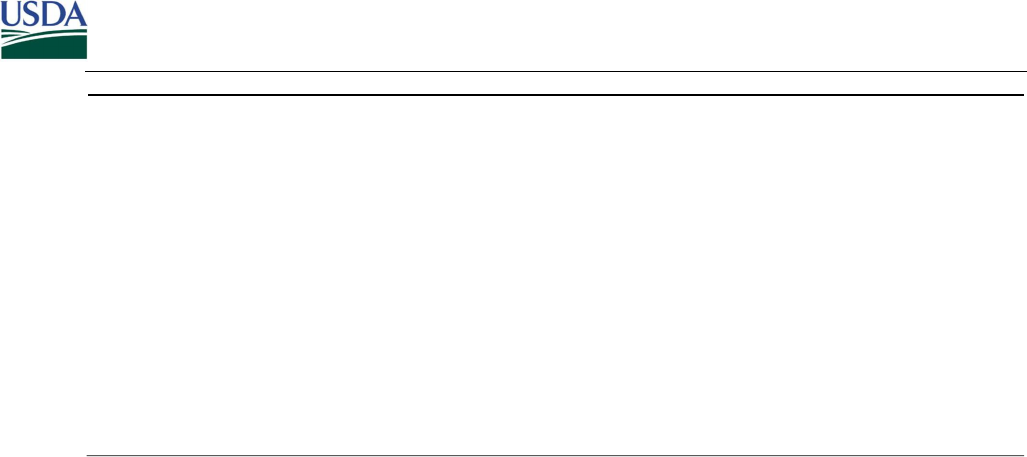
Partnerships for Climate‐Smart Commodities Data Dictionary for Recipients
February 2023
Version 1.0
Page 74 of 87
Improved wildlife habitat purpose
Data element name: Improved wildlife
habitat purpose
Reporting question: What is the purpose of tracking improved
wildlife habitat in the field?
Description: Purpose of tracking improved wildlife habitat in the enrolled field. If “other” is chosen, enter the
appropriate value as free text in the additional column.
Data type: List Select multiple values: No
Measurement unit: Category Allowed values:
· Commodity marketing
· Producing insets
· Producing offsets
· I don’t know
· Other (specify)
Logic: Respond if yes to ‘Improved wildlife
habitat’
Required: Yes
Data collection level: Field Data collection frequency: Annual

Partnerships for Climate‐Smart Commodities Data Dictionary for Recipients
February 2023
Version 1.0
Page 75 of 87
CSAF Practice Sub‐questions
For some CSAF practices, there is an additional set of questions that are unique to each practice. Responses to
these questions are needed to verify estimated GHG benefits of these practices. If a field is implementing a CSAF
practice with an NRCS CPS code in Table 11, answer the follow‐up questions listed next to the relevant practice
name in the table. Use the Supplemental Reporting Workbook – CSAF Practice Sub‐questions to report the required
information.
Table 11. Follow‐on questions for select CSAF practices
Practice name and code Follow‐up question Options (select one)
Alley Cropping (CPS 311)
Species category (select
most common/extensive
type if using more than
Coniferous trees
Deciduous trees
Shrubs
one)
Anaerobic Digester (CPS 366)
Species density (number of
trees planted per acre)
Waste storage system prior
to installing anaerobic
digester
1‐10,000
Aerobic lagoon
Anaerobic digester (complex mix) with energy
generation
Anaerobic digester (plug flow) with energy
generation
Anaerobic lagoon
Composting
Covered lagoon (no energy generation or flaring)
Covered lagoon with energy generation
Covered lagoon with flaring
Daily spread
Deep bedding pack
Deep pit
Dry lot
Dry stacking/solid storage
Pasture/range/paddock
Poultry with bedding
Poultry without bedding (e.g., high rise)
Slurry tank/basin
Covered lagoon with energy generation
Covered lagoon with flaring
Digester type
Covered lagoon (no energy generation or flaring)
Complex mix with energy generation
Plug flow with energy generation
Other (specify)
Additional feedstock
source (select most
common if using more than
one)
Food waste
Straw or bedding
Wastewater
Other (specify)

Partnerships for Climate‐Smart Commodities Data Dictionary for Recipients
February 2023
Version 1.0
Page 76 of 87
Fuel type before installation
Coal
Diesel
Electricity
Gasoline
Kerosene
Liquified petroleum gas (LPG)
Natural gas
Propane
Wood
Other (specify)
Fuel amount before installation 0‐1,000,000
Cubic feet (natural gas)
Combustion System
Improvement (CPS 372)
Fuel amount unit before
installation
Fuel type after installation
Gallons (diesel, gasoline, propane, LPG, kerosene) Kilowatt‐
hours (electricity)
Pounds (wood, coal)
Other (specify)
Coal
Diesel
Electricity
Gasoline
Kerosene
Liquified petroleum gas (LPG)
Natural gas
Propane
Wood
Other (specify)
Fuel amount after installation 0‐1,000,000
Cubic feet (natural gas)
Fuel amount unit after
installation
Gallons (diesel, gasoline, propane, LPG, kerosene) Kilowatt‐
hours (electricity)
Pounds (wood, coal)
Other (specify)
Brassicas
Conservation Cover
(CPS 327)
Species category (select most
common/extensive type if
using more than one)
Grasses
Legumes
Non‐legume broadleaves
Shrubs

Partnerships for Climate‐Smart Commodities Data Dictionary for Recipients
February 2023
Version 1.0
Page 77 of 87
Conservation Crop Rotation
(CPS 328)
Conservation crop type
Change implemented
Conservation crop rotation tillage type
Total conservation crop rotation length in
days
Brassica
Broadleaf
Cool season
Grass
Legume
Warm season
Added perennial crop
Reduced fallow period
Both
Conventional (plow, chisel, disk) No‐
till, direct seed
Reduced till
Strip till
None
Other (specify)
1‐120
Contour Buffer Strips (CPS
Strip width (feet) 1‐100
Grasses
332)
Cover Crop (CPS 340)
Critical Area Planting (CPS
342)
Species category
Species category (select most
common/extensive type if using more
than one)
Cover crop planned management
Cover crop termination method
Species category (select most
common/extensive type if using more
than one)
Forbs
Mix
Brassicas
Forbs
Grasses
Legume
Non‐legume broadleaves
Grazing
Haying
Termination
Burning
Herbicide application
Incorporation
Mowing
Rolling/crimping
Winter kill/frost
Grass
Grass legume/forb mix
Herbaceous woody mix
Perennial or reseeding
Shrubs
Trees
Feed Management (CPS 592)
Crude protein (percent) 0‐100
Fat (percent) 0‐100
Chemical
Field Border (CPS 386)
Feed additives/supplements
Species category (select most
common/extensive type if using more
than one)
Edible oils/fats
Seaweed/kelp
Other (specify)
Forbs
Grasses
Mix
Shrubs

Partnerships for Climate‐Smart Commodities Data Dictionary for Recipients
February 2023
Version 1.0
Page 78 of 87
Strip width (feet) 20‐1,000
Filter Strip (CPS 393)
Species category (select most
common/extensive type if using
more than one)
Forbs
Grasses
Mix
Shrubs
Forest
Multi‐story cropping
Forest Farming (CPS 379) Land use in previous year Pasture/grazing land
Row crops
Other agroforestry
Maintain or improve forest carbon stocks
Maintain or improve forest health and
productivity
Maintain or improve forest structure and
Forest Stand
Improvement (CPS 666)
Grassed Waterway (CPS
412)
Hedgerow Planting (CPS
422)
Herbaceous Wind
Barriers (CPS 603)
Purpose for implementation
Species category (select most
common/extensive type if using
more than one)
Species category (select most
common/extensive type if using
more than one)
Species density (number of trees
planted per acre)
Species category (select most
common/extensive type if using
more than one)
composition
Maintain or improve wildlife, fish, and
pollinator habitat
Manage natural precipitation more efficiently
Reduce forest pest pressure
Reduce forest wildfire hazard
Flowering Plants
Forbs
Grasses
Grasses
Shrubs
Trees
1‐10,000
Forbs
Grasses
Mix
Shrubs
Barrier width (feet) 1‐1,000
Number of rows 1‐100
Gravel
Mulching (CPS 484)
Mulch type
Natural
Synthetic
Wood
Mulch cover (percent of field) 0‐100

Partnerships for Climate‐Smart Commodities Data Dictionary for Recipients
February 2023
Version 1.0
Page 79 of 87
Nutrient management
(CPS 590)
Nutrient type with CPS 590
Nutrient application method with CPS 590
Nutrient application method in the previous
year
Nutrient application timing with CPS 590
Nutrient application timing in the previous
year
Biosolids
Commercial fertilizers
Compost
EEF (nitrification inhibitor)
EEF (slow or controlled release)
EEF (urease inhibitor)
Green manure
Liquid animal manure
Organic by‐products
Organic residues or materials Solid/semi‐
solid animal manure Wastewater
Banded
Broadcast
Injection
Irrigation
Surface application
Surface application with tillage
Variable rate
Banded
Broadcast
Injection
Irrigation
Surface application
Surface application with tillage
Variable rate
Single pre‐planting
Single post‐planting
Split pre‐ and post‐planting
Split post‐planting
Single pre‐planting
Single post‐planting
Split pre‐ and post‐planting
Split post‐planting
Nutrient application rate with CPS 590 0‐20,000
Gallons per acre
Nutrient application rate unit with CPS 590 Pounds per acre
Pasture and Hay Planting
(CPS 512)
Prescribed Grazing (CPS
528)
Nutrient application rate change
Species category (select most
common/extensive type if using more than
one)
Termination process
Grazing type
Decrease compared to previous
year
Increase compared to previous
year
No change Cool‐
season broadleaf
Cool‐season grass
Warm‐season broadleaf
Warm‐season grass
Grazing
Haying (i.e., cutting and baling)
Other (specify)
Cell grazing
Deferred rotational
Management intensive
Rest‐rotation

Partnerships for Climate‐Smart Commodities Data Dictionary for Recipients
February 2023
Version 1.0
Page 80 of 87
Range Planting (CPS 550)
Residue and Tillage
Management – No‐till
(CPS 329)
Residue and Tillage
Management – Reduced
Till (CPS 345)
Riparian Forest Buffer
(CPS 391)
Riparian Herbaceous
Cover (CPS 390)
Roofs and Covers (CPS
Species category (select most
common/extensive type if using more than
one)
Surface disturbance
Surface disturbance
Species category (select most
common/extensive type if using more than
one)
Species density (number of trees planted per
acre)
Species category (select most
common/extensive type if using more than
one)
Forbs
Grasses
Legumes
Shrubs
Trees
None
Seed row only
None
Seed row/ridge tillage for
planting
Shallow across most of the soil
surface
Vertical/mulch
Coniferous trees
Deciduous trees
Shrubs
1‐10,000
Ferns
Forbs
Grasses
Legumes
Rushes
Sedges
Concrete
Flexible geomembrane
367)
Roof/cover type
Species category (select most
common/extensive type if using more than
Metal
Timber
Other (specify)
Coniferous trees
Deciduous trees
Silvopasture (CPS 381)
one)
Species density (number of trees planted per
acre)
Forage
Shrubs
1‐10,000
Strip width (feet) 1‐1,000
Stripcropping (CPS 585)
Crop category (select most common/extensive
type if using more than one)
Erosion resistant crops
Fallow
Sediment trapping crops
Number of strips 2‐100
Tree/Shrub Establishment
(CPS 612)
Vegetative Barrier (CPS
601)
Species category (select most
common/extensive type if using more than
one)
Species density (number of trees planted per
acre)
Species category (select most
common/extensive type if using more than
one)
Coniferous trees
Deciduous trees
Shrubs
1‐10,000
Grasses
Grass forb mix
Grass legume mix
Barrier width (feet) 3‐1,000

Partnerships for Climate‐Smart Commodities Data Dictionary for Recipients
February 2023
Version 1.0
Page 81 of 87
Separation type
Chemical (e.g., salts, polymers)
Mechanical (e.g., screens, presses)
Waste Separation Facility
(CPS 632)
Settling basin
Bedding
Waste Storage Facility (CPS
313)
Most common use of solids
Waste storage system prior to
installing your waste storage facility
Field applied
Other (specify)
Aerobic lagoon
Anaerobic digester (complex mix) with
energy generation
Anaerobic digester (plug flow) with
energy generation
Anaerobic lagoon
Composting
Covered lagoon (no energy generation
or flaring)
Covered lagoon with energy generation
Covered lagoon with flaring
Daily spread
Deep bedding pack
Deep pit
Dry lot
Dry stacking/solid storage
Pasture/range/paddock
Poultry with bedding
Poultry without bedding (e.g., high rise)
Slurry tank/basin
Biological
Waste Treatment (CPS 629)
Treatment type
Waste storage system prior to
installing waste treatment lagoon
Waste Treatment Lagoon
(CPS 359)
Chemical
Mechanical
Aerobic lagoon
Anaerobic digester (complex mix) with
energy generation
Anaerobic digester (plug flow) with
energy generation
Anaerobic lagoon
Composting
Covered lagoon (no energy generation
or flaring)
Covered lagoon with energy generation
Covered lagoon with flaring
Daily spread
Deep bedding pack
Deep pit
Dry lot
Dry stacking/solid storage
Pasture/Range/Paddock
Poultry with bedding
Poultry without bedding (e.g., high rise)
Slurry tank/basin
Is there a lagoon cover/crust?
Yes
No
Is there lagoon aeration?
Yes
No

Partnerships for Climate‐Smart Commodities Data Dictionary for Recipients
February 2023
Version 1.0
Page 82 of 87
Windbreak/Shelterbelt
Establishment and
Renovation (CPS 380)
Species category (select most
common/extensive type if using
more than one)
Species density (number of trees
Coniferous trees
Deciduous trees
Shrubs
1‐10,000
planted per acre)

Partnerships for Climate‐Smart Commodities Data Dictionary for Recipients
February 2023
Version 1.0
Page 83 of 87
Appendix A: Climate‐smart Agriculture and Forestry Practices
All NRCS Practice Standards (not limited to climate‐smart practices)
309, Agrichemical Handling Facility
311, Alley Cropping
313, Waste Storage Facility
314, Brush Management
315, Herbaceous Weed Treatment
316, Animal Mortality Facility
317, Composting Facility
318, Short Term Storage of Animal Waste and By‐Products
319, On‐Farm Secondary Containment Facility
320, Irrigation Canal or Lateral
324, Deep Tillage
325, High Tunnel System
326, Clearing and Snagging
327, Conservation Cover
328, Conservation Crop Rotation
329, Residue and Tillage Management, No Till
330, Contour Farming
331, Contour Orchard and Other Perennial Crops
332, Contour Buffer Strips
333, Amending Soil Properties with Gypsum Products
334, Controlled Traffic Farming
336, Soil Carbon Amendment
338, Prescribed Burning
340, Cover Crop
342, Critical Area Planting
345, Residue and Tillage Management, Reduced Till
348, Dam, Diversion
350, Sediment Basin
351, Well Decommissioning
353, Monitoring Well
355, Groundwater Testing
356, Dike and Levee
359, Waste Treatment Lagoon
360, Waste Facility Closure
362, Diversion
366, Anaerobic Digester
367, Roofs and Covers
368, Emergency Animal Mortality Management
371, Air Filtration and Scrubbing
372, Combustion System Improvement
373, Dust Control on Unpaved Roads and Surfaces
374, Energy Efficient Agricultural Operation
375, Dust Management for Pen Surfaces
376, Field Operations Emissions Reduction
378, Pond
379, Forest Farming
380, Windbreak/Shelterbelt Establishment and Renovation
381, Silvopasture
382, Fence
383, Fuel Break
384, Woody Residue Treatment
386, Field Border
388, Irrigation Field Ditch
390, Riparian Herbaceous Cover
391, Riparian Forest Buffer
393, Filter Strip
394, Firebreak
395, Stream Habitat Improvement and Management
396, Aquatic Organism Passage
397, Aquaculture Pond
398, Fish Raceway or Tank
399, Fishpond Management
400, Bivalve Aquaculture Gear and Biofouling Control
402, Dam
410, Grade Stabilization Structure
412, Grassed Waterway
420, Wildlife Habitat Planting
422, Hedgerow Planting
423, Hillside Ditch
428, Irrigation Ditch Lining
428A, Irrigation Water Conveyance, Ditch and Canal Lining,
Plain Concrete
428B, Irrigation Water Conveyance, Ditch and Canal Lining,
Flexible Membrane
428C, Irrigation Water Conveyance, Ditch and Canal Lining,
Galvanized Steel
430, Irrigation Pipeline
432, Dry Hydrant
436, Irrigation Reservoir
441, Irrigation System, Microirrigation
442, Sprinkler System
443, Irrigation System, Surface and Subsurface
447, Irrigation and Drainage Tailwater Recovery
449, Irrigation Water Management
450, Anionic Polyacrylamide (PAM) Application
453, Land Reclamation, Landslide Treatment
455, Land Reclamation, Toxic Discharge Control
457, Mine Shaft and Adit Closing
460, Land Clearing
462, Precision Land Forming and Smoothing
464, Irrigation Land Leveling
466, Land Smoothing
468, Lined Waterway or Outlet
472, Access Control
484, Mulching
490, Tree/Shrub Site Preparation
500, Obstruction Removal
511, Forage Harvest Management
512, Pasture and Hay Planting
516, Livestock Pipeline
520, Pond Sealing or Lining, Compacted Soil Treatment
521, Pond Sealing or Lining, Geomembrane or
Geosynthetic Clay Liner
521A, Pond Sealing or Lining, Flexible Membrane
521B, Pond Sealing or Lining, Soil Dispersant
521C, Pond Sealing or Lining, Bentonite Sealant

Partnerships for Climate‐Smart Commodities Data Dictionary for Recipients
February 2023
Version 1.0
Page 84 of 87
521D, Pond Sealing or Lining, Compacted Clay Treatment
522, Pond Sealing or Lining ‐ Concrete
527, Sinkhole Treatment
528, Prescribed Grazing
533, Pumping Plant
543, Land Reclamation, Abandoned Mined Land
544, Land Reclamation, Currently Mined Land
548, Grazing Land Mechanical Treatment
550, Range Planting
554, Drainage Water Management
555, Rock Wall Terrace
557, Row Arrangement
558, Roof Runoff Structure
560, Access Road
561, Heavy Use Area Protection
562, Recreation Area Improvement
566, Recreation Land Improvement and Protection
570, Stormwater Runoff Control
572, Spoil Disposal
574, Spring Development
575, Trails and Walkways
576, Livestock Shelter Structure
578, Stream Crossing
580, Streambank and Shoreline Protection
582, Open Channel
584, Channel Bed Stabilization
585, Stripcropping
587, Structure for Water Control
588, Crosswind Ridges
589, Cross Wind Trap Strips
590, Nutrient Management
591, Amendments for Treatment of Agricultural Waste
592, Feed Management
595, Pest Management Conservation System
600, Terrace
601, Vegetative Barrier
602, Equitable Relief
603, Herbaceous Wind Barriers
604, Saturated Buffer
605, Denitrifying Bioreactor
606, Subsurface Drain
607, Surface Drain, Field Ditch
608, Surface Drain, Main or Lateral
609, Surface Roughening
610, Salinity and Sodic Soil Management
612, Tree/Shrub Establishment
614, Watering Facility
620, Underground Outlet
629, Waste Treatment
630, Vertical Drain
632, Waste Separation Facility
633, Waste Recycling
634, Waste Transfer
635, Vegetated Treatment Area
636, Water Harvesting Catchment
638, Water and Sediment Control Basin
640, Waterspreading
642, Water Well
643, Restoration of Rare or Declining Natural Communities
644, Wetland Wildlife Habitat Management
645, Upland Wildlife Habitat Management
646, Shallow Water Development and Management
647, Early Successional Habitat Development‐Mgt
649, Structures for Wildlife
650, Windbreak/Shelterbelt Renovation
654, Road/Trail/Landing Closure and Treatment
655, Forest Trails and Landings
656, Constructed Wetland
657, Wetland Restoration
658, Wetland Creation
659, Wetland Enhancement
660, Tree‐Shrub Pruning
666, Forest Stand Improvement
670, Energy Efficient Lighting System
672, Energy Efficient Building Envelope
736, Crop By‐Product Transfer, interim
724, Water Treatment Facility, interim
735, Waste Gasification Facility, interim
737, Reduced Water and Energy Coffee Conveyance
System, interim
740, Pond Sealing and Lining, Soil Cement, interim
751, Individual Terrace, interim
753, Infiltration Ditch, interim
755, Well Plugging, interim
770, Livestock Confinement Facility, interim
775, Drainage Ditch Covering, interim
782, Phosphorus Removal System, interim
800, Controlling Existing Flowing Wells, interim
803, Water Well Disinfection, interim
805, Amending Soil Properties with Lime, interim
808, Soil Carbon Amendment, interim
809, Conservation Harvest Management, interim
810, Annual Forages for Grazing Systems, interim
812, Raised Beds, interim
815, Groundwater Recharge Basin or Trench, interim
817, On‐Farm Recharge, interim
818, Water Conservation System, interim
821, Low Tunnel Systems, interim
823, Organic Management, interim

Partnerships for Climate‐Smart Commodities Data Dictionary for Recipients
February 2023
Version 1.0
Page 85 of 87
Other CSAF Practices
Traditional or cultural practices
Microbial products
Solar power generation
Grain bin construction
Pre‐season drainage
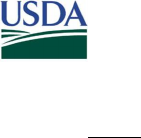
Partnerships for Climate‐Smart Commodities Data Dictionary for Recipients
February 2023
Version 1.0
Page 86 of 87
Appendix B: Commodity List
CROPS
ALFALFA
ALMONDS
AMARANTH GRAIN
APPLES
APRICOTS
ARONIA (CHOKEBERRY)
ARTICHOKES
ASPARAGUS
ATEMOYA
AVOCADOS
BAMBOO SHOOTS
BANANAS
BARLEY
BEANS
BEETS
BIRDSFOOT/TREFOIL
BLUEBERRIES
BREADFRUIT
BROCCOFLOWER
BROCCOLI
BROCCOLINI
BRUSSEL SPROUTS
BUCKWHEAT
CABBAGE
CACAO
CACTUS
CAIMITO
CALABAZA MELON
CALALOO
CAMELINA
CANARY MELON
CANARY SEED
CANEBERRIES
CANISTEL
CANOLA
CANTALOUPES
CARAMBOLA (STAR FRUIT)
CARROTS
CASHEW
CASSAVA
CAULIFLOWER
CELERIAC
CELERY
CHERIMOYA
CHERRIES
CHESTNUTS
CHICORY/RADICCHIO
CHINESE BITTER MELON
CHRISTMAS TREES
CHUFAS
CINNAMON
CLOVER
COCONUTS
COFFEE
CORN
COTTON ELS
COTTON UPLAND
CRANBERRIES
CRENSHAW MELON
CRUSTACEAN
CUCUMBERS
CURRANTS
DASHEEN
DATES
DURIAN
EGGPLANT
EINKORN
ELDERBERRIES
EMMER
FIGS
FINFISH
FLAX
FLOWERS
FORAGE SOYBEAN/SORGHUM
GAILON
GARLIC
GENIP
GINGER
GINSENG
GOOSEBERRIES
GOURDS
GRAPEFRUIT
GRAPES
GRASS
GREENS
GROUND CHERRY
GUAMABANA/SOURSOP
GUAR
GUAVA
GUAVABERRY
GUAYULE
HAZEL NUTS
HEMP
HERBS
HESPERALOE
HONEY
HONEYBERRIES
HONEYDEW
HOPS
HORSERADISH
HUCKLEBERRIES
HYBRID POPLAR TREES
IDLE
INDIGO
ISRAEL MELONS
JACK FRUIT
JERUSALEM ARTICHOKES
JICAMA
JOJOBA
JUJUBE
JUNEBERRIES
KENAF
KHORASAN
KIWIBERRY
KIWIFRUIT
KOCHIA (PROSTRATA)
KOHLRABI
KOREAN GOLDEN MELON
KUMQUATS
LAMBS EAR
LEEKS
LEMONS
LENTILS
LESPEDEZA
LETTUCE
LIMES
LONGAN
LOQUATS
LYCHEE
MANGOS
MANGOSTEEN
MAPLE SAP
MAYHAW BERRIES
MEADOWFOAM
MILKWEED
MILLET
MIXED FORAGE
MOHAIR
MOLLUSK
MORINGA
MULBERRIES
MUSHROOMS
MUSTARD
NECTARINES
NIGER SEED
NONI
OATS
OKRA
OLIVES
ONIONS
ORANGES
PAPAYA

Partnerships for Climate‐Smart Commodities Data Dictionary for Recipients
February 2023
Version 1.0
Page 87 of 87
PARSNIP
PASSION FRUITS
PAWPAW
PEACHES
PEANUTS
PEARS
PEAS
PECANS
PENNYCRESS
PEPPERS
PERENNIAL PEANUTS
PERIQUE TOBACCO
PERSIMMONS
PINE NUTS
PINEAPPLE
PISTACHIOS
PITAYA/DRAGONFRUIT
PLANTAIN
PLUMCOTS
PLUMS
POMEGRANATES
POTATOES
POTATOES SWEET
PRUNES
PSYLLIUM
PUMMELO
PUMPKINS
QUINCES
QUINOA
RADISHES
RAISINS
RAMBUTAN
RAPESEED
RHUBARB
RICE
RICE SWEET
RICE WILD
RUTABAGA
RYE
SAFFLOWER
SAPODILLA
SAPOTE
SCALLIONS
SESAME
SHALLOTS
SORGHUM
SORGHUM DUAL PURPOSE
SORGHUM FORAGE
SOYBEANS
SPELT
SQUASH
STAR GOOSEBERRY
STRAWBERRIES
SUGAR BEETS
SUGARCANE
SUNFLOWERS
SUNN HEMP
TANGELOS
TANGERINES
TANGORS
TANGOS
TANNIER
TARO
TEA
TEFF
TI
TOBACCO CIGAR WRAPPER
TOBACCO BURLEY
TOBACCO BURLEY 31V
TOBACCO CIGAR BINDER
TOBACCO CIGAR FILLER
TOBACCO CIGAR FILLER BINDER
TOBACCO DARK AIR CURED
TOBACCO FIRE CURED
TOBACCO FLUE CURED
TOBACCO MARYLAND
TOBACCO VIRGINIA FIRE CURED
TOMATILLOS
TOMATOES
TREES TIMBER
TRITICALE
TRUFFLES
TURNIPS
VETCH
WALNUTS
WAMPEE
WASABI
WATERMELON
WAX JAMBOO FRUIT
WHEAT
WILLOW SHRUB
WINTER MELON
WOLFBERRY/GOJI
YAM
LIVESTOCK
ALPACAS
BEEF COWS
BEEFALO
BUFFALO OR BISON
CHICKENS (BROILERS)
CHICKENS (LAYERS)
DAIRY COWS
DEER
DUCKS
ELK
EMUS
EQUINE
GEESE
GOATS
HONEYBEES
LLAMAS
REINDEER
SHEEP
SWINE
TURKEYS
